Early Los Angeles Historical Buildings (1900 - 1925)
Historical Photos of Early Los Angeles |
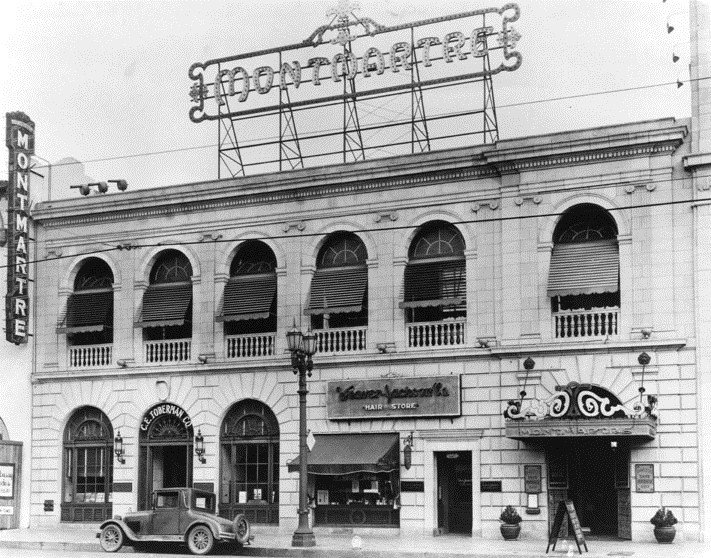 |
|
| (1924)* - The Montmartre name is on the top and the corner of the building, and over the doorway on the right. To the left are the doorways of a hair store, and of the C.E. Toberman Co. Six windows across on the second floor each have individual shade awnings. |
Historical Notes Eddie Brandstatter was one of Hollywood's greatest early restaurateurs. A native of France, he worked in Paris, London and New York restaurants before moving to Los Angeles in the 1910s. In 1923 he built the famous Cafe Montmartre, designed by Meyer and Holler, at a cost of $150,000. This establishment was described as "the center of Hollywood life", where stars usually frequented, and which was the place to see and be seen. |
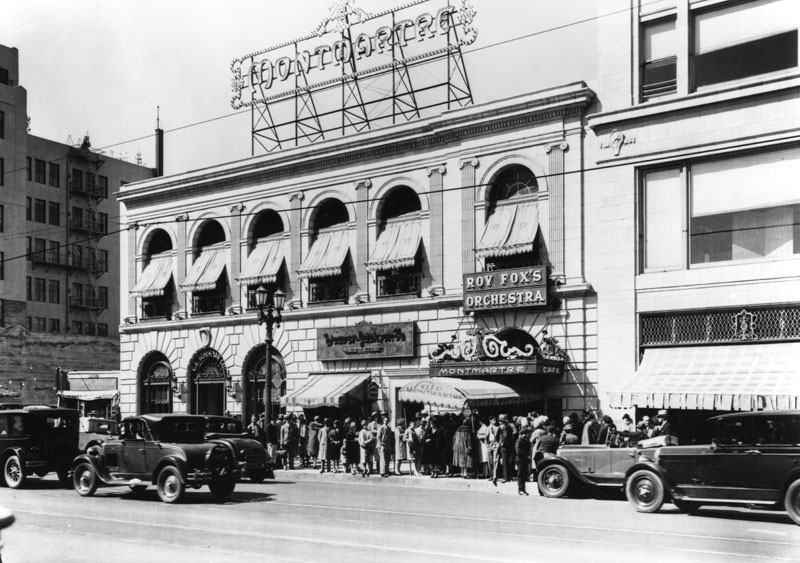 |
|
| (ca. 1928)* - Exterior view of the Montmartre Cafe, located at on Hollywood Blvd. between Highland and McCadden. It has a large lighted sign on top, and another which features Roy Fox's Orchestra. Crowds of people are waiting in line to get into the Cafe. |
Historical Notes Eddie Brandstatter was "Host of Hollywood" and catered to Hollywood stars in the 1920s and 1930s. He was owner and manager of the fashionable Montmartre Cafe, Embassy Club and Sardi's.* |
Click HERE to see more in Early Views of the Hollywood (1920 +) |
* * * * * |
Hellman Commercial Trust and Savings
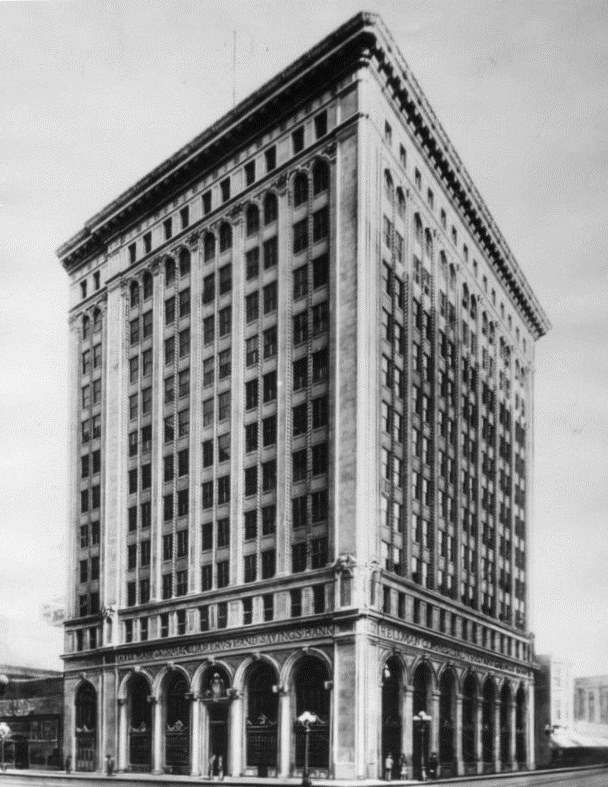 |
|
| (ca. 1924)* - Exterior view of Hellman Commercial Trust and Savings Bank in the original financial district of Los Angeles, on the northeast corner of South Spring and West 7th streets. |
Historical Notes Built in 1924, the Beaux Arts office building was designed by architects Schultze and Weaver. The bank later became the Bank of America.* |
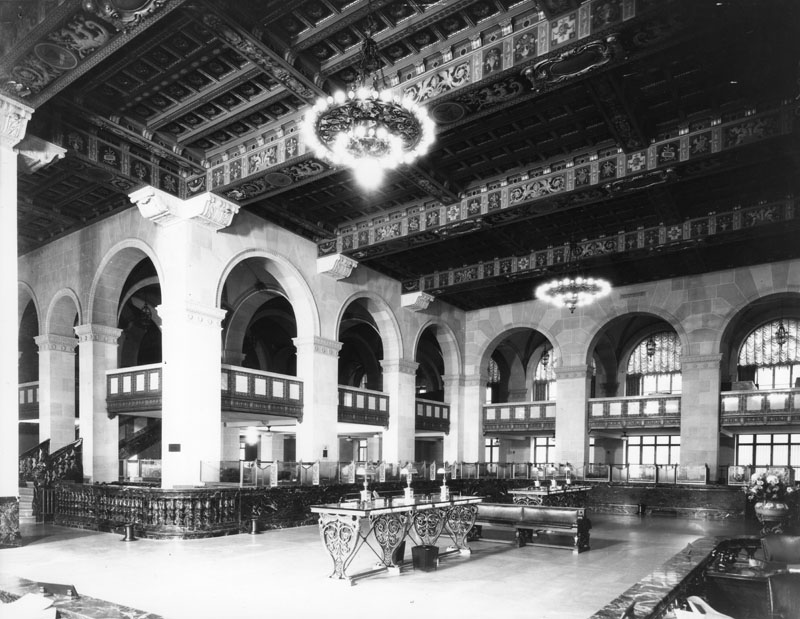 |
|
| ca. 1928)* - An interior view of the Merchants Trust and Savings Bank, located on the NE corner of So. Spring St. & W. 7th St. This was formerly the Hellman Commercial Trust & Savings, which later became Bank of America. On view here is the lobby with tables, counters and benches, with a stairway on the far left leading to the 2nd floor. The many arches emphasis the 2nd floor and the decorated ceiling with hanging chandeliers. |
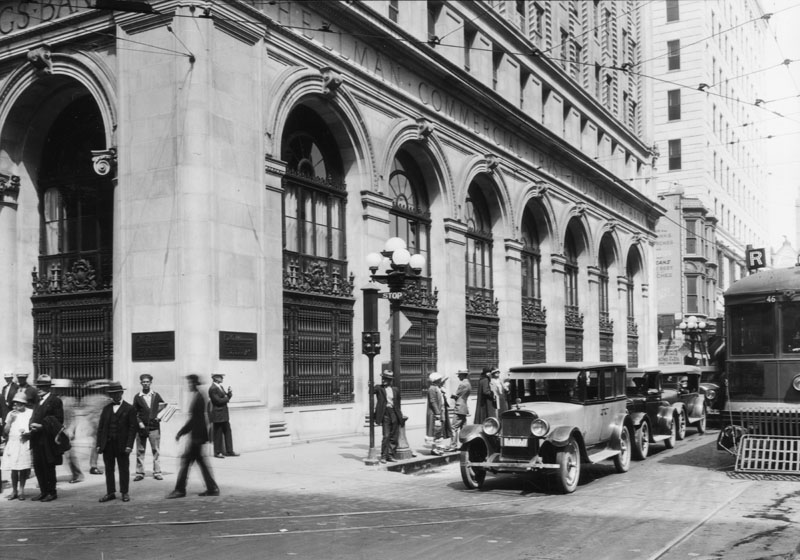 |
|
| (ca. 1924)* - Street level view of Hellman Commercial Trust and Savings Bank. The street scene shows people, cars, and a streetcar all going about their way in the busy Los Angeles' financial district. |
* * * * * |
Elks Club (Bunker Hill)
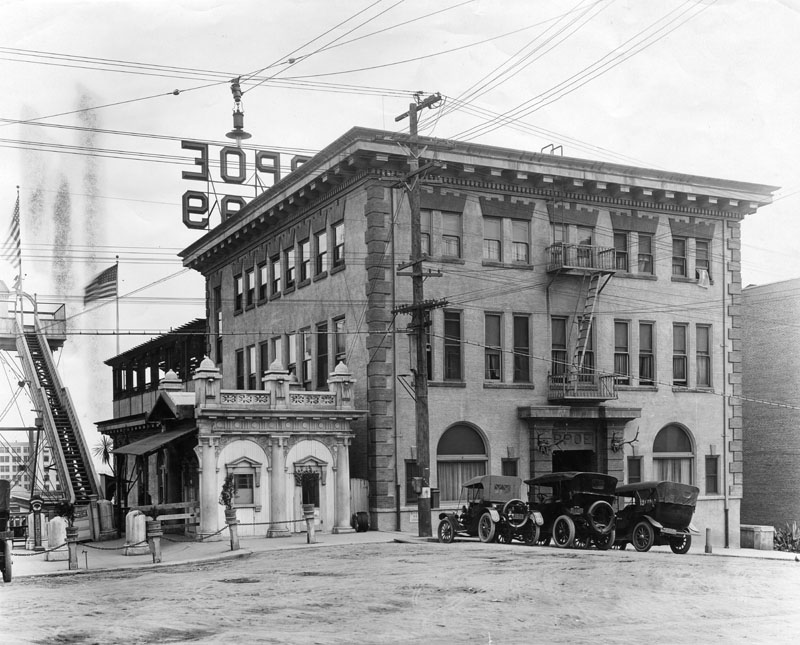 |
|
| (ca. 1920)* - The old Elks Club building on Olive and 3rd Street on Bunker Hill. The lookout tower to the left is that which overlooks Angels Flight. Elk antlers are at the entrance. |
Historical Notes The Elks had modest beginnings in 1868 as a social club (then called the "Jolly Corks") established as a private club to elude New York City laws governing the opening hours of public taverns. After the death of a member left his wife and children without income, the club took up additional service roles, rituals and a new name. Desiring to adopt "a readily identifiable creature of stature, indigenous to America," fifteen members voted 8-7 in favor of the elk above the buffalo. The name Elks is short for The Benevolent and Protective Order of Elks (BPOE; also often known as the Elks Lodge).^* In 1924, the Elks moved to a new building built for them at 607 Park View St. across from MacArthur Park (now the Park Plaza Hotel).^* |
Elks Club (MacArthur Park - today, Park Plaza Hotel)
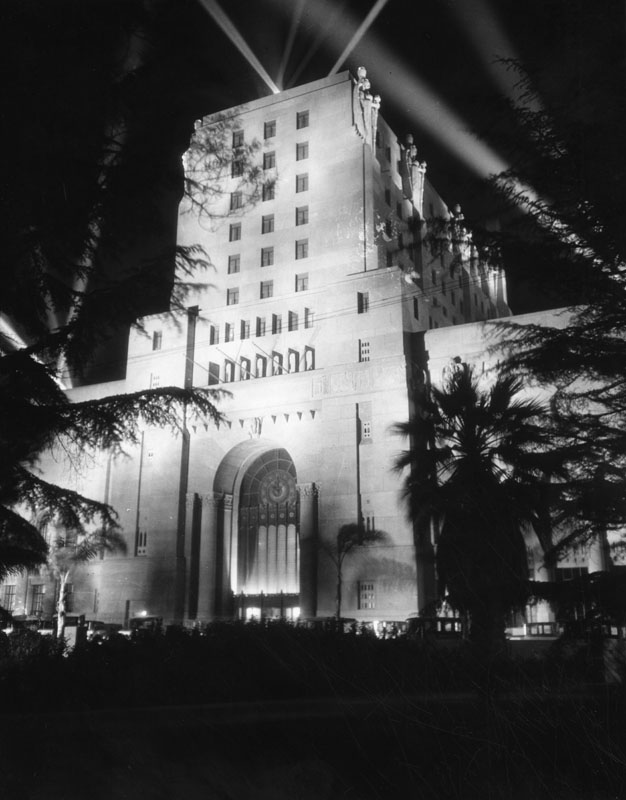 |
|
| (ca. 1924)* - Exterior view of the Elks Club building at 607 South Park View Street. Searchlights beam into the sky, illuminating the building at night. The outline of parked cars may be seen in front of the building. |
Historical Notes The Elks Club Building was originally designed for the Benevolent and Protective Order of Elks (B.P.O.E). by renowned Art Deco architect Claud Beelman, during the time he was a Senior Partner at the prestigious firm he co-owned in the 1920s, Curlett and Beelman. The building was constructed between 1923-1924.^* |
 |
|
| (1925)* - Interior view of the Lodge Room at the Elks Club on 607 South Park View Street. |
Historical Notes The elaborate interior murals and decorative paintings were designed and executed by Anthony Heinsbergen and Co, noted painter of many Los Angeles cultural landmarks. The central design of the lobby ceiling is based on the Villa Madama, a Renaissance era project by Raphael and Giulio Romano.^* |
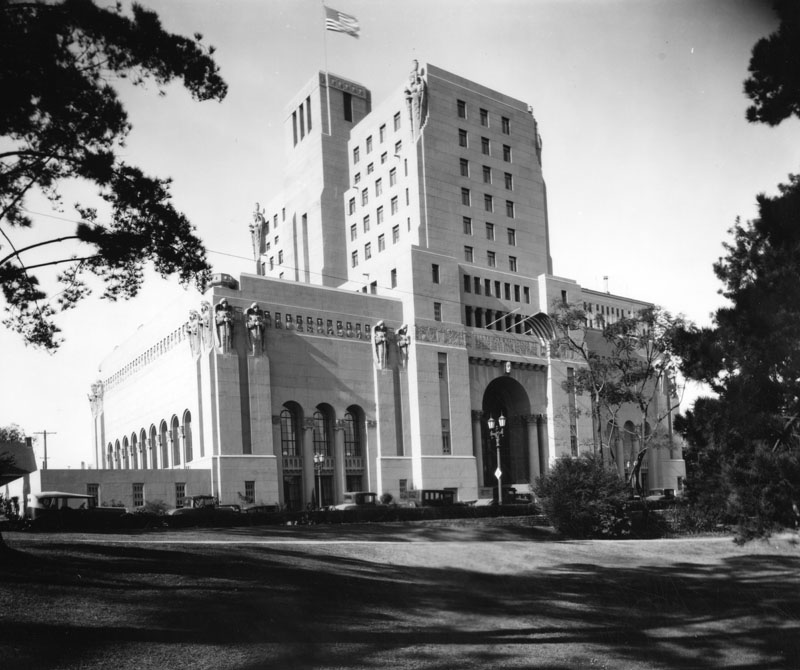 |
|
| (ca. 1924)* - Exterior view of the Elks Club as seen from the park. View shows the architectural designs and statues at the top of the building, the corners and at the very top corners of the building. |
Historical Notes Eventually, the Elks sold the building due to shrinking attendance in their ranks, and the building ended up being transformed into a luxury hotel (Park Plaza Hotel), set perfectly then on the shores of what was once a very glamorous MacArthur Park.^* |
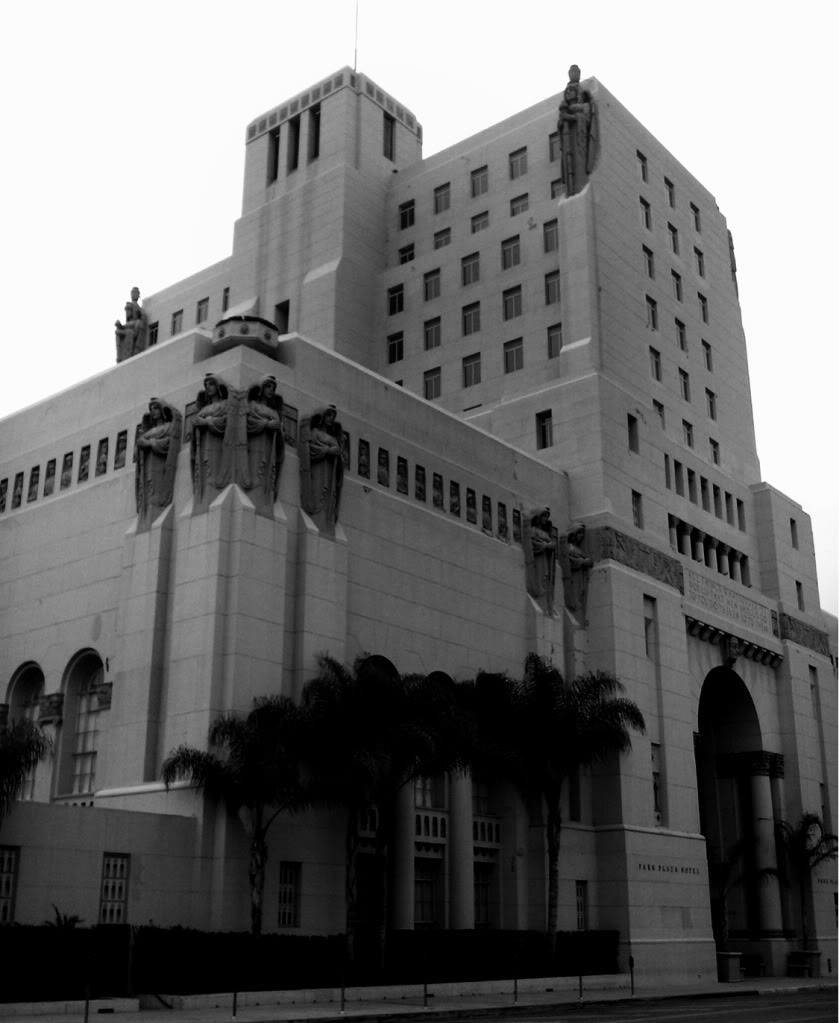 |
|
| (ca. 2011)**# - Exterior view of the Park Plaza Hotel located at 607 Park View Street just off Wilshire Boulevard. |
Historical Notes Though the neighborhood has gone through a period of urban decay and now urban renewal, the building, replete with angels at every corner, has lost none of its ethereal beauty, making it truly one of the classic examples of Beelman's architecture left standing in the modern world.^* In 1983, the Plaza Hotel Building (Elks Club Building) was designated Los Angeles Historic-Cultural Monument No. 267 (Click HERE to see complete listing). |
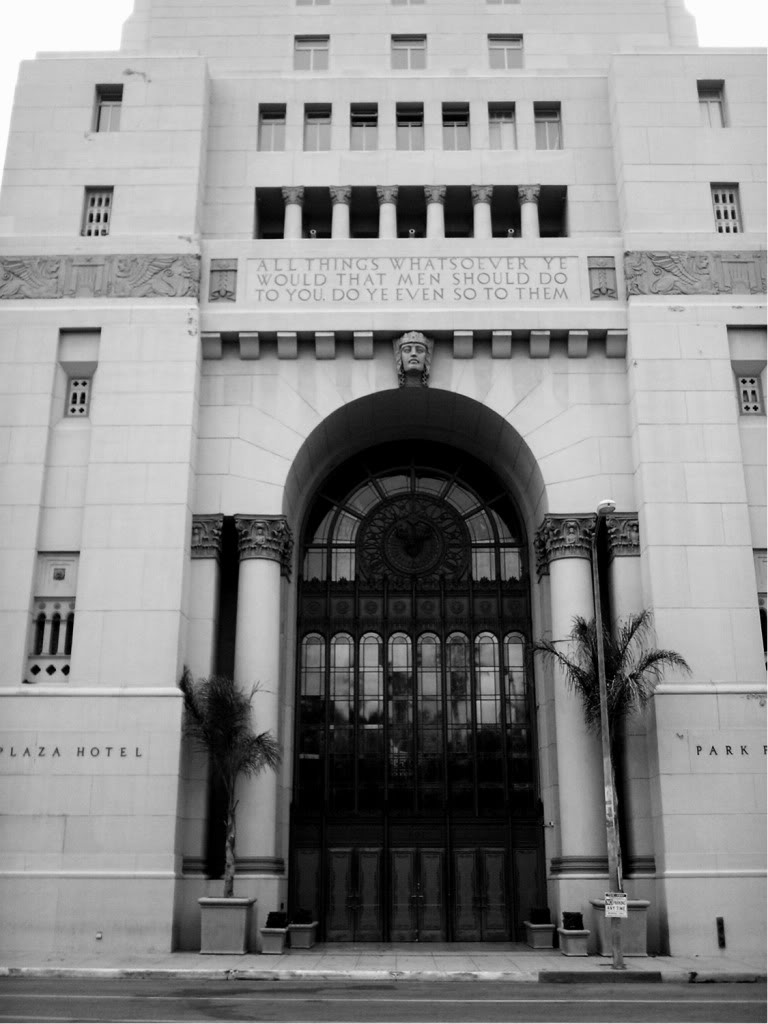 |
|
| (ca. 2011)**# - Exterior view of the grand entry to the Plaza Hotel Building. |
Historical Notes Done in the Gothic Revival architecture style (Neo-Gothic), the building still sports a brass sculpture of a set of elk antlers embedded in the clock above the grand entry to the building. The building is now vacant and is mainly used as a rental for movie shoots and special events.^* |
* * * * * |
Garden Court Apartments
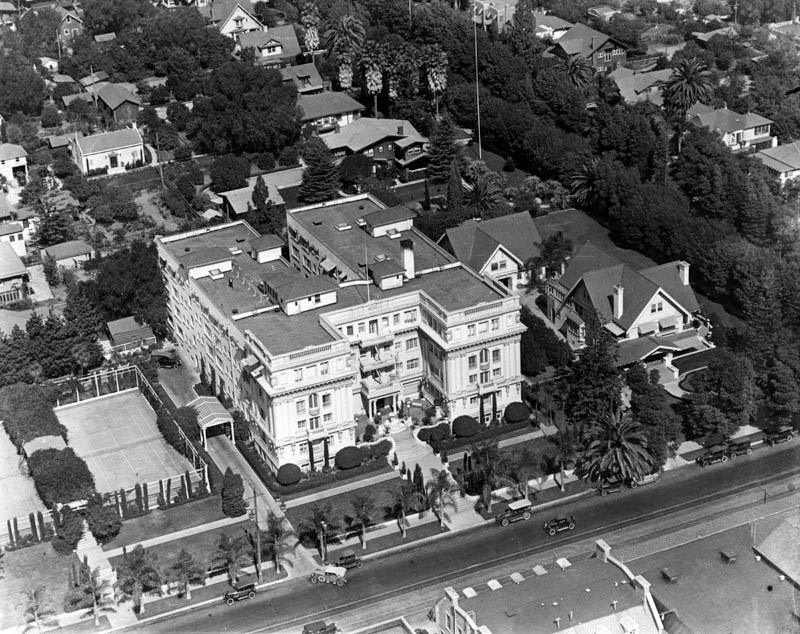 |
|
| (1924)* - Aerial view of the Garden Court Apartments located at 7021 Hollywood Blvd. |
Historical Notes Built in 1919, the Garden Court Apartments were designed by architect Frank S. Meline in Beaux Arts style. They were built to accommodate the movie industry.* |
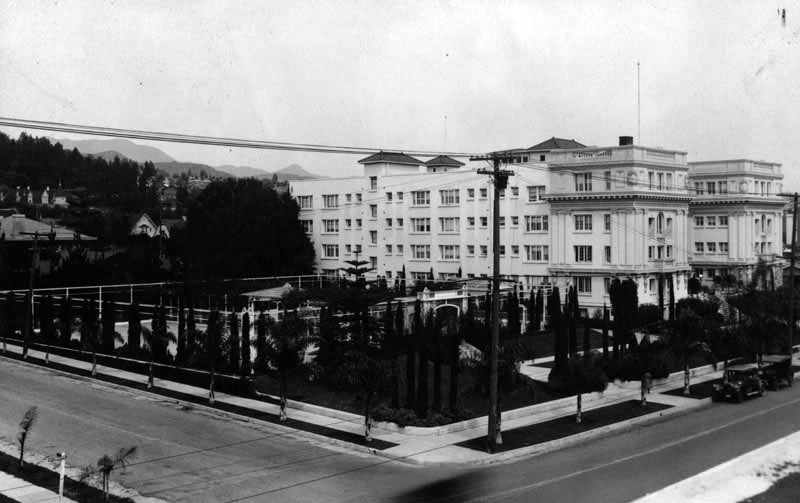 |
|
| (ca. 1934)* - View of the northeast corner of Sycamore Avenue and Hollywood Boulevard showing the western side of the Garden Court Apartments. |
Historical Notes The Garden Court Apartments was the home of a number of celebrities in the first forty or so years of its existence, including Clara Bow, Louis B. Mayer and Mack Sennett.*^ |
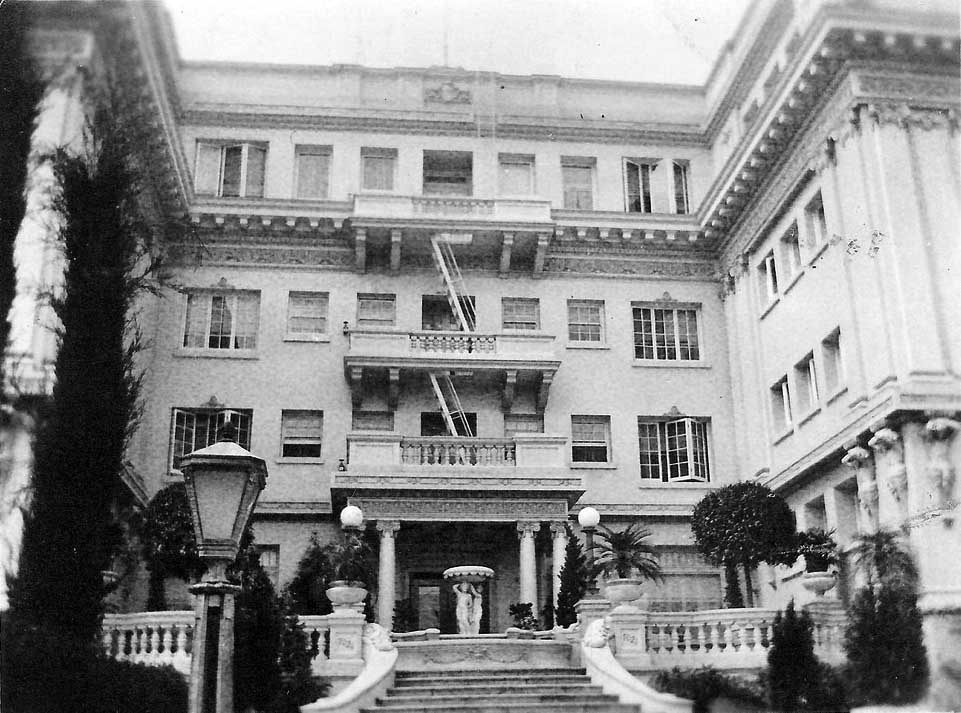 |
|
| (n.d.)**# - View of the front entrance to the Garden Court Apartments. A beautiful staircase leads to a fountain containing two figures holding up a bowl. |
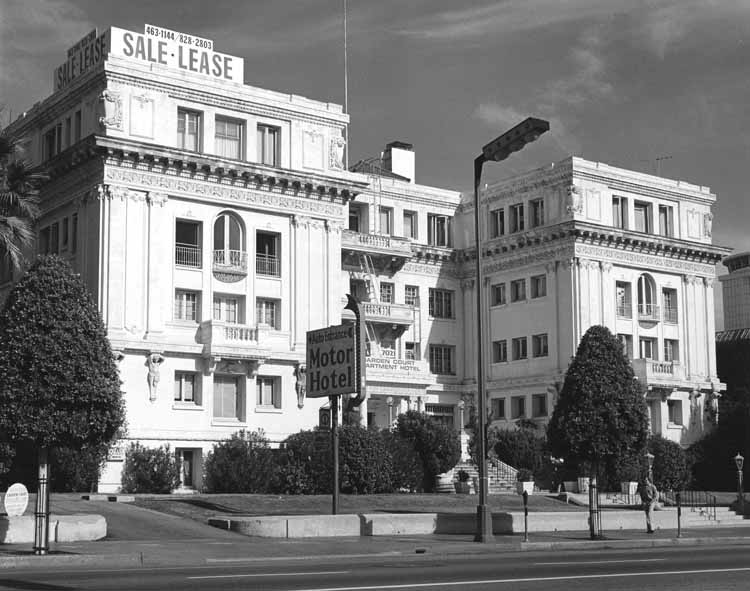 |
|
| (1976)^*# - View of the Garden Court Apartments (Hotel) on Hollywood Blvd. Sign in front of building reads Motor Hotel. |
Historical Notes The Garden Court Apartments’ fortunes declined in the 1960s and 1970s along with those of Hollywood Boulevard in general. After being vacated in 1980, it was inhabited by homeless squatters and nicknamed "Hotel Hell". The building was noted in the National Register of Historic Places in 1982, however, that did not prevent it from being razed in 1984.*^ |
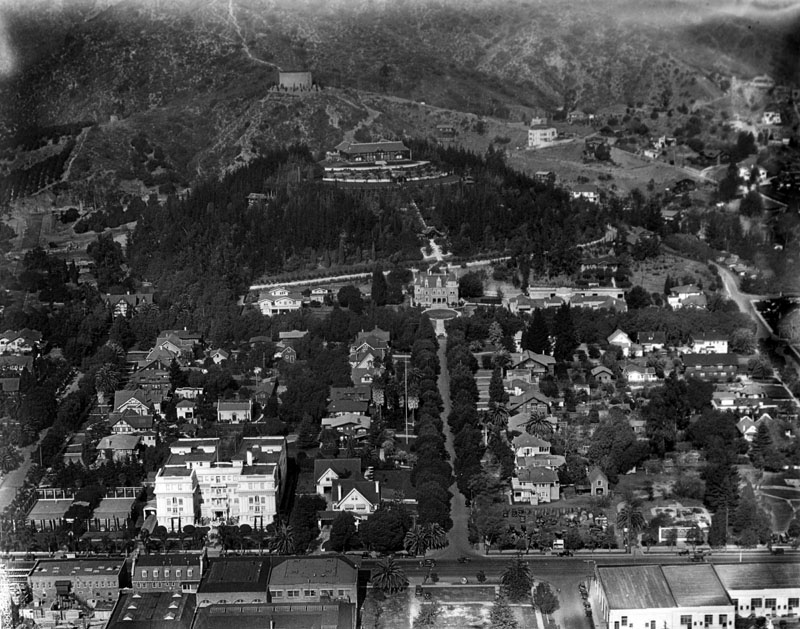 |
|
| (ca. 1924)* - View of the Garden Court Apartments on Hollywood Blvd. (foreground) and the residential neighborhood behind it, including the hilltop Japanese estate and gardens of brothers Charles and Adolph Bernheimer, located at 1999 N. Sycamore Avenue. |
Historical Notes This 1914 hilltop estate was built to house the Bernheimers' priceless collection of Asian treasures. In order to have an authentic Japanese design, hundreds of skilled craftsmen were brought from Asia to recreate an exact replica of a palace located in the Yamashiro mountains near Kyoto, Japan.* |
Bernheimer Japanese Palace
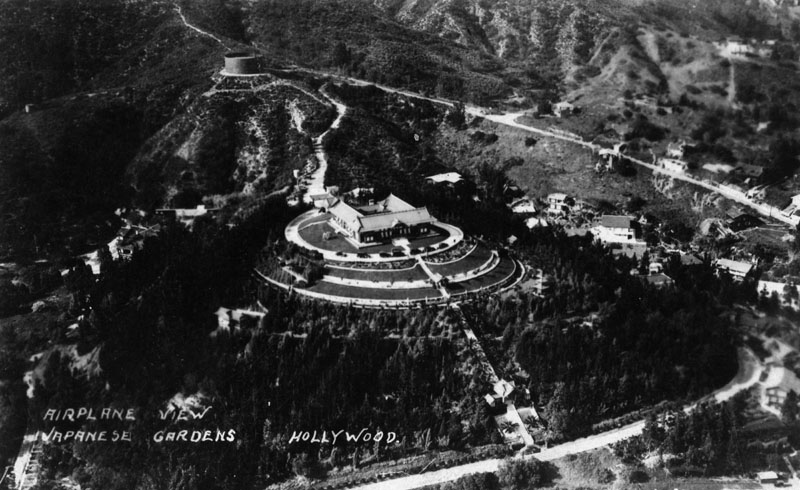 |
|
| (ca. 1924)* - Aerial postcard view of the Japanese estate and gardens of brothers Charles and Adolph Bernheimer located in the Hollywood Hills. |
Historical Notes In an act of bad timing, Adolph Bernheimer, a multi-millionaire silk importer, and his brother built a replica of a Japanese palace and garden on a hill overlooking Hollywood. Not only was the Bernheimer’s Teutonic name very suspicious, but so was their fluency in foreign languages. The new home’s large concrete retaining walls led some locals to suspect an armory or wireless station in the bowels. Under constant observation from a group of patriotic citizens, the brothers pacified neighbors by buying a $5,000 war bond. They spent little time in Hollywood after that.*### |
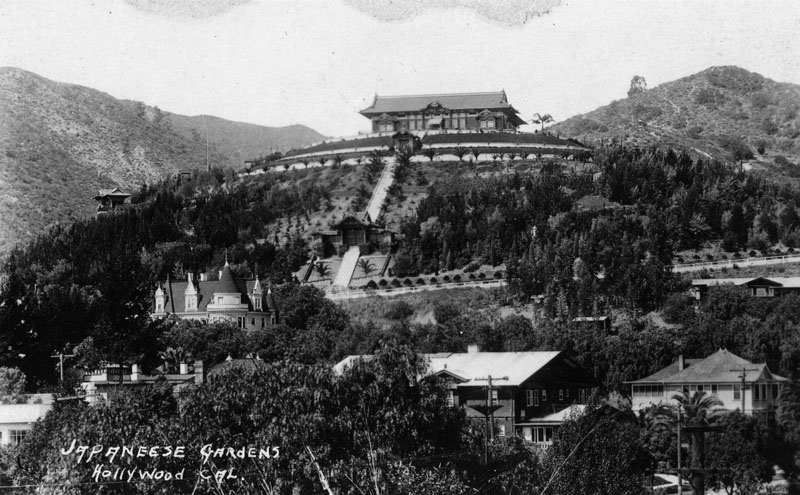 |
|
| (ca. 1920s)* - Postcard view of the hilltop Japanese estate and gardens of brothers Charles and Adolph Bernheimer. |
Historical Notes The hillside terraces included 30,000 varieties of trees, shrubs, waterfalls, hundreds of goldfish, and even exotic birds and monkeys.* |
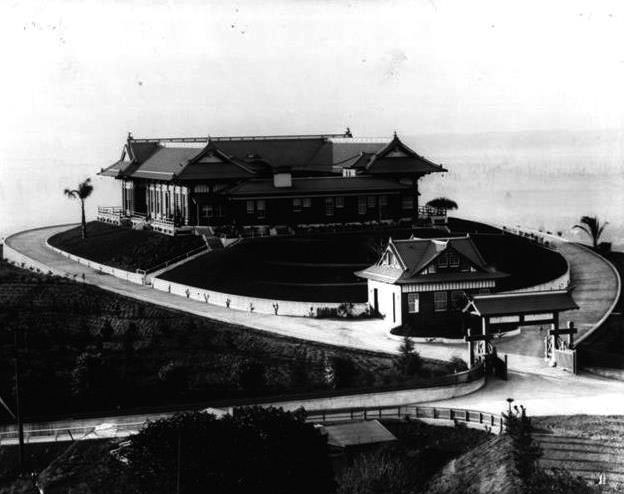 |
|
| (1914)**^# - Close-up view of the Bernheimer Brother's Japanese Palace the year it was built. |
Historical Notes The original Bernheimer structure included a 10-room teak and cedar mansion, where carved rafters were lacquered in gold and tipped with bronze dragons.* |
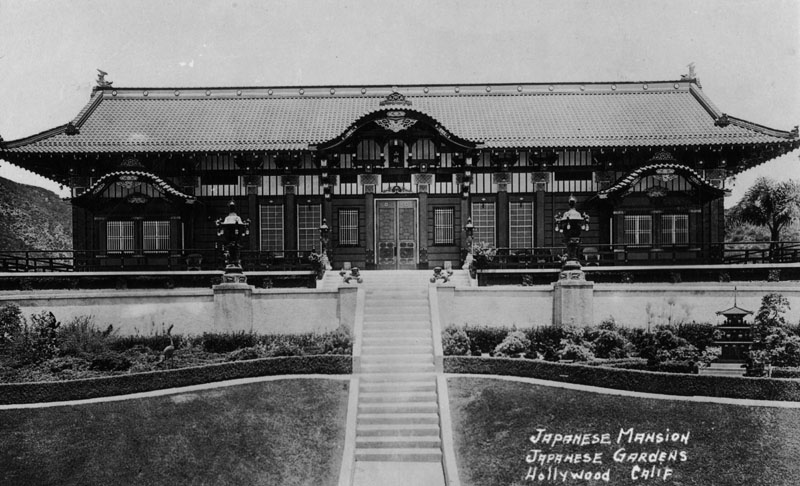 |
|
| (ca. 1920s)* - Front view of the Japanese estate and gardens of brothers Charles and Adolph Bernheimer. |
Historical Notes After the death of one of the brothers in 1922, the art collections were auctioned off. A few years later, the estate served as headquarters for the exclusive Hollywood "400 Club," an organization for the elite of the motion picture industry. After WWII, the home was remodeled and converted into apartments. Soon thereafter, Thomas O. Glover purchased the property and began the restoration of what was to become the Yamashiro restaurant.* |
* * * * * |
Hollywood Athletic Club
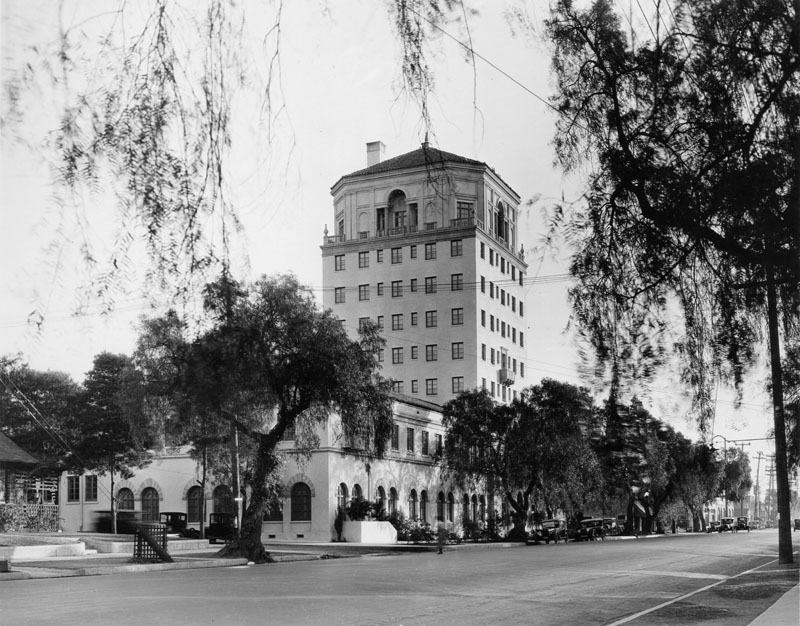 |
|
| (ca. 1925)* - Exterior corner view of the Hollywood Athletic Club building, with 1920s-era cars on the street. |
Historical Notes The Hollywood Athletic Club was built in 1924 by Meyer & Holler, the same architectural firm that built the Grauman's Chinese Theatre and the Egyptian Theatre. At the time is was the tallest building in Hollywood. The building at 6525 Sunset Blvd has been known as the Hollywood Athletic Club, University of Judaism, Berwin Entertainment Complex, and Hollywood Landmark.^* |
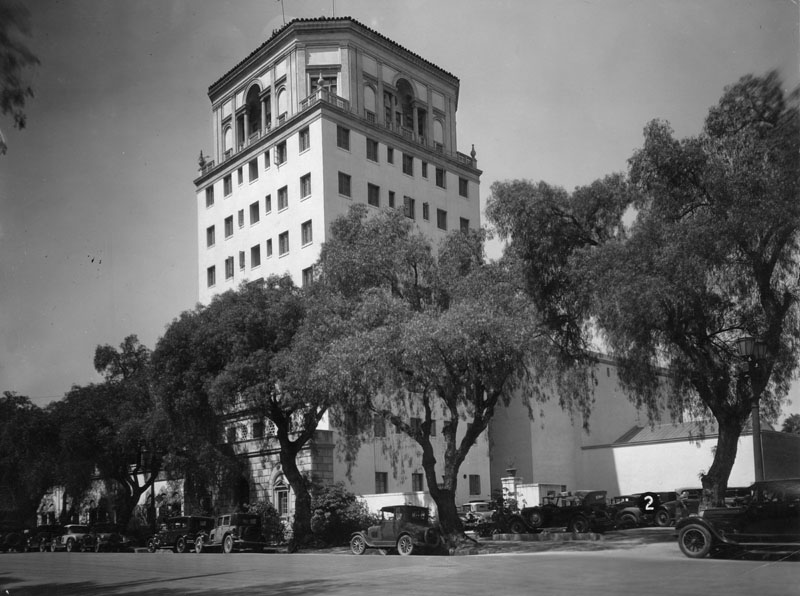 |
|
| (1929)* - Street view of the Hollywood Athletic Club, located at 6525 Sunset Blvd.^* |
Historical Notes When the Hollywood Athletic Club was first built in 1924, Hollywood was entering its greatest and most productive period. The building was the tallest building in Hollywood and loomed above Sunset Boulevard. Membership was originally $150 for initiation fees and $10 for monthly dues. During its early years as a health club, its membership included Johnny Weissmuller, Errol Flynn, Charlie Chaplin, John Wayne, Walt Disney, John Ford, Douglas Fairbanks Sr., Mary Pickford, Cecil B de Mille, Cornel Wilde, Humphrey Bogart, Clark Gable, Jean Harlow, Frances X. Bushman, Howard Hughes, Joan Crawford and Rudolph Valentino, Mae West, Walt Disney, and Buster Crabbe.^* |
Click HERE to see more in Early Views of Hollywood (1920 +) |
* * * * * |
Women's Athletic Club
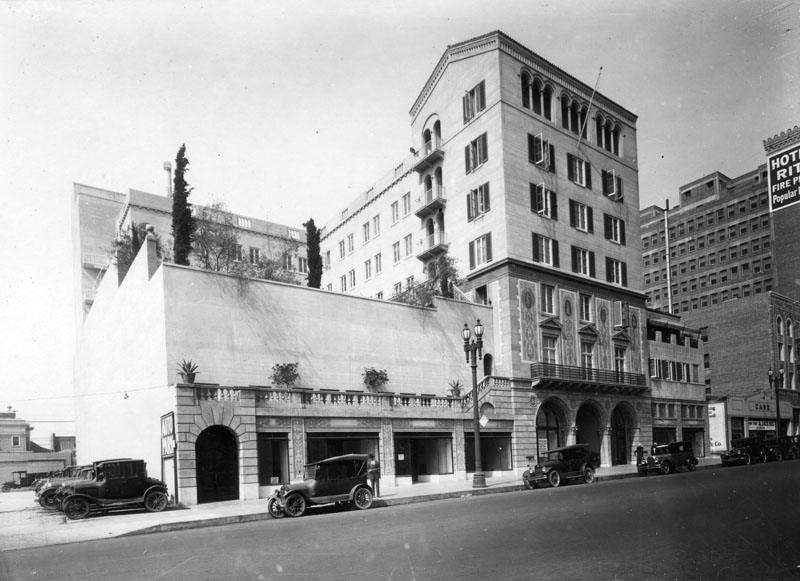 |
|
| (1925)* - Exterior view of the Women's Athletic Club of Los Angeles at 829 South Flower Street on October 9, 1925. On the right is the Hotel Ritz. |
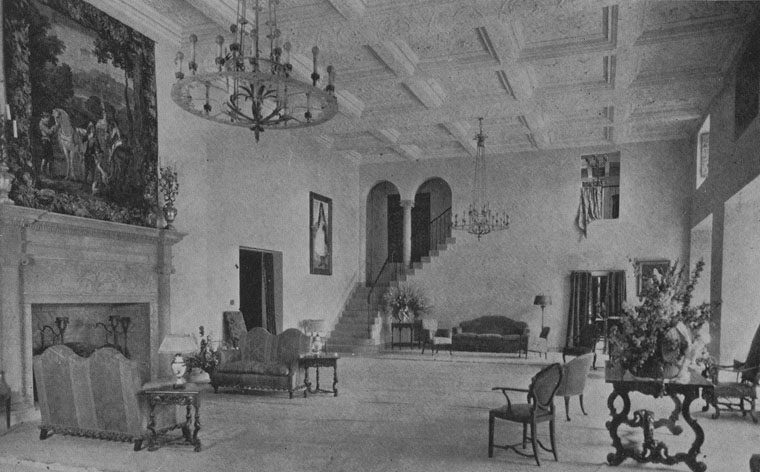 |
|
| (ca. 1925)* - Interior view on a postcard of the Women's Athletic Club of Los Angeles at 829 South Flower Street, showing the living room. |
* * * * * |
Hotel Cecil
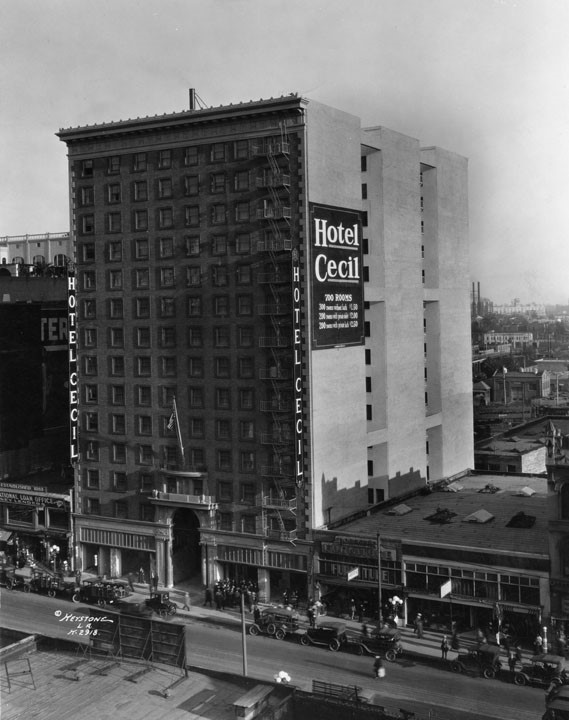 |
|
| (ca. 1924)* - View showing the Hotel Cecil located at 640 S. Main Street as seen from a roof across the street. It is the tallest building (approx. 15 stories) in the neighborhood, and advertises 700 rooms. |
Historical Notes The Cecil was constructed in 1924 by hotelier William Banks Hanner, as a destination for business travelers and tourists. Designed by Loy Lester Smith in the Beaux Arts style, the hotel cost $1 million to complete and boasted an opulent marble lobby with stained-glass windows, potted palms and alabaster statuary. Hanner had invested confidently in the enterprise, in the knowledge that several similar hotels had been established elsewhere downtown, but within five years of its opening, the United States sank into the Great Depression.^* |
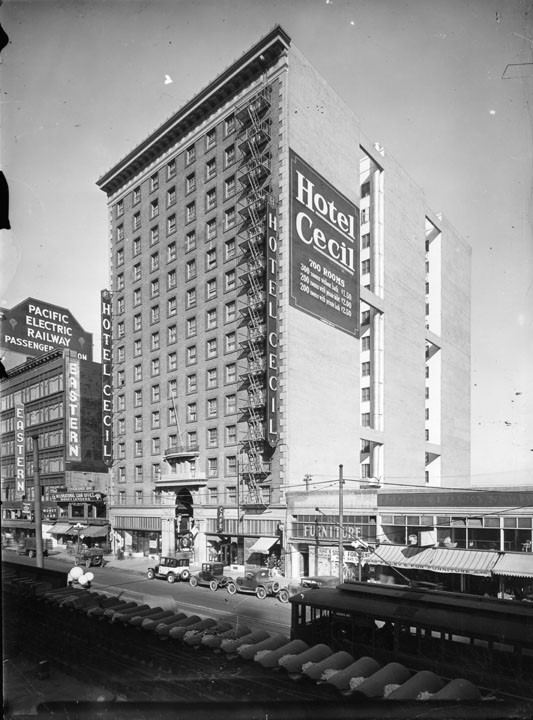 |
|
| (ca. 1924)* - Lower-level view of the Hotel Cecil. Down the street is the Pacific Electric Building, while on the street a streetcar passes cars parked along the curb. |
Historical Notes Though the hotel flourished as a fashionable destination through the 1940s, the decades beyond saw the hotel decline, as the nearby area known as Skid Row became increasingly populated with transients. As many as 10,000 homeless people lived within a four-mile radius. By the 1950s the hotel had gained a reputation as a residence for transients. A portion of the hotel was refurbished in 2007 after new owners took over. In the 1980s the hotel was rumored to be the residence of serial killer Richard Ramirez, nicknamed the "Night Stalker." Ramirez had been a regular presence on the skid row area of Los Angeles, but, according to a hotel clerk who claims to have spoken to him, is rumored to have stayed at the Cecil for a few weeks. Ramirez may have engaged in part of his killing spree while staying there. Another serial killer, Austrian Jack Unterweger, stayed at the Cecil in 1991, possibly as an homage to Ramirez. While there, he strangled and killed at least three prostitutes, for which he was convicted in Austria. He hanged himself shortly after his conviction.^* |
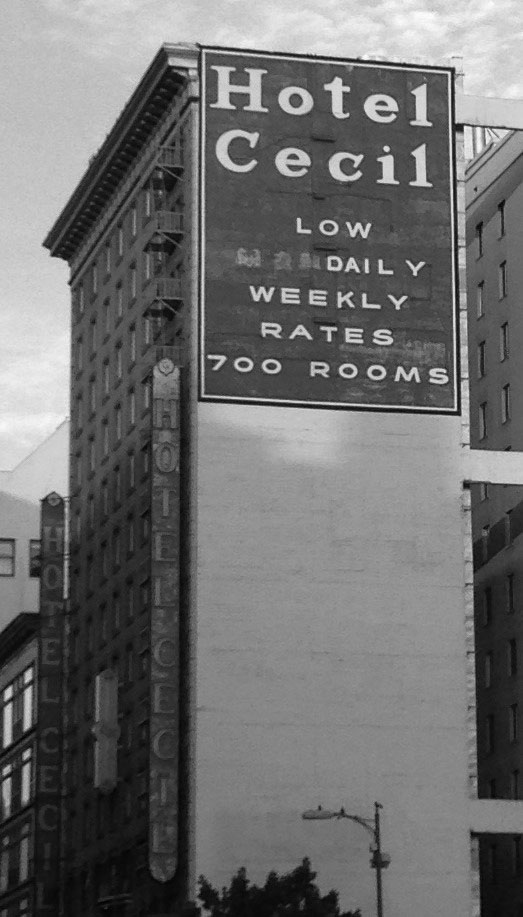 |
|
| (2013)^* - Looking up toward the top of the 700-room Hotel Cecil. |
Historical Notes The hotel was sold in 2014 to New York City hotelier Richard Born for $30 million, and another New York-based firm, Simon Baron Development, acquired a 99-year ground lease on the property. Matt Baron, president of Simon Baron, said he was committed to the preservation of architecturally or historically significant components such as the hotel's grand lobby, but that his company planned to completely redevelop the interior and fix the "hodgepodge" work that had been done in more recent years. Beyond renovating rooms, the developer also plans a rooftop pool, gym and lounge. Construction is projected to be complete by 2019.^* |
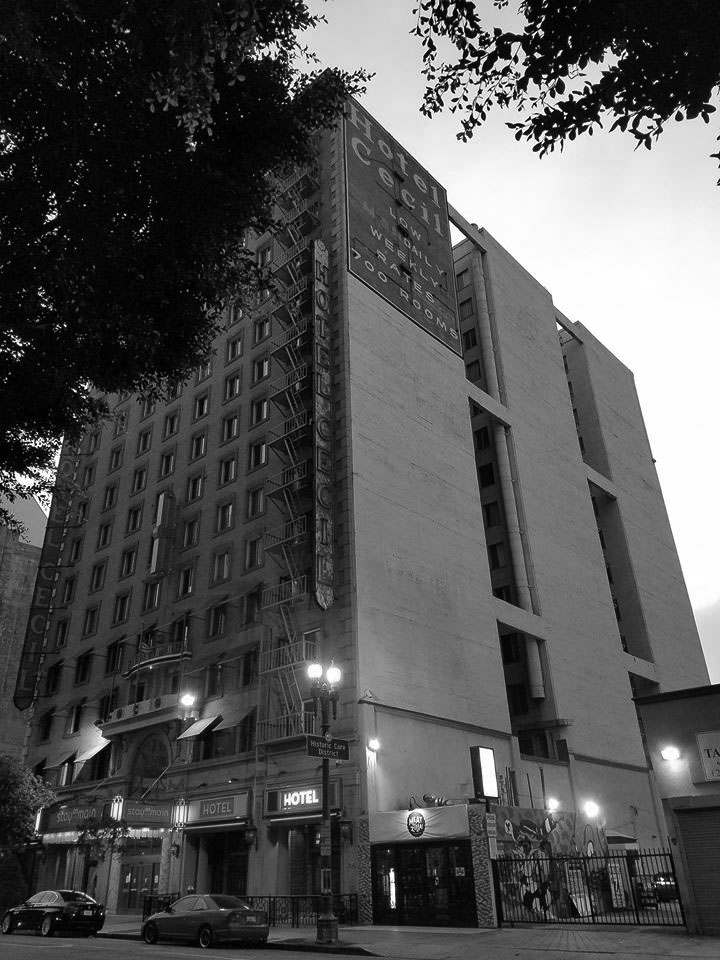 |
|
| (2017)^.^ - Looking up toward the top of Hotel Cecil. Photo courtesy of James J. Chun. |
Historical Notes In February 2017 the Los Angeles City Council voted to deem the Cecil a historic-cultural monument (No. 1117), because it is representative of an early 20th century American hotel, and because of the historic significance of its architect's body of work.^* |
 |
|
| (2022)* – Cecil Hotel – Photo by Carlos G. Lucero |
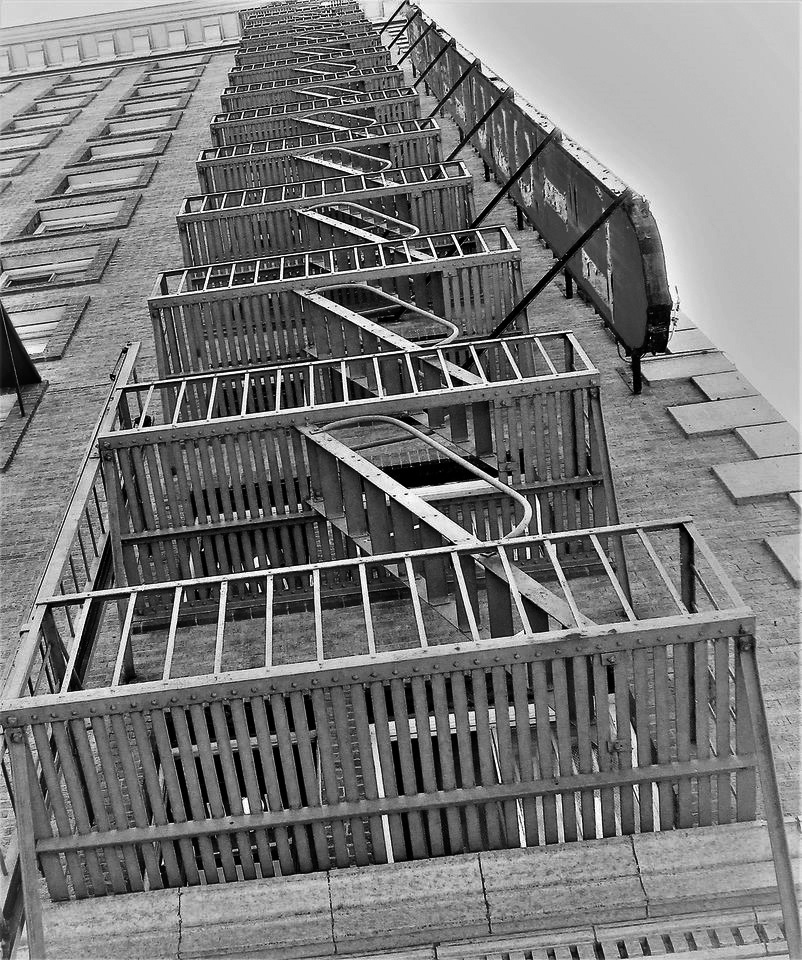 |
|
| (2020)^.^ - Fire escape ladders rise to top of Hotel Cecil alongside large building sign. Howard Gray |
Historical Notes Fire Escapes date back to the turn of the 20th century, when fire safety became a major concern and building owners were required by law to provide fire escape routes in their new property. The fire escape invention seemed to be a simple and cost-efficient way to address this requirement. As far as a patented fire escape, the first credited person for such an invention was Anna Connelly in 1887. She invented the exterior staircase, used specifically for a fire escape. Many companies saw advantages to using this system and decided to incorporate that patent into their own buildings. These exterior staircases were cheap to build and could be added to the existing construction very easily, without the need to restructure the walls.* |
\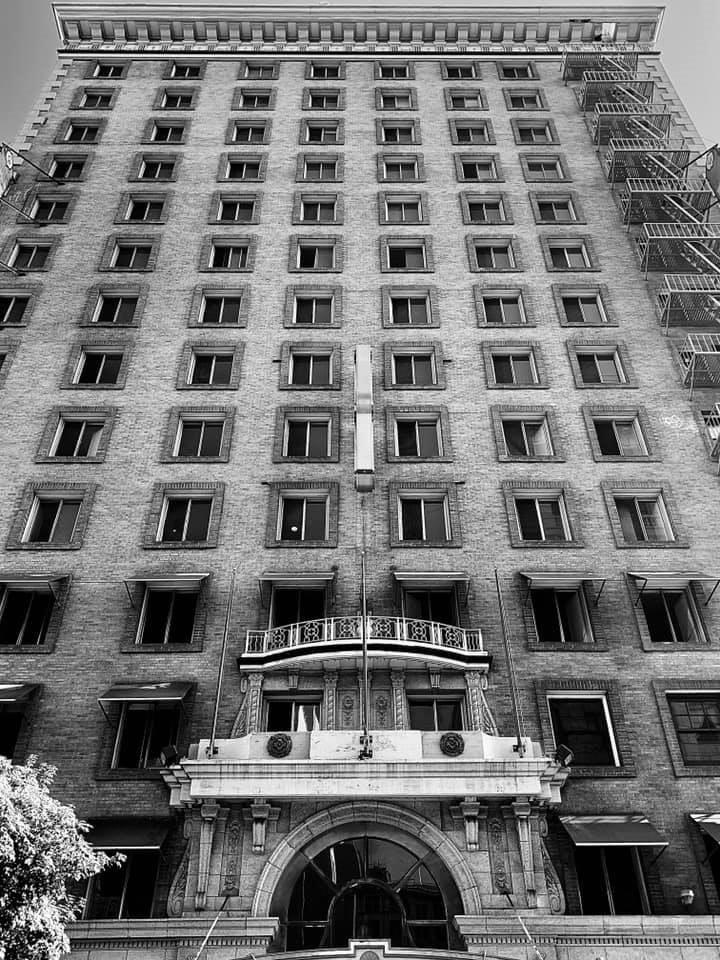 |
|
| (2021)^.^ - Front view of the Cecil Hotel, Historical-Cultural Monument No. 1140. Photo by Gilbert Jimenez |
* * * * * |
Hollingsworth Building and the Continental Hotel
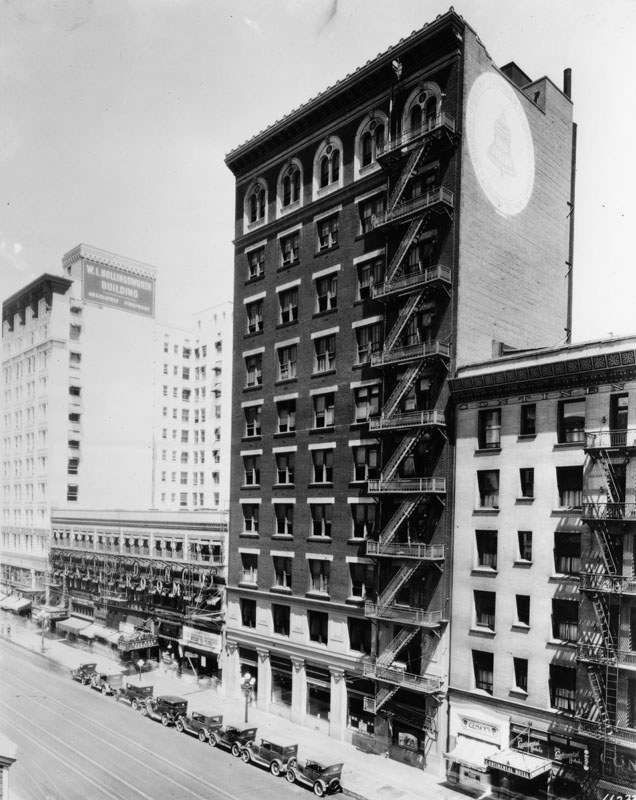 |
|
| (ca. 1925)* - View of buildings on the east side of Hill at 6th. On the left is the Hollingsworth Building with its ad of "absolutely fireproof" painted on the side. Next to it is Palais de Dance, a dance studio for ballroom, completed in 1925 at a cost of $800,000. The site was formerly occupied by the Rendezvous Cafe. On the far right is the Continental Hotel. |
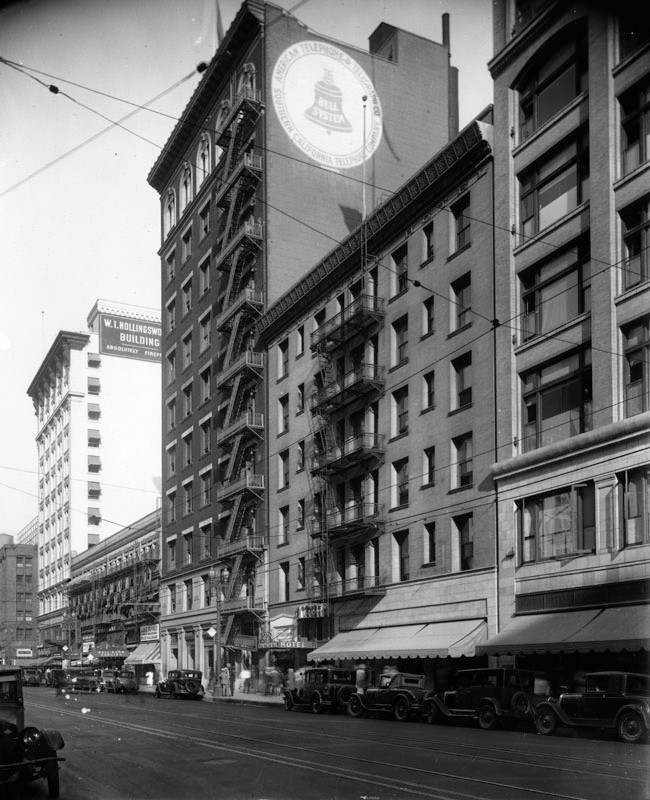 |
|
| (ca. 1925)* - Street view of Hill Street near 6th Street showing the Continental Hotel (center) and the Hollingsworth Building in the distance (left). The tall building at center is the AT&T Building with 'Bell System' written on its side. |
* * * * * |
Wrigley Field
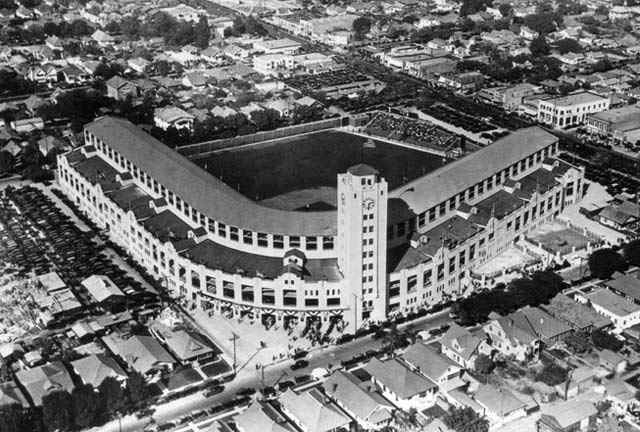 |
|
| (1925)* - Aerial view of Wrigley Field, Opening Day, September 29, 1925. |
Historical Notes For 33 seasons (1925-1957) Wrigley Field was home to the Angels, and for 11 of those seasons (1926-1935 and 1938) it had a second home team in the rival Hollywood Stars. The Stars eventually moved to their own new ballpark, Gilmore Field. Prior to 1925, the Angels played at their former home at Washington Park, and before that, at Chutes Park.* |
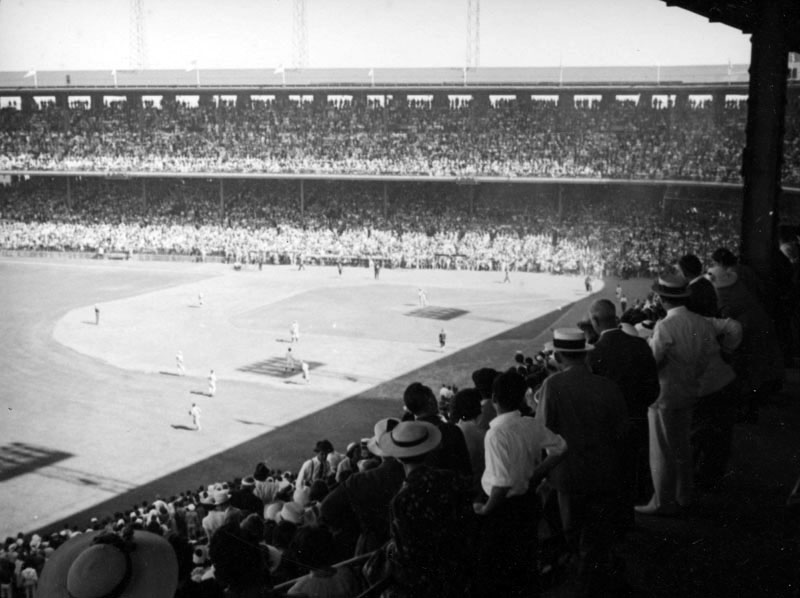 |
|
| (Early 1930s)* - Partial view of the "first" Wrigley Field - home for the Los Angeles Angels of the Pacific Coast League. The bleachers are practically bursting at the seams with eager spectators cheering on their favorite teams. |
Click HERE to see more Baseball in Early LA |
* * * * * |
Grand Olympic Auditorium
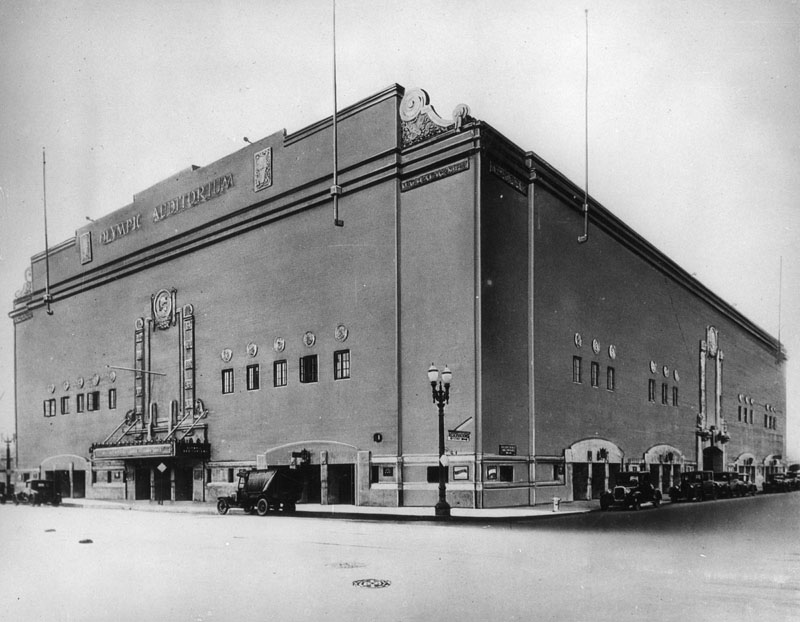 |
|
| (ca. 1925)* - View looking at the southwest corner of S. Grand Avenue and W. 18th Street showing the newly constructed Grand Olympic Auditorium. Architect G.S. Underwood |
Historical Notes The Grand Olympic Auditorium was built in 1924 by Jack Doyle, with the help of the Los Angeles Olympic committee for the 1932 Games. The grand opening of the Auditorium was on August 5, 1925, and was a major media event, attended by such celebrities as Jack Dempsey and Rudolph Valentino.*# |
 |
|
| (1932)* – Wide angle view of the Grand Olympic Auditorium filled to capacity. Spectators await the start of the Olympic wrestling competitions to be held on dual platforms in the center of auditorium. |
Historical Notes The Olympic Auditorium was leased by the 1932 Olympic organizing Committee for a very nominal sum sufficient to cover expenses, for the purpose of conducting the training and competitions of the boxing, wrestling and weightlifting events of the Games. At the time it was the largest indoor venue in the U.S., originally seating 15,300.^* |
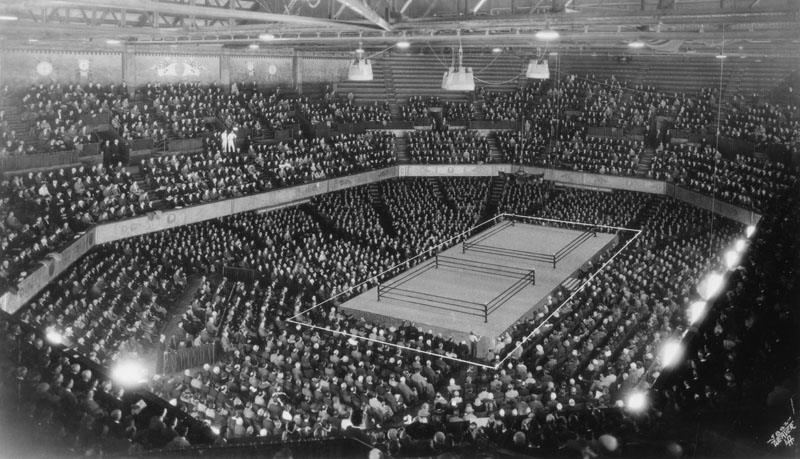 |
|
| (1932)* - Spectators have nearly filled the Olympic Auditorium to watch boxing, one of three events held at the venue during the 1932 Olympic Games. |
Historical Notes The building was the site of the boxing and Greco-Roman wrestling competitions for the Games. American Edward Flynn won the welterweight gold medal in boxing.*# |
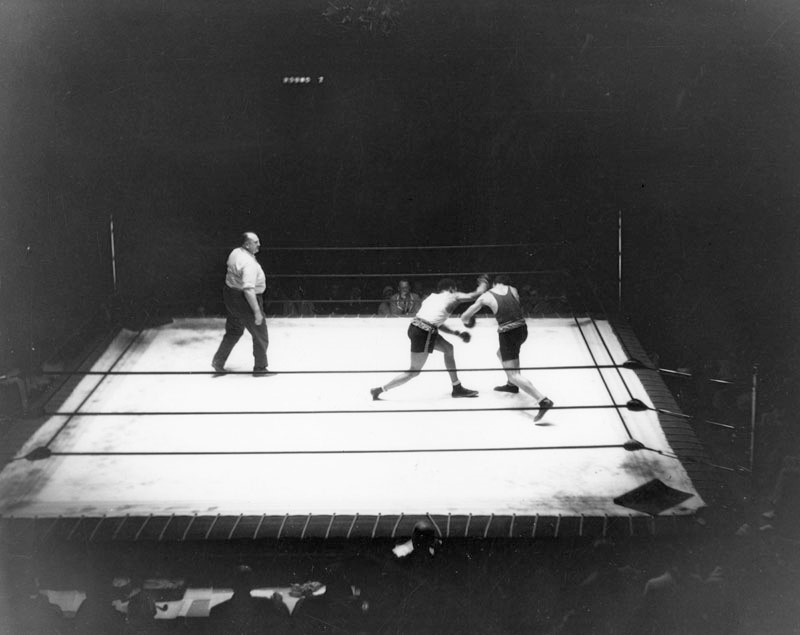 |
|
| (1932)* – Canada's gold medalist in boxing was Horace "Lefty" Gwynne who survived a fierce battle against Germany's Hans Ziglarski (right) in the bantamweight final during the 1932 Olympic Games. |
Historical Notes The 1932 Summer Olympics was celebrated in Los Angeles. No other cities made a bid to host these Olympics. Held during the worldwide Great Depression, many nations and athletes were unable to pay for the trip to Los Angeles. Fewer than half the participants of the 1928 Summer Olympics in Amsterdam returned to compete in 1932. Even U.S. President Herbert Hoover skipped the event.^* |
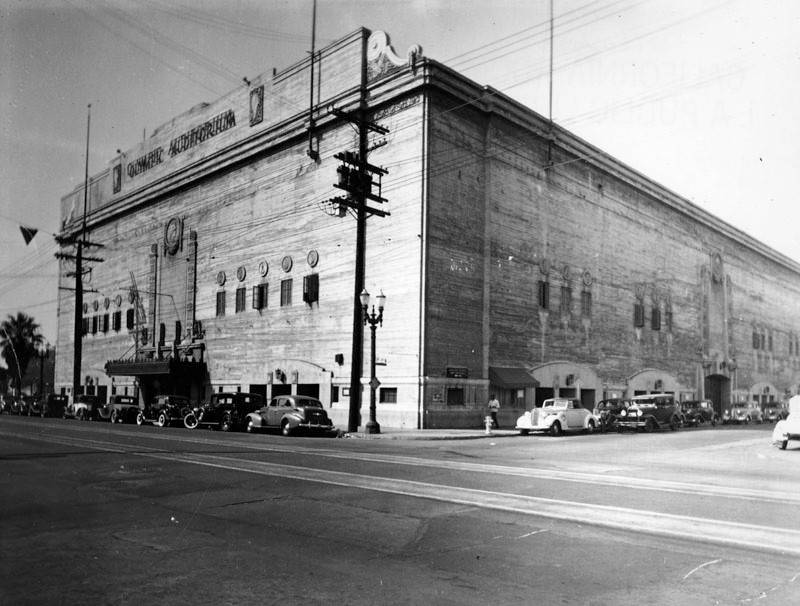 |
|
| (1938)* - View showing the Olympic Auditorium located at 1801 S. Grand Avenue. |
Historical Notes Throughout the 1930s, 1940s and 1950s it was home to some of the biggest boxing, wrestling and roller derby events and has become somewhat of a landmark for boxing history.^* |
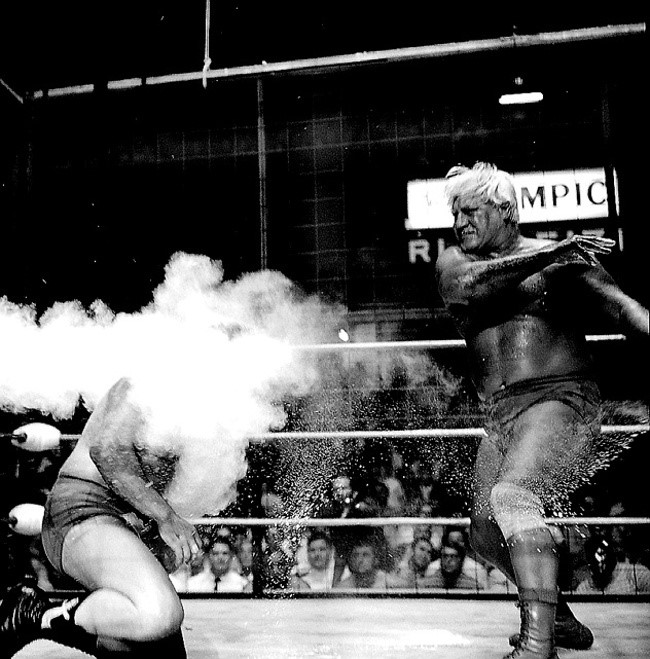 |
|
| (ca. 1970)^^+ - Freddie Blassie, Olympic Auditorium. Photo by Theo Ehret |
Historical Notes The 1960s and 1970s were a major boom period for the Olympic, as major wrestling events were held at the arena every other Friday night, as well as being the home to the Roller Games Los Angeles T-Birds. Wrestling legends such as Freddie Blassie, John Tolos, Buddy Roberts (as Dale Valentine), The Sheik, Fritz Von Erich, Gorgeous George, The Great Goliath, Black Gordman, Bobo Brazil, Buddy Rogers, Roddy Piper and Chris Adams competed in the arena at one point in their careers, along with the legendary Lou Thesz, Mil Mascaras and André the Giant.^* |
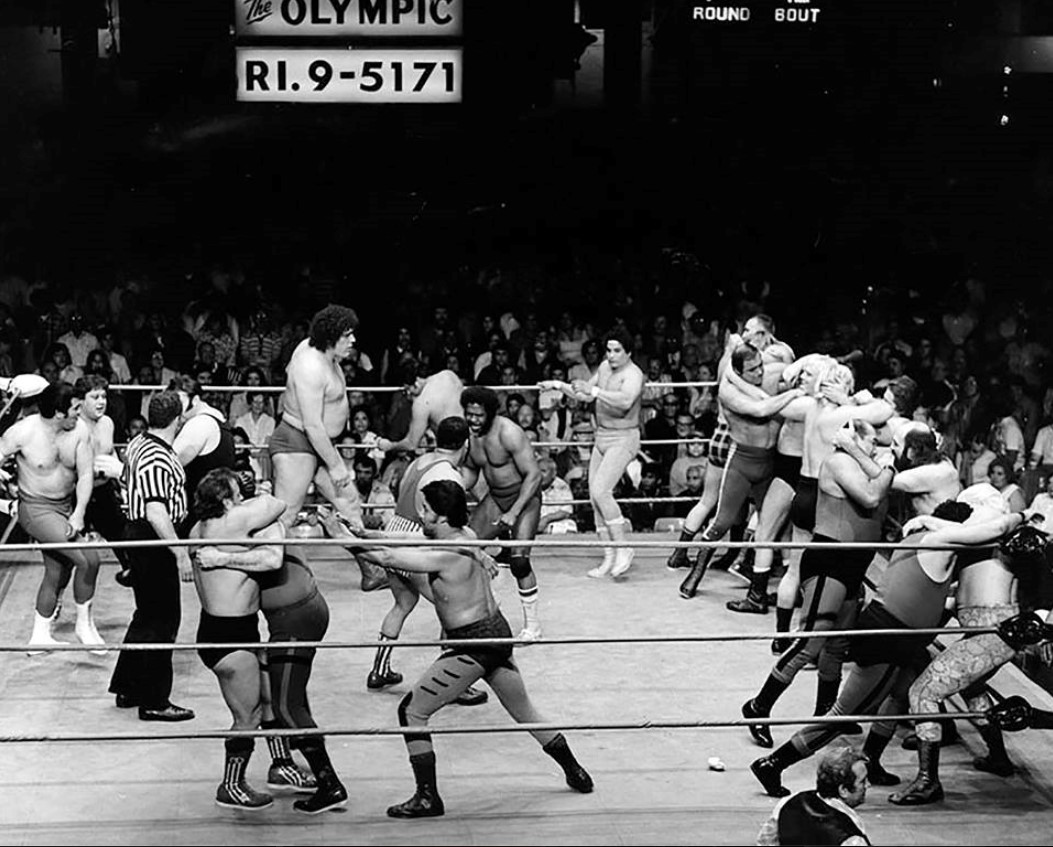 |
|
| (1976)^*^# - Andre the Giant, Roddy Piper, Porkchop Cash and approximately 17 other well-known Los Angeles wrestlers are competing for a $30,000 cash prize at the Olympic Auditorium in May of 1976 in an event called the Battle Royal. |
Historical Notes In January 1970, the Olympic began its annual 22-wrestlers-in-the-ring "Battle Royale." The goal was to not be thrown out of the ring. Chris Adams was one of the last big draws at the Olympic before promoters Mike Le Bell and Gene LeBell ended its wrestling cards in 1982. Adams went to Portland afterwards and eventually to Dallas to join Fritz Von Erich's World Class Championship Wrestling, as the sport's top wrestling city shifted from Los Angeles to Dallas and Atlanta before Vince McMahon's WWF reached national prominence. Some scenes in the 1976 film Rocky were filmed at the venue.^* |
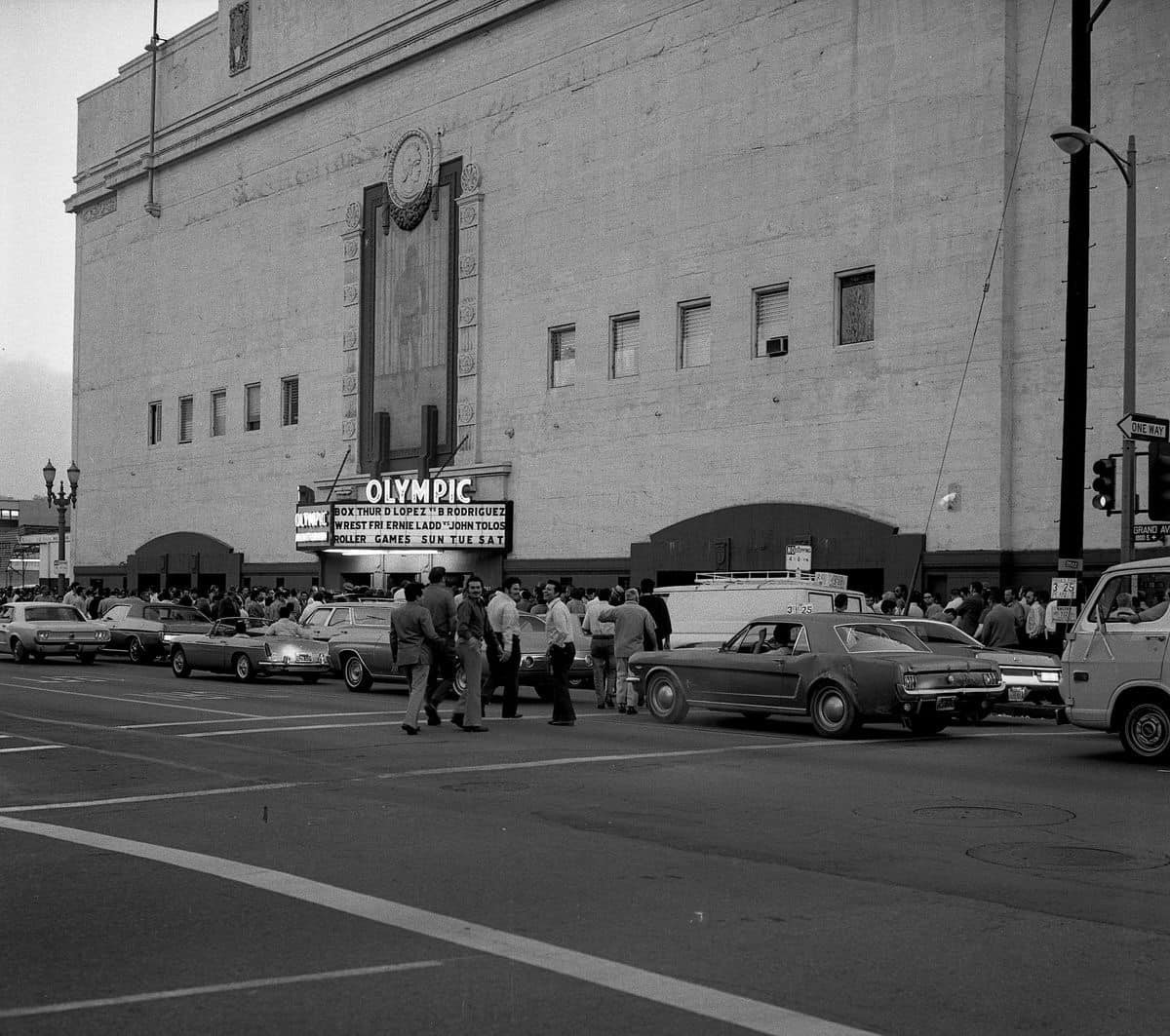 |
|
| (1972)* – The scene outside the Olympic Auditorium at Grand and 18th Street. |
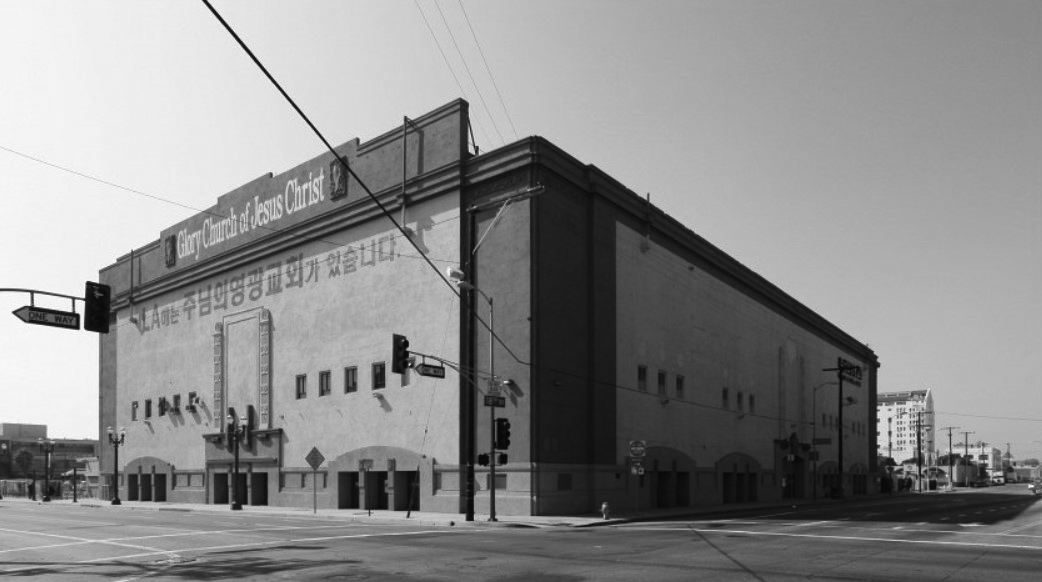 |
|
| (ca. 2014)^++ – View showing the Olympic Auditorium as it appears today, now a church. |
Historical Notes In June 2005, the Glory Church of Jesus Christ, a Korean-American Christian church, purchased the entire property, thus the name Grand Olympic Auditorium ceased to exist. In 2007, the arena was given a new facelift back to its original brown coat of paint that was abandoned in 1993 when the arena reopened.^* |
* * * * * |
St. Vincent Catholic Church
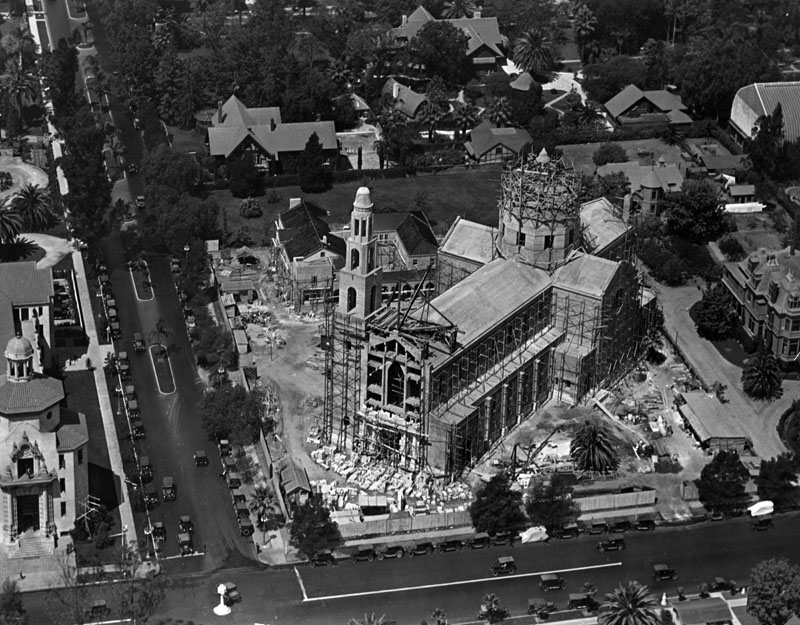 |
|
| (ca. 1924)* - A construction fence and temporary buildings surround the St. Vincent de Paul Catholic Church, 621 W. Adams Blvd., as it is being built. Scaffolding is on the dome and sides. Limestone blocks for the facade lie on the ground in front of the entrance. The surrounding neighborhood has stately homes with extensive grounds. |
Historical Notes The St. Vincent de Paul Church (aka St. Vincent Catholic Church) was built in the 1920s and designed by architect Albert C. Martin, Sr. Dedicated in 1925, it was located in what was then one of the wealthiest sections of the city, on land adjacent to the Edward Doheny Mansion and Stimson House. It was the second Roman Catholic church in Los Angeles to be consecrated.^ |
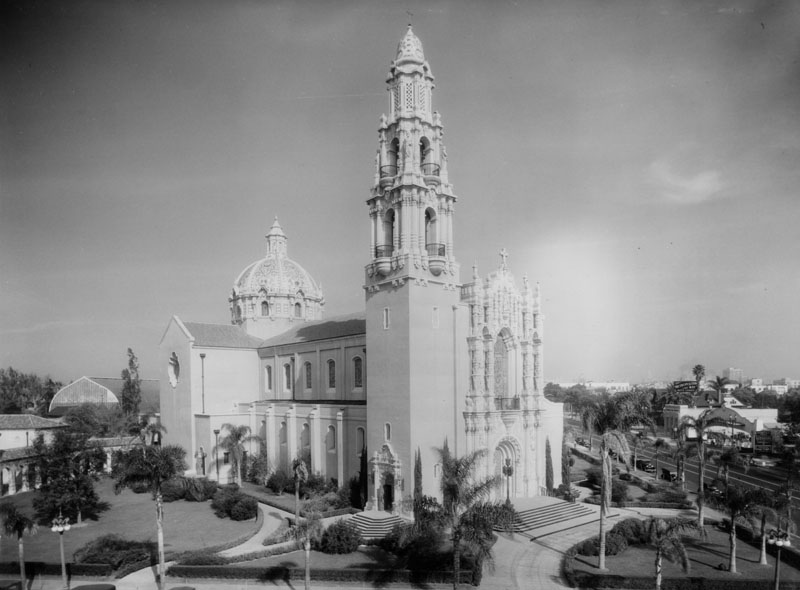 |
|
| (ca. 1925)* - View of a newly completed St. Vincent Catholic Church located at the northwest corner of Adams and Figueroa St. |
Historical Notes The Spanish Colonial Revival style St. Vincent Church was built in 1923-25. The decorative entrance is of Indiana limestone and brightly colored tile covers the 45 foot diameter dome. The interior ceiling decoration is by John B. Smeraldi.* |
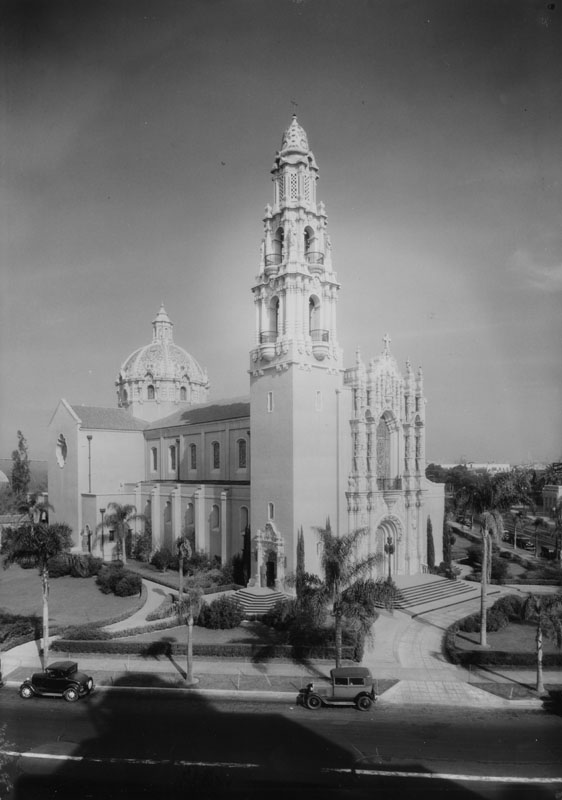 |
|
| (1925)* - Closer view of the newly constructed St. Vincent Catholic Church at 621 W. Adams Blvd. |
Historical Notes St. Vincent de Paul Roman Catholic Church was a gift from oil magnate and benefactor Edward Laurence Doheny I, who drilled Los Angeles' first oil well in 1892. |
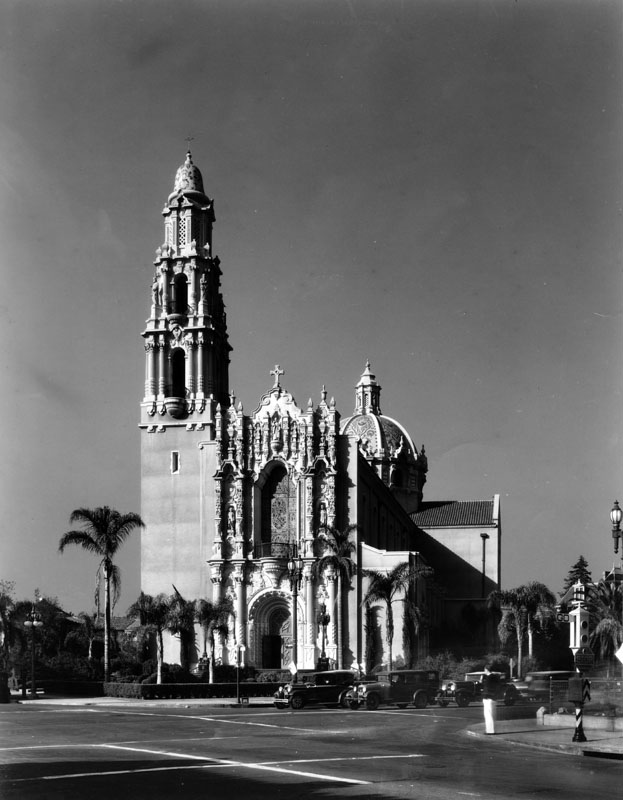 |
|
| (1930s)* - Exterior view of the main facade of St. Vincent de Paul Roman Catholic Church, located on the northwest corner of S. Figueroa and W. Adams. |
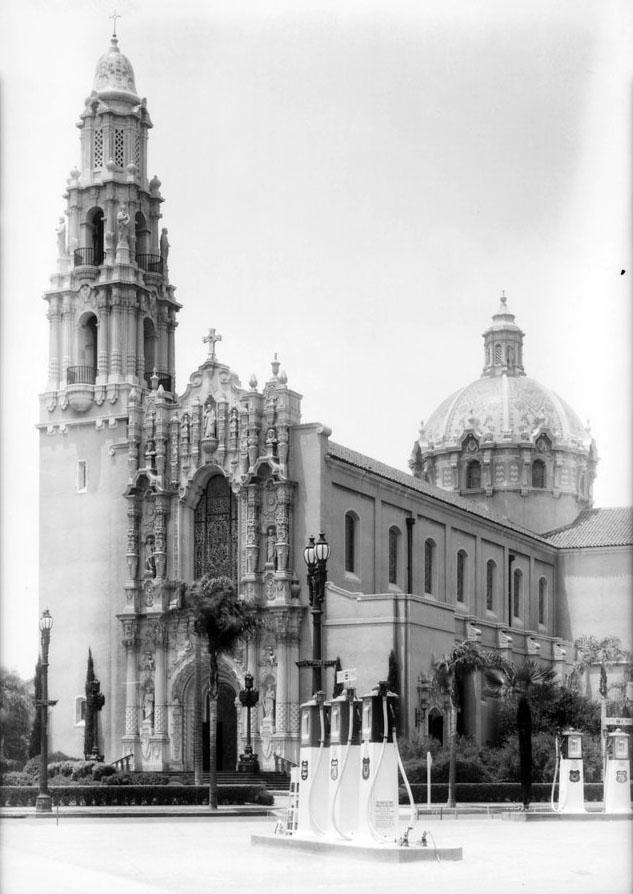 |
|
| (1934)^ – View looking at the St. Vincent Catholic Church as seen from a Union 76 service station located across the street, on the NE corner of West Adams Boulevard and South Figueroa Street. |
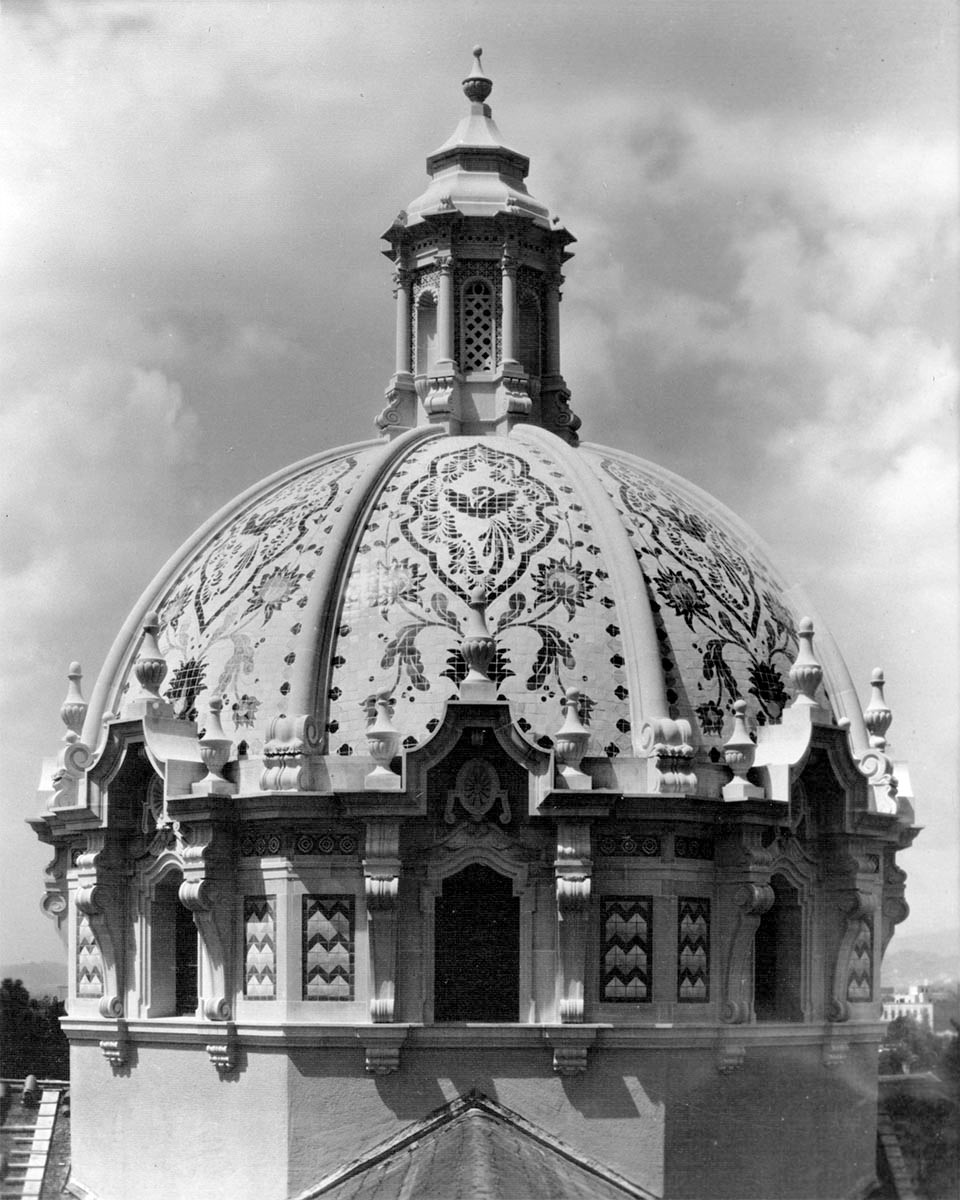 |
|
| (n.d.)**# – Close-up view of the Saint Vincent de Paul Church showing details of the tiled dome. |
Historical Notes The underside of the dome features eight paintings of Matthew, Mark, Luke, and John and their symbols: man; lion; ox; and eagle. In 1971, Saint Vincent de Paul Church was dedicated Los Angeles Historic-Cultural Monument No. 90 (Click HERE for complete listing). Click HERE for contemporary view. |
* * * * * |
St. Vincent's Hospital
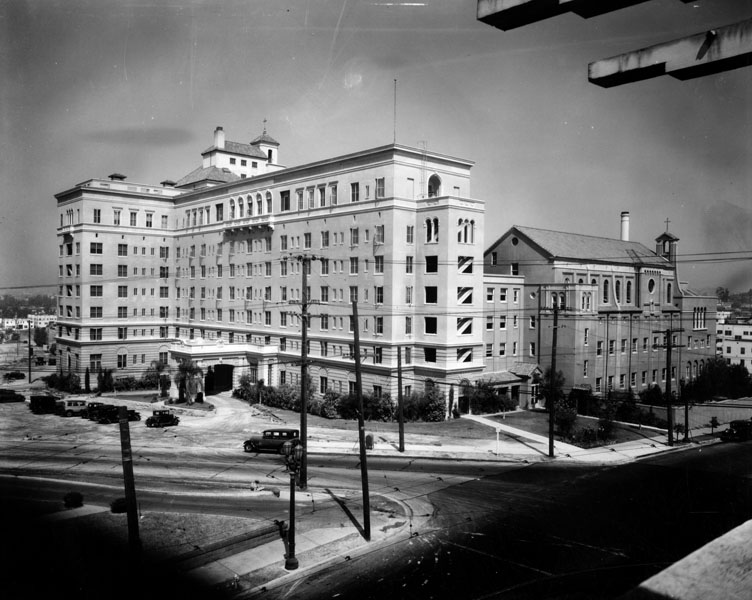 |
|
| (ca. 1925)* - Exterior view of St. Vincent's Hospital, located on 3rd and Alvarado Streets. Built in 1924, it was designed by architects Austin and Ashley. |
Historical Notes The Daughters of Charity of St. Vincent de Paul established the first hospital in Los Angeles - the Los Angeles Infirmary, in 1856. It was located in the Sonora Town adobe owned by then-Mayor of Los Angeles, Don Cristóbal Aguilar. Four years later, in 1860, the hospital relocated to 1416 Naud Street, between Ann (named for Sister Ann) and Sotillo Street (though other data indicates the location was 1414 Naud Street, between N. Main and San Fernando Road). In 1869, Daughters incorporated the Los Angeles Infirmary under their own ownership, the first women in the region to do so. In 1883 they purchased six and a half acres of land at Beaudry Park at a cost of $10,000, and a new hospital building was erected a year later at Beaudry and Sunset, on a hillside overlooking Sonora Town. By 1898, Los Angeles Infirmary had come to be known as Sisters Hospital, but both names were used interchangeably in reference to the same hospital; in 1918, the name was officially changed to St. Vincent's Hospital.* |
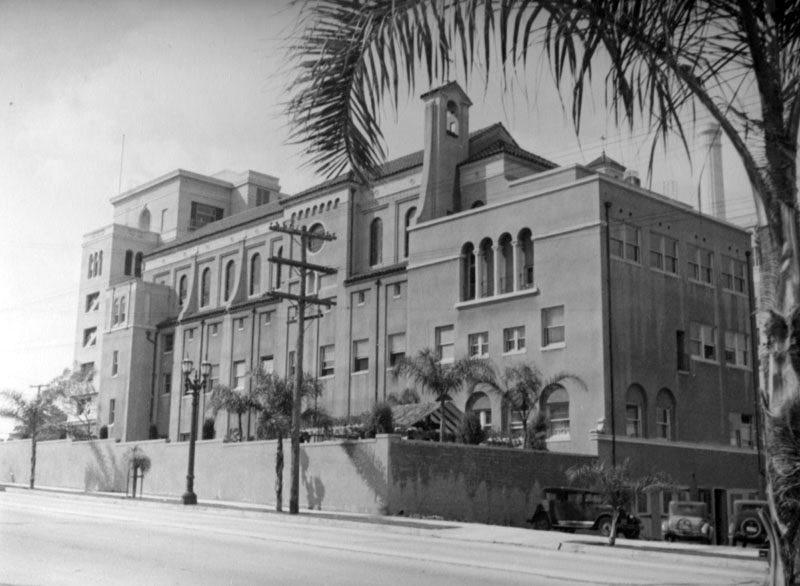 |
|
| (1933)* - View of the St. Vincent's Hospital, located at 2131 West Third Street. |
Historical Notes In 1924, the Italianate style St. Vincent's Hospital building was erected on 3rd and Alvarado. It was desinged by Architects John C. Austin and Frederick M. Ashley. |
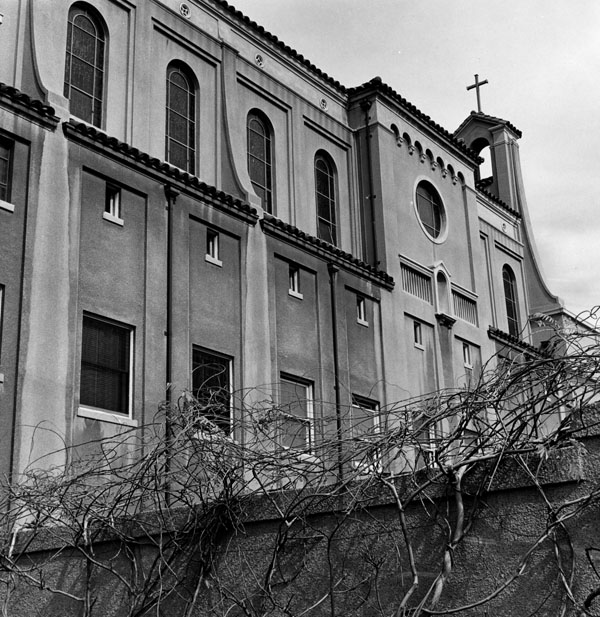 |
|
| (1964)* - Exterior view of a portion of St. Vincent's Hospital as seen in 1964. |
Historical Notes For 47 years, the hospital had such a steady growth that they were forced to expand yet again, and groundbreaking for a newer, larger building took place in 1971 - this time, located at 2131 W. 3rd Street. With a "new" hospital came a new name, and in 1974, it changed again, this time becoming St. Vincent Medical Center.* In 1995, the Daughters of Charity National Healthcare System sold SVMC to Catholic Healthcare West. In 2002, CHW sold the hospital to the newly established Daughters of Charity Health System.^* |
* * * * * |
Pacific Electric Hill Street Station
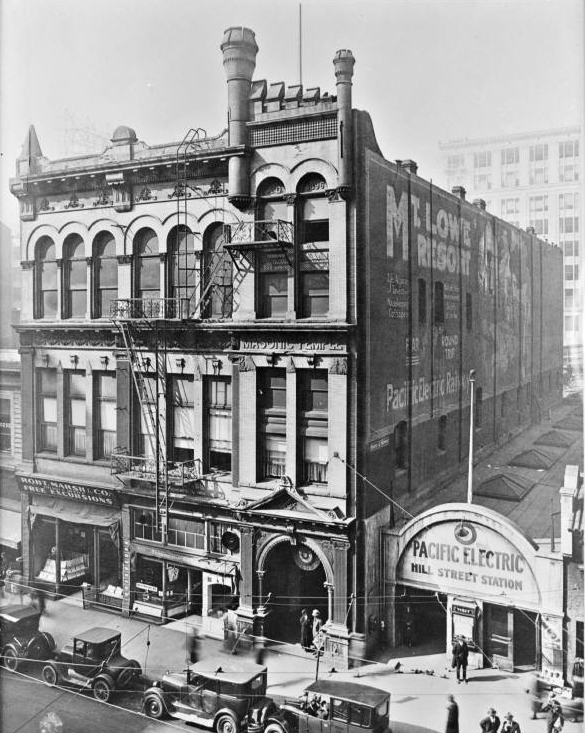 |
|
| (ca. 1920)^^## - Pacific Electric Hill Street Station & Masonic Bldg. West side of Hill St between 4th & 5th Streets. Mt. Lowe Resort is advertised on the side face of the Masonic Building. Click HERE to see more in Early Views of Mt. Lowe Railway. |
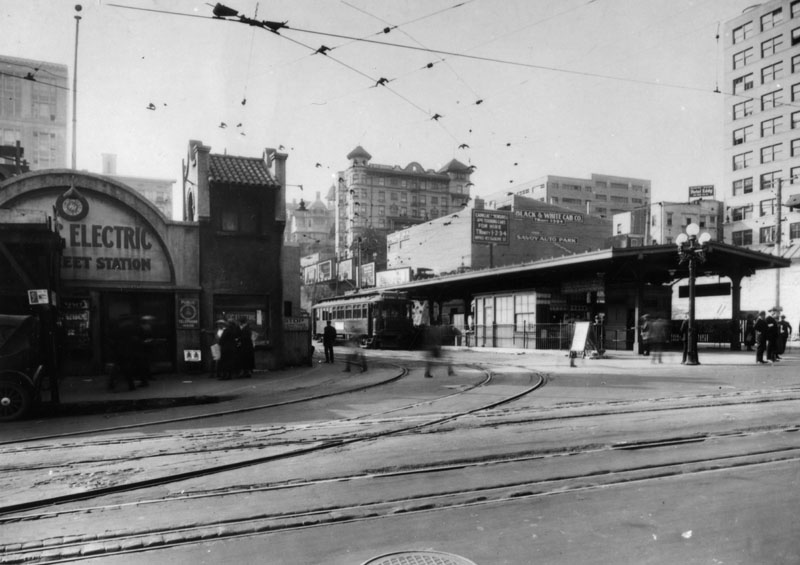 |
|
| (ca. 1920's)* - The Pacific Electric Hill Street station, located at 427 South Hill Street, |
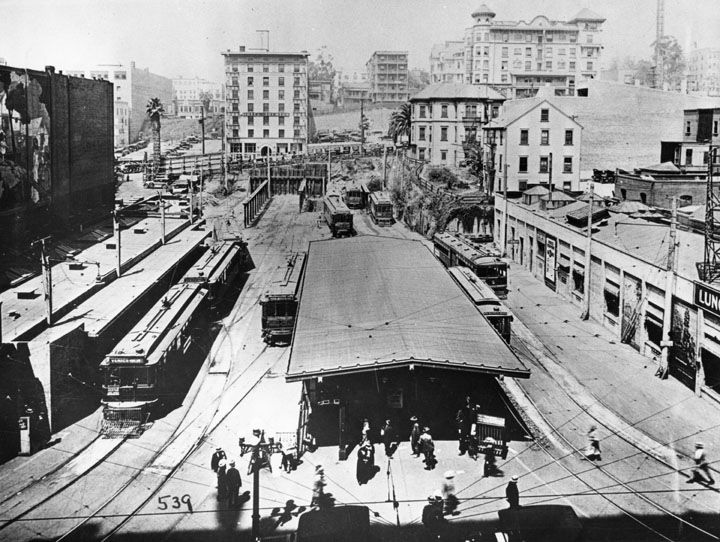 |
|
| (ca. 1924)* - The Hill Street station for electric cars during 1922 to 1925, before the Subway Terminal Building was built, looking west toward Bunker Hill. |
Historical Notes As street traffic increased in downtown Los Angeles, the Pacific Electric Railway undertook its most ambitious project, a dedicated right of way into downtown through a subway - the existing terminal in the Pacific Electric Building at Sixth and Main was reached by shared street running. Responding to the traffic congestion that clogged the streets, the California Railroad Commission in 1922 issued Order No. 9928, which called for the Pacific Electric to construct a subway to bypass downtown's busy streets.^* |
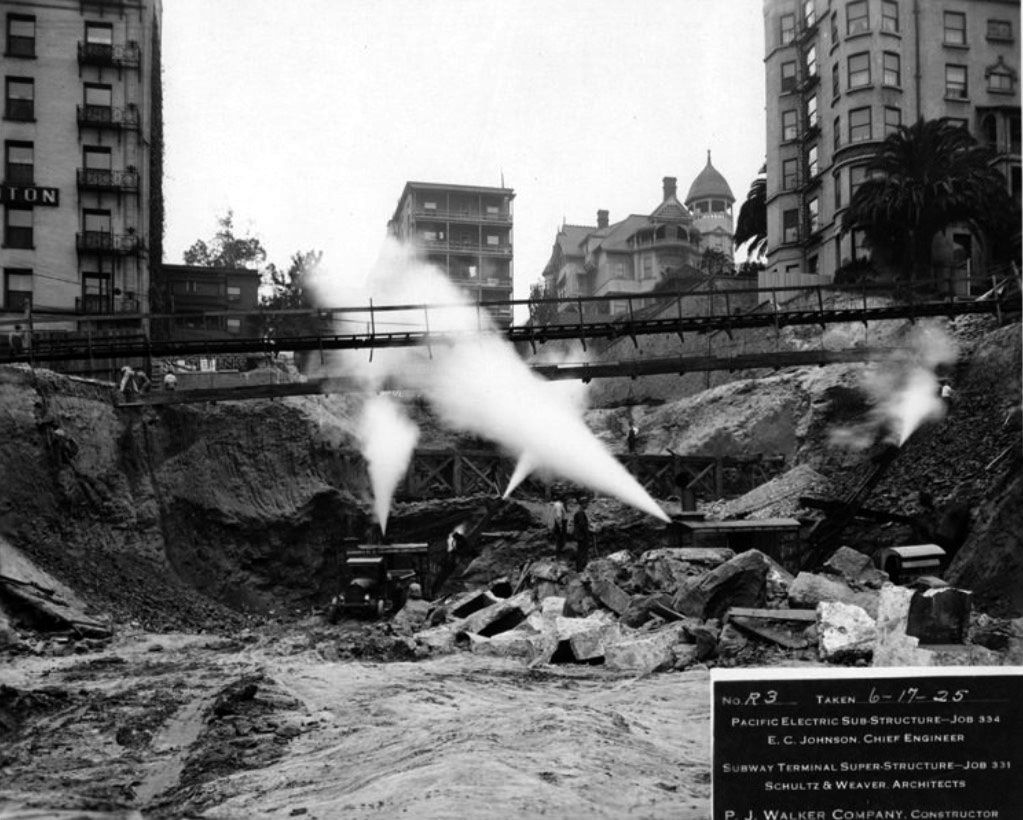 |
|
| (1925)^.^ – View, looking west from Hill Street, of the construction site as the PE Hill Street Station is converted to a massive building and entrance to a subway tunnel which will cross Bunker Hill to Toluca Yard (1st/2nd/Beverly Boulevard/Glendale Boulevard). Here they have breached the Olive Street roadbed and spanned the vacated Olive Street School/Health Department property. The Trenton (on the left) and the Fremont (on the right) look on nervously. The Rose Mansion at 4th Street and Grand Avenue can be seen behind the Fremont Hotel. |
Historical Notes After 18 months of construction and $1.25 million in expenditures, the Subway officially opened to the public on December 1, 1925, between the intersection of Beverly and Glendale Blvds in Westlake, and the Subway Terminal Building.^* Click HERE to see the construction of the western portal of the Pacific Electric subway tunnel at 1st and Glendale. |
* * * * * |
Subway Terminal Building
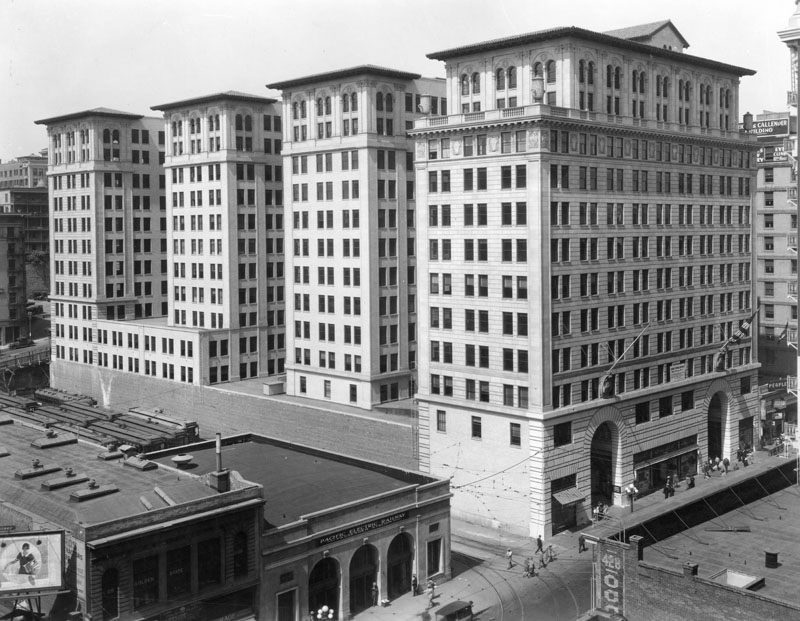 |
|
| (ca. 1925)* - Subway Terminal Building and the Pacific Electric Railway Passenger Station in 1925, the year they were built. View is of the Hill Street side south of 4th Street. |
Historical Notes The Subway Terminal Building, now Metro 417, is an Italian Renaissance Revival building in Downtown Los Angeles at 417 South Hill Street. It was designed by architects Schultze and Weaver and was built in 1925. It was the downtown terminus for the "Hollywood Subway" branch of the Pacific Electric Railway Interurban rail line. Currently it is a luxury apartment building. It is located near Pershing Square. The Subway Terminal Building was built to conform to the 150 foot height limit imposed on all downtown construction. The other end of the subway line emerged at the surface at the Belmont Tunnel / Toluca Substation and Yard.^* |
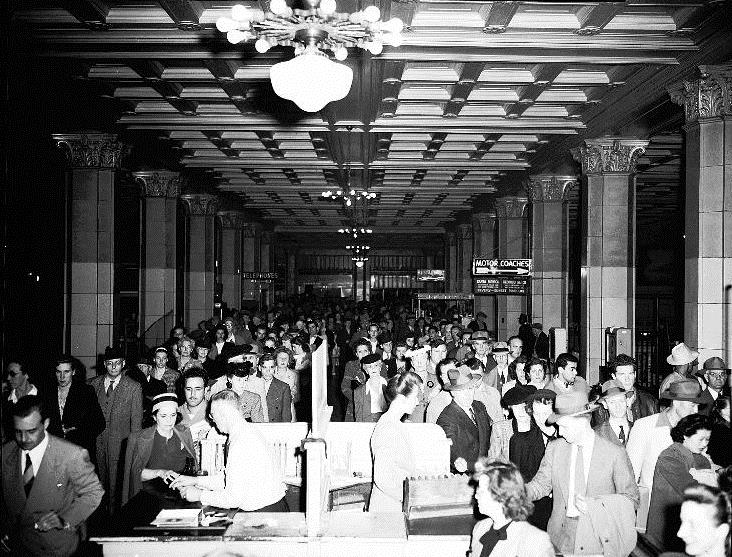 |
|
| (ca. 1925)^^## - View of the Subway Terminal main hall. |
Historical Notes After 18 months of construction and $1.25 million in expenditures, the Subway officially opened to the public on December 1, 1925. The trains, which traveled a distance of slightly over one mile, transported passengers between the tunnel's mouth (Toluca Yard) near the intersection of Beverly and Glendale Boulevards in Westlake, and the Subway Terminal Building.^* |
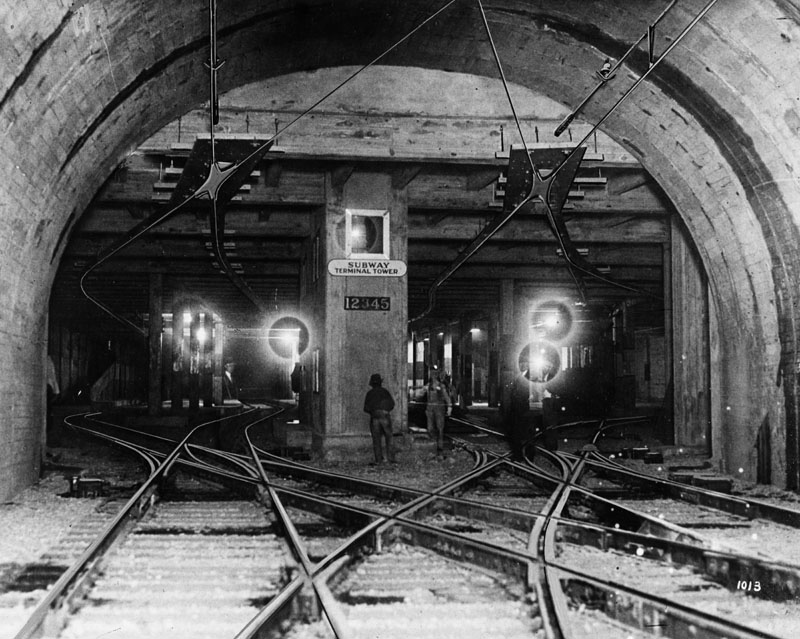 |
|
| (ca. 1925)* - Interior view of the Subway Terminal Building in downtown Los Angeles, showing Pacific Electric car tracks running in various directions in the subway. |
Historical Notes The early years of the Subway were widely met with success, as the Hollywood Subway emerged as one of Los Angeles's most popular modes of public transit throughout the 1920s and 1930s. Ridership hit an all-time high during the World War II-era; in 1944 – considered to have been the Subway's peak – trains carried an estimated 65,000 passengers through the tunnel each day.^* |
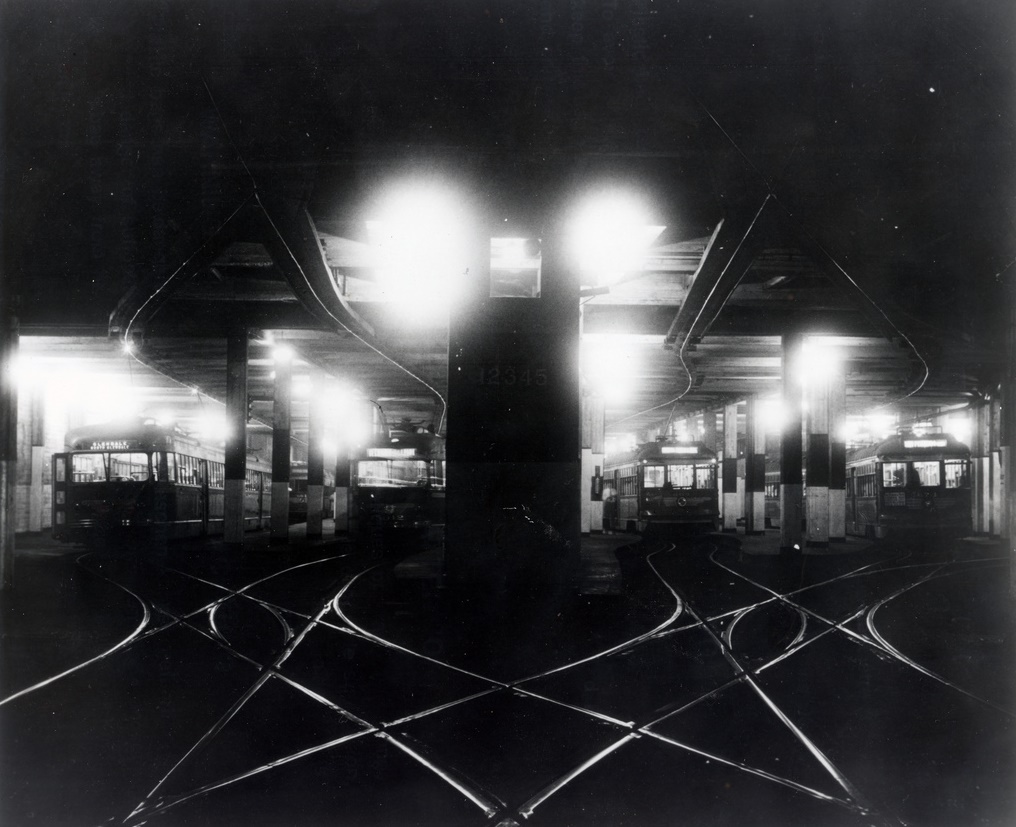 |
|
| (n.d.)^^## - View of the symmetry in the tracks within the Pacific Electric Subway Building. The subway was in operation from 1925 to 1955. |
* * * * * |
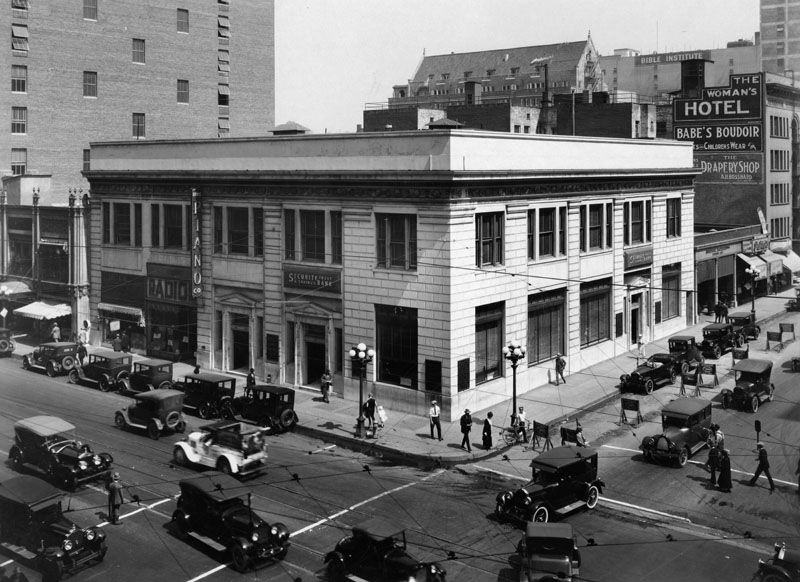 |
|
| (ca. 1925)* - A look down upon Seventh Street (running across in the foreground) and Grand Avenue reveals a busy intersection in this business corridor. The white building in the background is occupied by two businesses, a branch of Security Trust and Savings Bank (right) and Lyric Piano Co. |
Figueroa Theatre
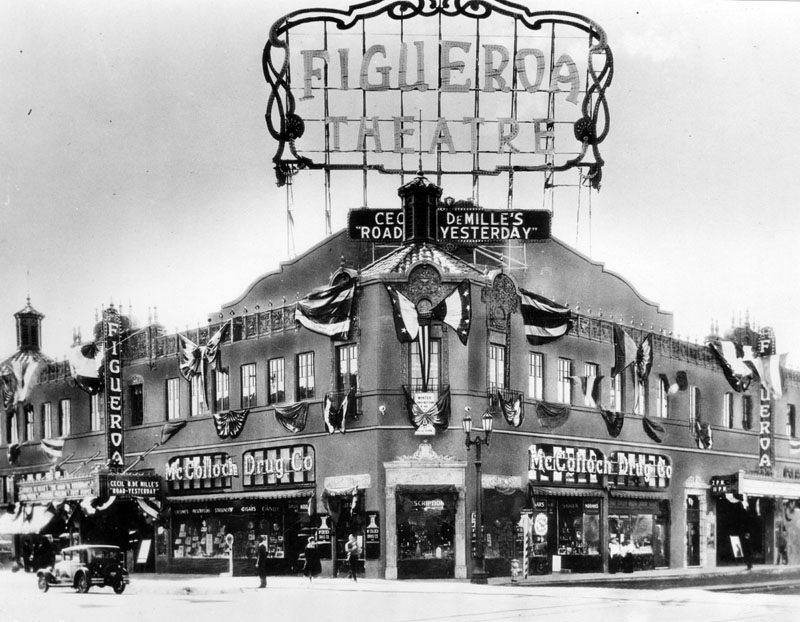 |
|
| (ca. 1925)* - Exterior view of the Figueroa Theatre, located on the corner of Figueroa and York Boulevard in Highland Park. The corner entrance is for McColloch Drug Co., offering perfumes, prescriptions, stationary, cigars, candy, and an array of goods. Two entrances for the theater are visible on either side of the building, each with a box office and marquees advertising Cecil B. DeMille's 1925 drama film, "The Road to Yesterday", starring Joseph Schildkraut. |
Central Library
.jpg) |
|
| (1925)* - Photograph shows the construction of the Los Angeles Public Library, located at 630 W. Fifth Street; view is of the southeast corner. The structure, which appears to be almost complete, is completely covered in scaffolding. Numerous vehicles are parked in the lot at the foreground, which has a sign at the entrance that reads "Savoy" (not visible in this angle). More automobiles are parked along Grand Avenue. |
Historical Notes Central Library, located at 630 W. 5th Street in downtown Los Angeles, was designed by architects Bertram G. Goodhue and Carlton M. Winslow. Constructed between 1924-1926, it was designed to mimic the architecture of ancient Egypt, complete with a tiled mosaic pyramid tower and many beautiful murals throughout.* |
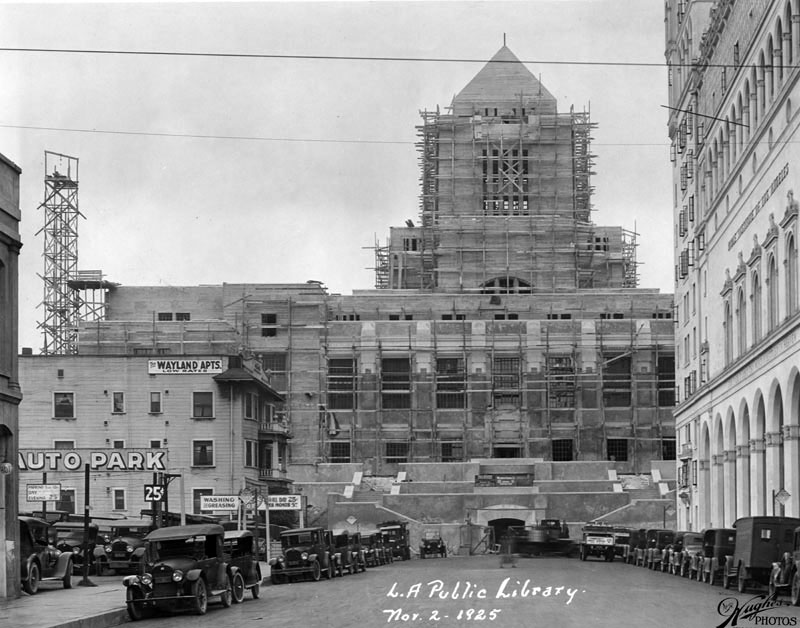 |
|
| (1925)* - Photograph shows construction of the Los Angeles Public Library, located at 630 W. Fifth Street; view is looking north on Hope Street. The structure, which is almost complete, shows scaffolding along the entire south side as well as surrounding the tower at the top. A sign posted above the tunnel entrance, at the end of this street reads: "Weymouth Crowell Co. - General Contractors". The Wayland Apts. offering "low rates" is visible on the left corner next to Savoy Auto Park, whose rates are .25 cents all day, or $5.00 per month. The large white building on the right is the Bible Institute, later to become Church of the Open Door/Biola Institute. |
Historical Notes The Central Library Goodhue building was constructed between 1924 and 1926 on the site once occupied by the State Normal School (later to evolve into UCLA). |
 |
|
| (1926)*##^ – Closer view looking north on Hope Street showing the Central Library Goodhue building in its final stages of construction. |
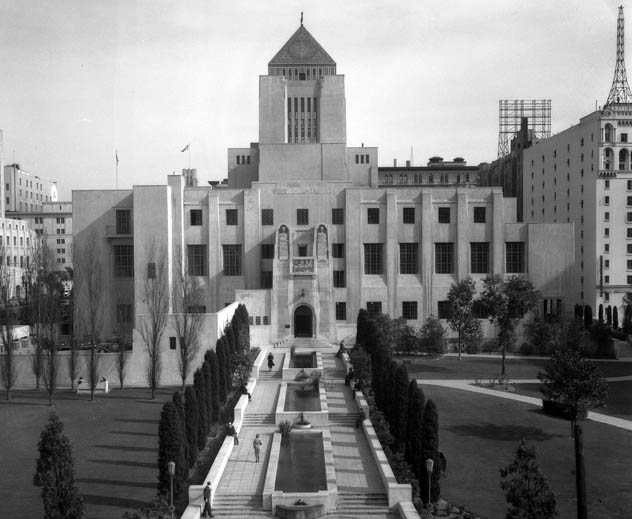 |
|
| (ca. 1935)* - Walkway and front facade of Los Angeles Public Library's Central Library, located at 630 W. 5th Street. View is looking east from Flower Street with the Church of the Open Door (Bible Institute) to the right. |
Historical Notes On March 1, 1967 the Central Library Building was designated Los Angeles Historic-Cultural Monument No. 46 (Click HERE to see listing). It is also listed on the National Register of Historic Places. |
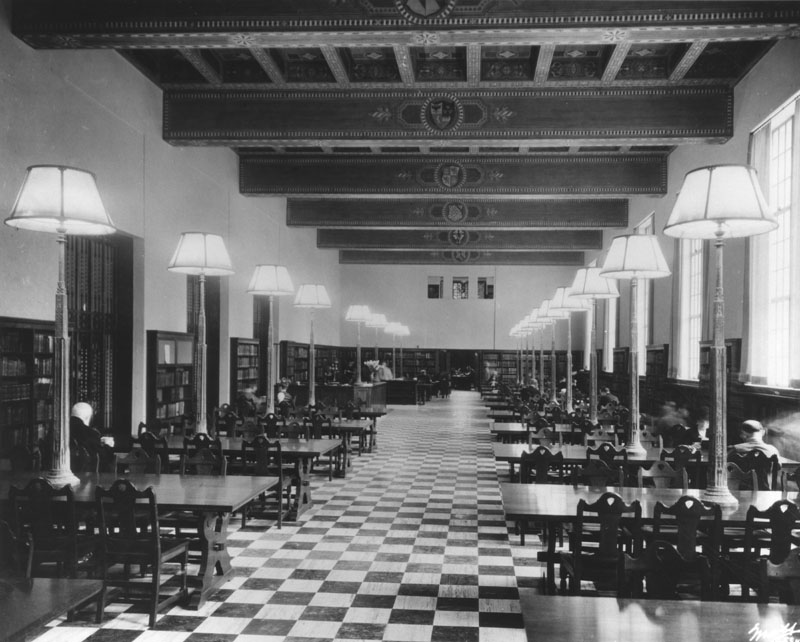 |
|
| (1926)* - Interior view of the History Department, at Los Angeles Central Library; view is looking toward the Travel and Biography section. The reference desk is visible mid-way on the left, and long wooden tables can be seen throughout the department - all have tall lamps illuminating each area. Note the colorful ceiling beams and checkerboard floor. |
Historical Notes The History Department was previously known as the Reference Room - which was the largest reading room of the library.* |
Click HERE to see more Early Views of the Los Angeles Central Library |
* * * * * |
Million Dollar Theatre Building
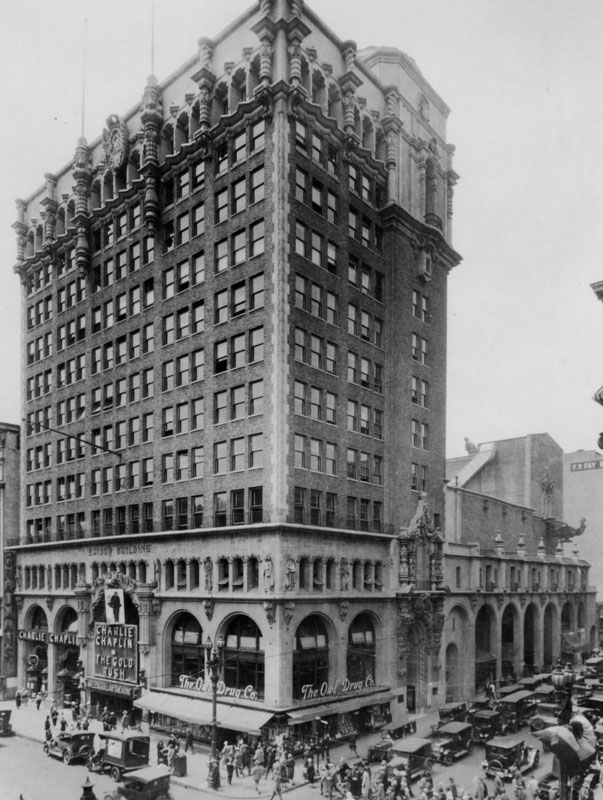 |
|
| (1925)* - Exterior view of a building on the corner of Third Street and Broadway. It was the home of the Edison Company offices, the Million Dollar Theatre (formerly Gruman’s Theater), and the Owl Drug Company. The marquee indicates that Charlie Chaplin's 1925 film Gold Rush is playing at the theater. |
Historical Notes Albert G. Martin and William Lee Woollett designed the building, constructed in 1918. The exterior, in the "Churrigueresque" style, was designed by A.C. Martin Sr., while the baroque interior was designed by W.L. Woolett. The interior includes the mural 'The Witch Scene from Macbeth' and a sculpture by Joe Morra. Click HERE to see more early views of the Million Dollar Theatre Building. |
* * * * * |
Metropolitan Theatre (later Paramount Theatre)
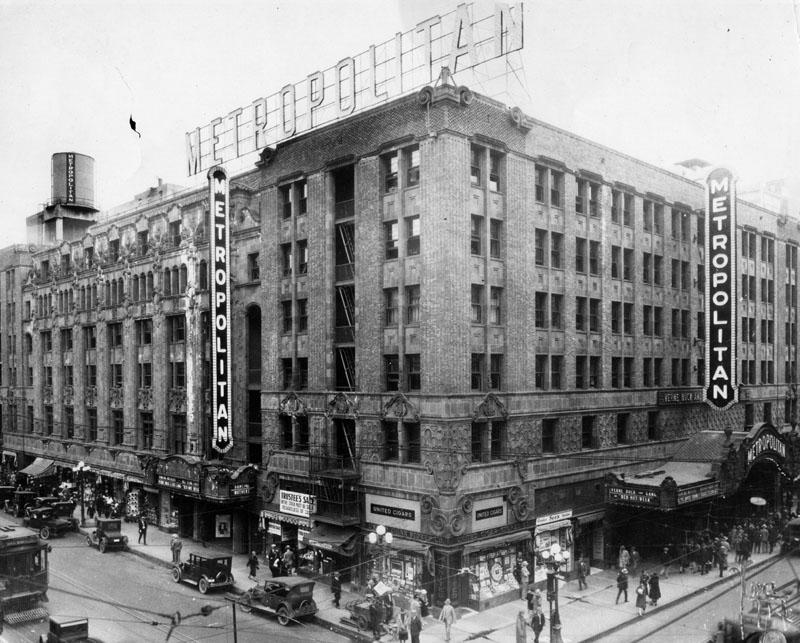 |
|
| (ca. 1925)* - View of the Grauman's Metropolitan Theater Building (later the Paramount Theater) located on the northeast corner of 6th and Hill streets across from Pershing Square. |
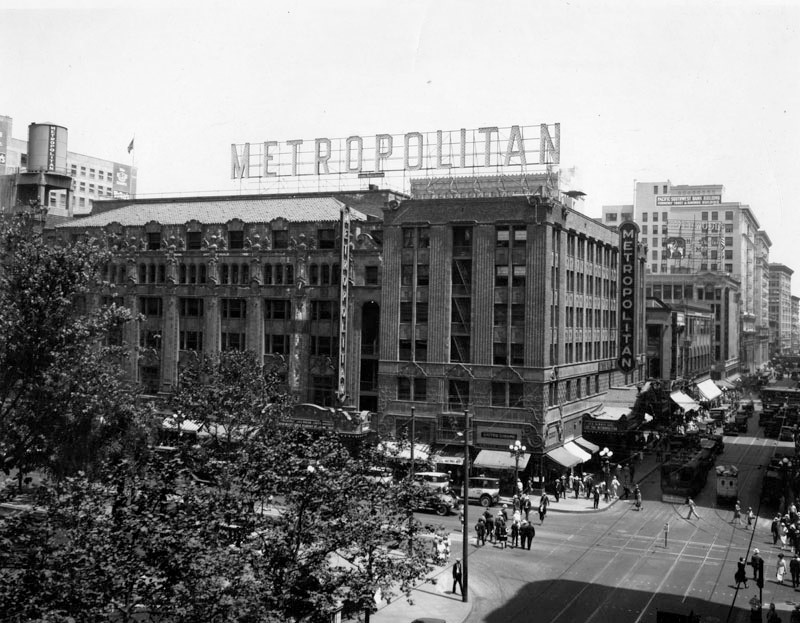 |
|
| (1926)* - View looking at the Metropolitan Theatre on the NE corner of 6th and Hill with Pershing Square at lower-left. |
Historical Notes The building extended 155 feet along 6th and 247 feet along Hill. The main entrance was on 6th while Hill got a much smaller marquee and a miniscule lobby. Those two entrances weren't enough. For a Broadway entrance an existing retail space was re-purposed for a lobby. You went up the stairs (or escalator) and across the alley, entering the theatre building at balcony lobby level. **^ |
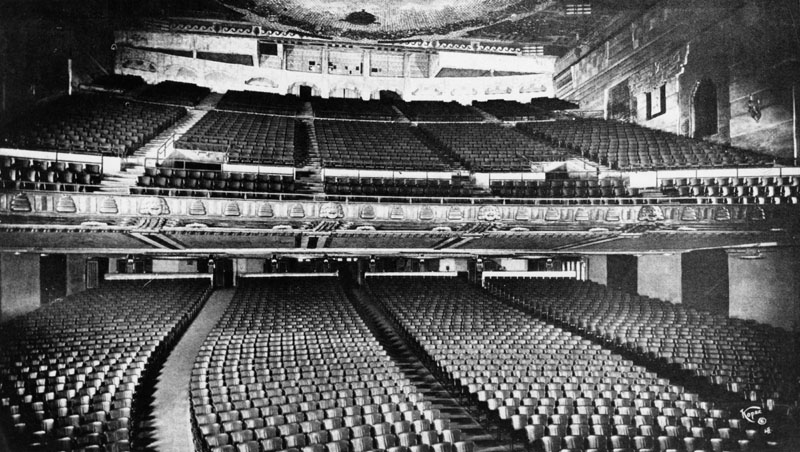 |
|
| (1923)* - Interior view of the Metropolitan Theater as seen from the stage. |
Historical Notes With over 3,600 seats, the Metropolitan/Paramount was the largest movie theater in Los Angeles for many years. Not only did it have one of the largest balconies ever built, its projector had the longest projection throw in the city.^^^* |
 |
|
| (ca. 1920s)* - View of the proscenium from the balcony of the Metropolitan Theatre (Paramount Theatre after 1928). |
Historical Notes The orchestra wasn't in a pit but on a big stage elevator. The screen and prologue action was behind.**^ |
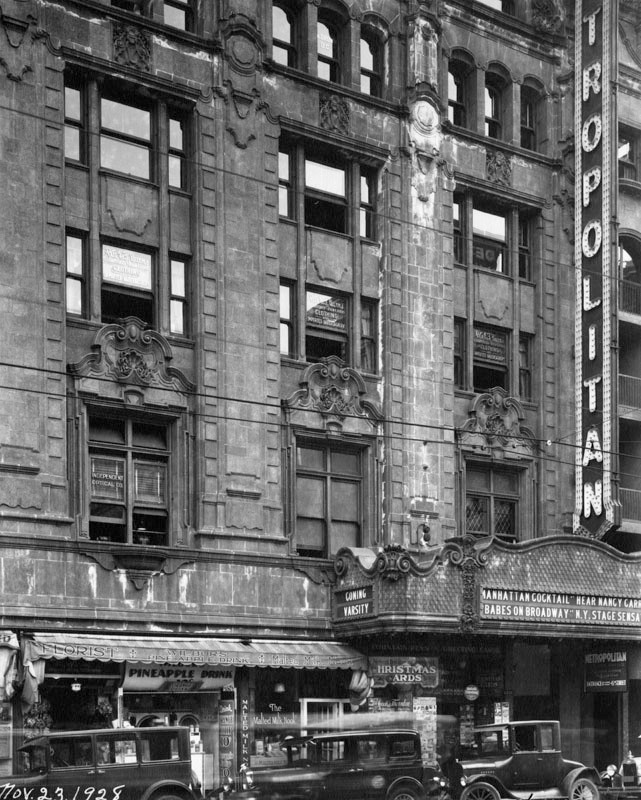 |
|
| (1928)* – Close-up view of the Metropolitan Hotel façade with early model cars parked at the curb. |
Historical Notes In July 1924 Grauman sold his downtown holdings to Paramount Publix. Like other west coast Publix theatres, the Metropolitan was actually operated by Fox West Coast for Paramount. Publix continued to use the Grauman name in advertising although he no longer participated in the theatre's operation. The Metropolitan name came off the building in 1928 and the theatre became the Paramount.**^ |
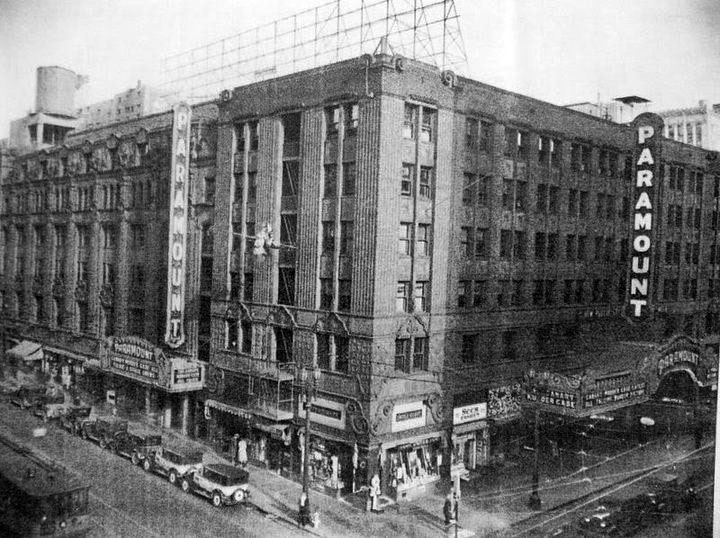 |
|
| (1929)#^*^ - A look at the NE corner of 6th and Hill with the new Paramount signage. The theatre is running "The Canary Murder Case" (a February 1929 release) with William Powell and Louise Brooks. |
Historical Notes The Metropolitan name came off the building in 1928 and the theatre became the Paramount.**^ |
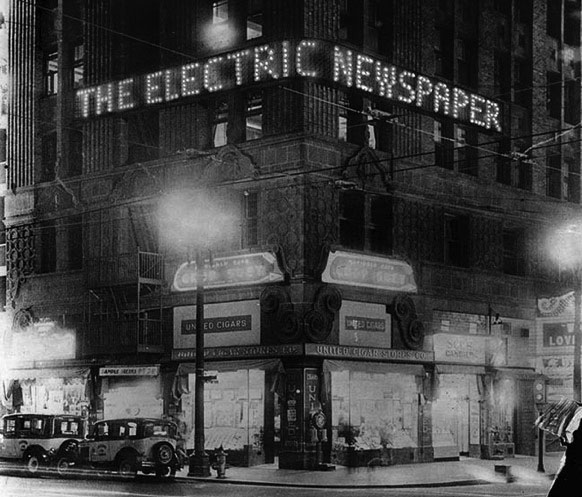 |
|
| (1931)*# – View showing the Los Angeles Times--Richfield “Electric Newspaper” during its preview at the NE corner of 6th and Hill streets on the Paramount Theatre Building (previously the Metropolitan Theatre Building). |
Historical Notes It was apparently thought that the flashing bulletins would stimulate Los Angeles residents to buy the paper the next day to read details behind the headlines. The Times faced stiff competition from several metropolitan papers during the ’30s, and having control of the bulletins read by thousands of people downtown was considered something of a coup. *# |
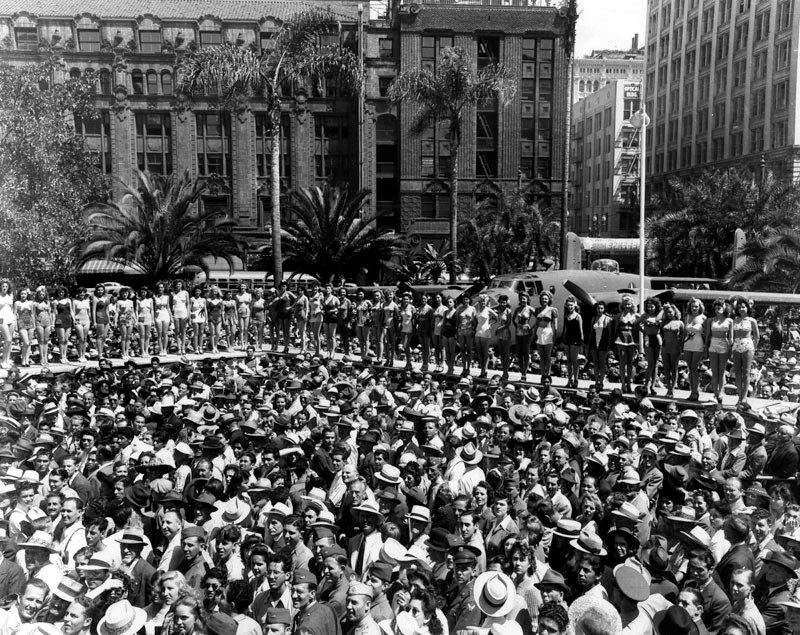 |
|
| (1942)**^ – View showing a beauty pageant in process in Pershing Square with the Paramount Theatre in the background. Photo by Ralph Morris |
Historical Notes In 1963, the Paramount was torn down to make way for a parking lot. In the early 1980’s, a bank was built on this same lot.^ |
* * * * * |
Desmond's Building
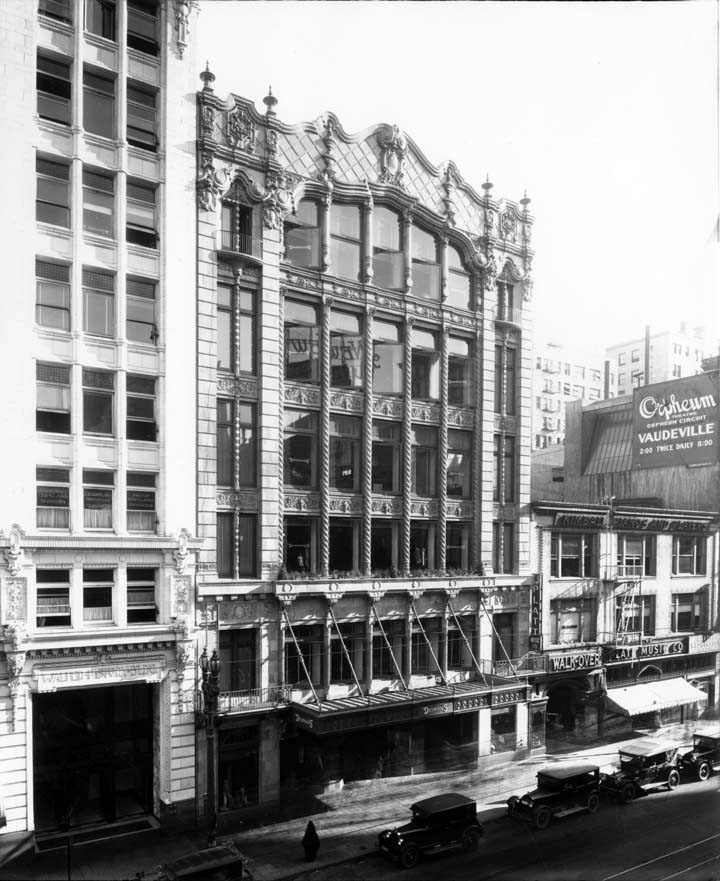 |
|
| (ca. 1925)^*# - View showing the Art Deco style Desmond’s Department Store located at 616 South Broadway. The Walter P. Story Building is on the left; and the Platt Music Company (later Schaber's Cafeteria, 1928) and Orpheum Theatre on the right. |
Historical Notes In 1869, Daniel Desmond arrived in Los Angeles and opened a hat store on Los Angeles Street near Commercial Street. His business expanded and he relocated into the more fashionable Broadway mercantile district at 612-616 South Broadway. In 1924, A. C. Martin designed the six-story concrete building in the Spanish Baroque Revival style featuring a terra cotta façade with twisting columns, balconies and an ornamental pediment. In 1933, the façade was redone in the Beaux Arts style (probably as a result of the Long Beach earthquake).* |
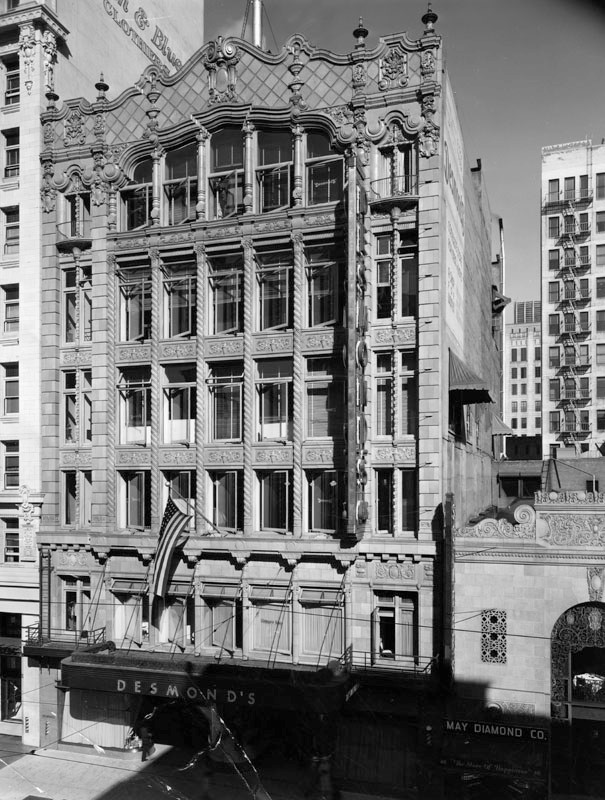 |
|
| (ca. 1929)* - Closer view showing the beautiful Desmond's Clothing Store at 616 South Broadway in Downtown Los Angeles. Schaber's Cafeteria is to the right. Click HERE to see contemporary view of the Desmond's Building. |
Historical Notes Previously on this site was the Symphony Theatre which opened in the 1910's and was demolished in 1923. |
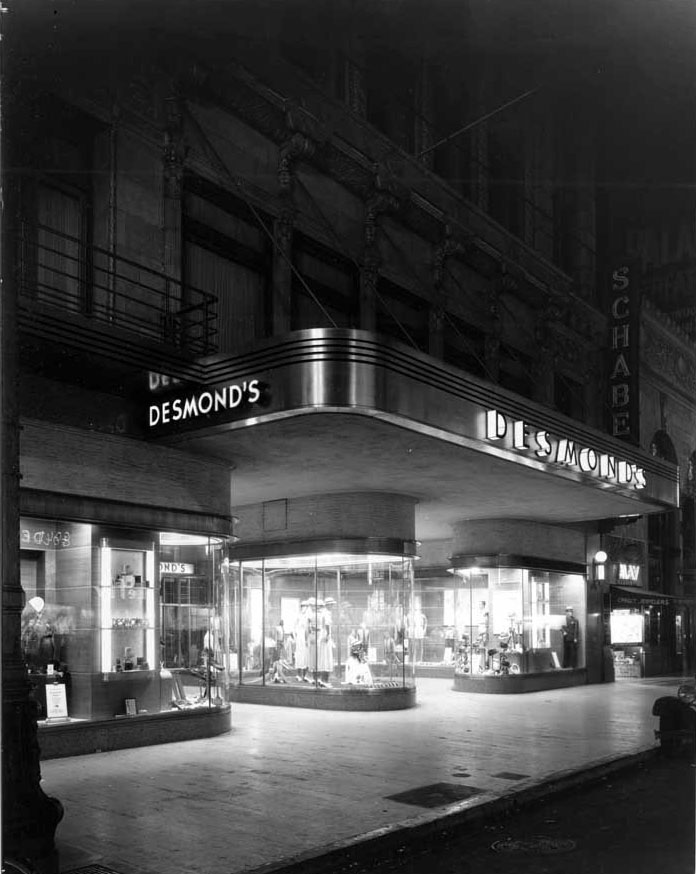 |
|
| (ca. 1930s)^*# - Night view showing the front entrance and window displays of the Desmond’s Department Store on Broadway. |
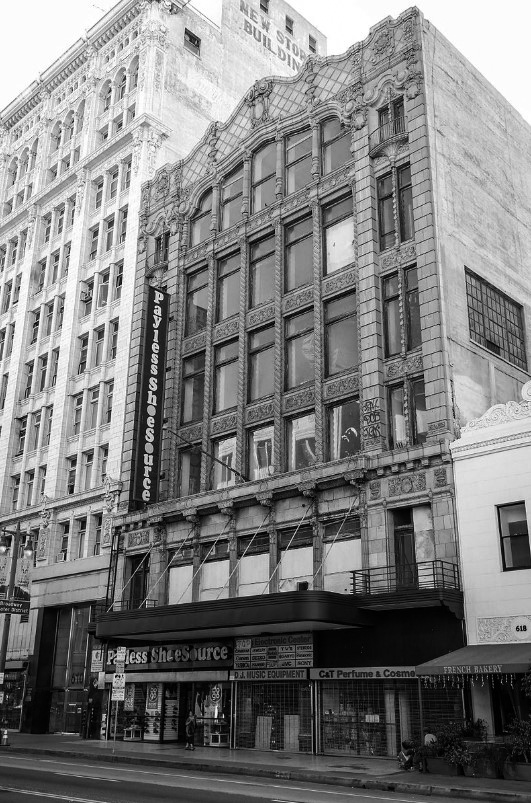 |
|
| (2014)*^ - View showing the former Desmond's flagship store at 616 S. Broadway, Los Angeles. |
* * * * * |
Cocoanut Grove
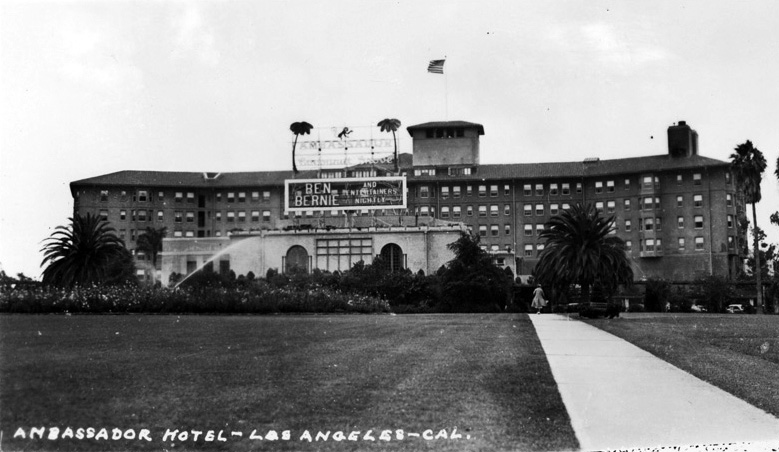 |
|
| (ca. 1920s)^*# - Postcard view of he Ambassador Hotel and the Cocoanut Grove. Ben Bernie and his orchestra are featured at the Grove. |
Historical Notes The Ambassador Hotel and the Cocoanut Grove began operation formally on January 1, 1921, and were located at 3400 Wilshire Boulevard, between Catalina Street and Mariposa Avenue.^* In 1925 Ben Bernie and his orchestra did the first recording of Sweet Georgia Brown. Bernie was the co-composer of this jazz standard (also Maceo Pinkard), which became the theme song of the Harlem Globetrotters.^* |
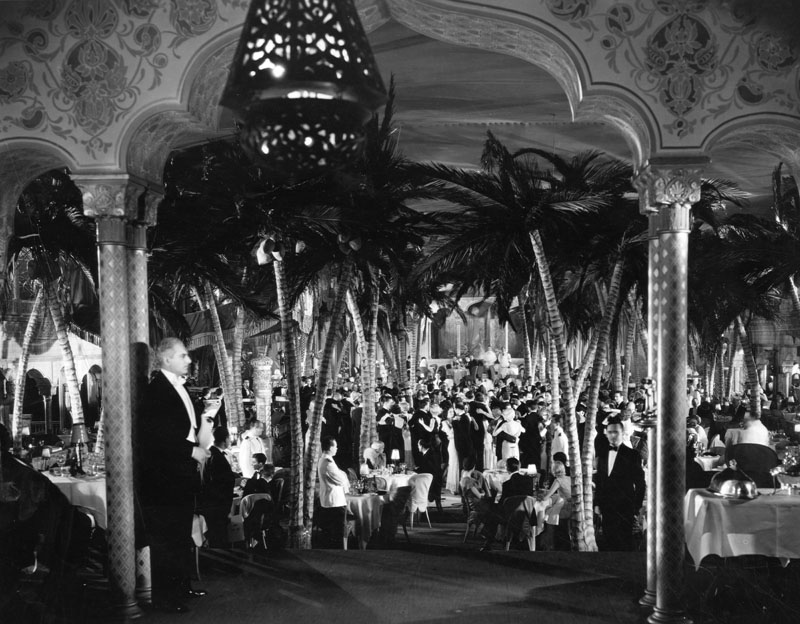 |
|
| (ca. 1938)* - A view across the dining room of the nightclub. Tables and the dance floor are filled with customers. A waiter stands in front. A large number of cocoaut trees spread throughout the room, plus the ornate decorations of ceilings and walls give the room an exotic look. |
Historical Notes For decades, the the Ambassador Hotel's famed Cocoanut Grove nightclub hosted well-known entertainers, such as Frank Sinatra, Barbra Streisand, Judy Garland, Lena Horne, Bing Crosby, Nat King Cole, Liza Minnelli, Martin and Lewis, The Supremes, Merv Griffin, Dorothy Dandridge, Vikki Carr, Evelyn Knight, Vivian Vance, Dick Haymes, Sergio Franchi, Perry Como, Dizzy Gillespie, Benny Goodman, Sammy Davis Jr., Little Richard, Liberace, Natalie Cole, and Richard Pryor.^* On February 29, 1940, the 1939 Academy Awards Ceremony was held in the Cocoanut Grove, with Bob Hope hosting.* |
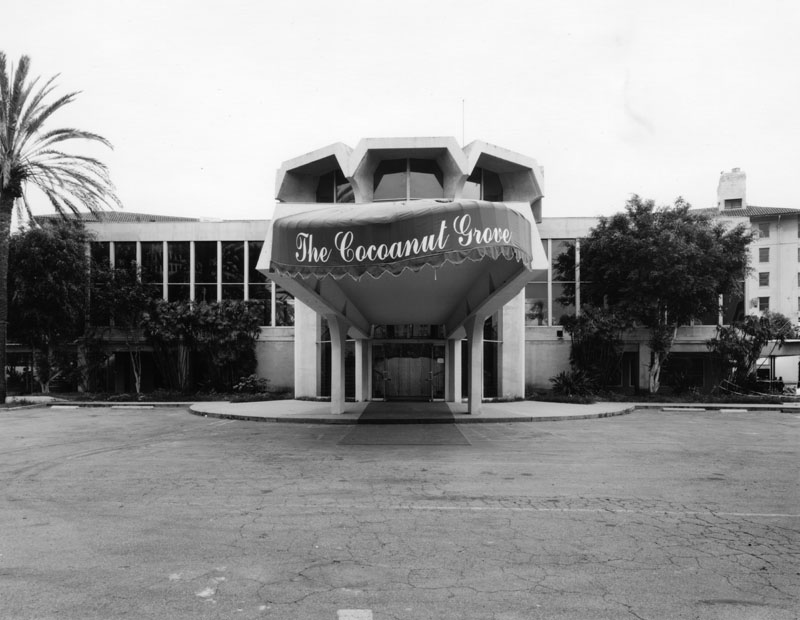 |
|
| (2005)* - View of Cocoanut Grove entrance, facing south. For decades this was "the" hot spot for live entertainment on the West Coast, where people like Bing Crosby and Barbra Streisand got their start, and Frank Sinatra, Sammy Davis Jr. and many others came to perform. |
Historical Notes In 2005, most of the Ambassador Hotel was demolished leaving only the annex that housed the hotel entrance, a shopping arcade, the coffee shop, and the Cocoanut Grove, all of which were promised to be preserved in some manner and used in a new LAUSD school to be built on the site. Due to poor structural integrity, however, the LAUSD decided to demolish most of the Cocoanut Grove, retaining only the hotel entrance and east wall of the Grove.^* |
* * * * * |
Asbury Apartments
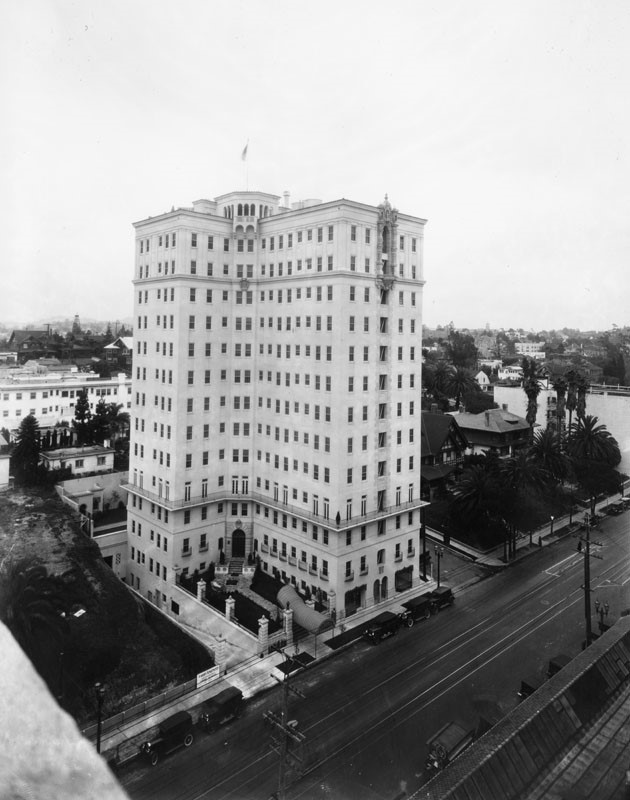 |
|
| (ca. 1925)* - View looking southwest showing the Asbury Apartments, located at 2505 W. 6th Street. Note the canopy above the sidewalk at the entrance. |
Historical Notes The Asbury Apartments was designed by Norman W. Alpaugh & Clarence H. Russel and built in 1924. Originally to be named the San Jacinto Dwellings, these luxury residences with commanding views of Westlake (now MacArthur) Park were regarded as ultra-exclusive when the building opened in 1925. #^*# |
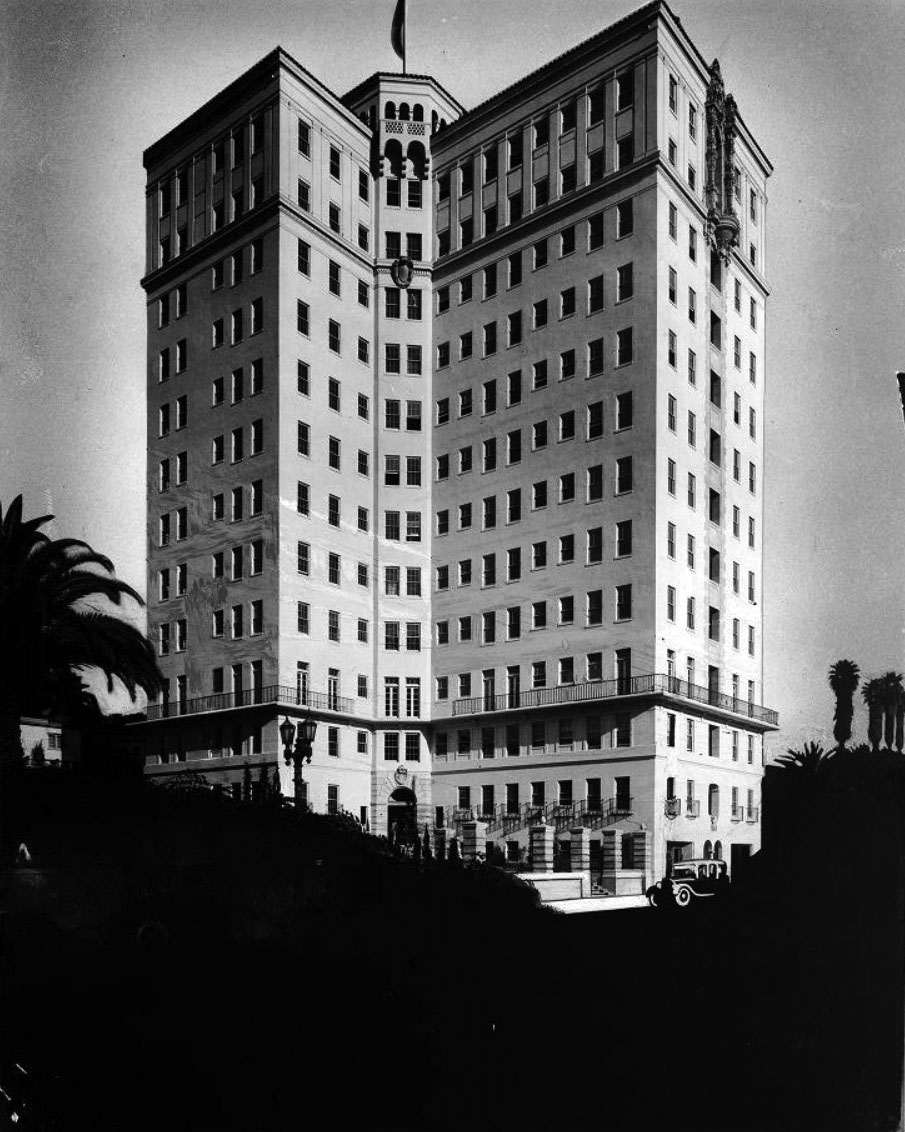 |
|
| (1929)^ – Ground view of the Asbury Apartments as seen from across the street, located on the southeast corner of 6th Street and S. Carondelet Street. |
Historical Notes Units were sold individually in what was termed the "own-your-own" plan, the building was electrically operated throughout, and it contained a parking garage accessible by elevator -- quite rare at the time. A balcony extends along the fourth floor of the building, and the upper portion of the fire escape shaft facing Sixth Street is embellished with a semi-circular balcony and elaborate Churrigueresque detailing. #^*# |
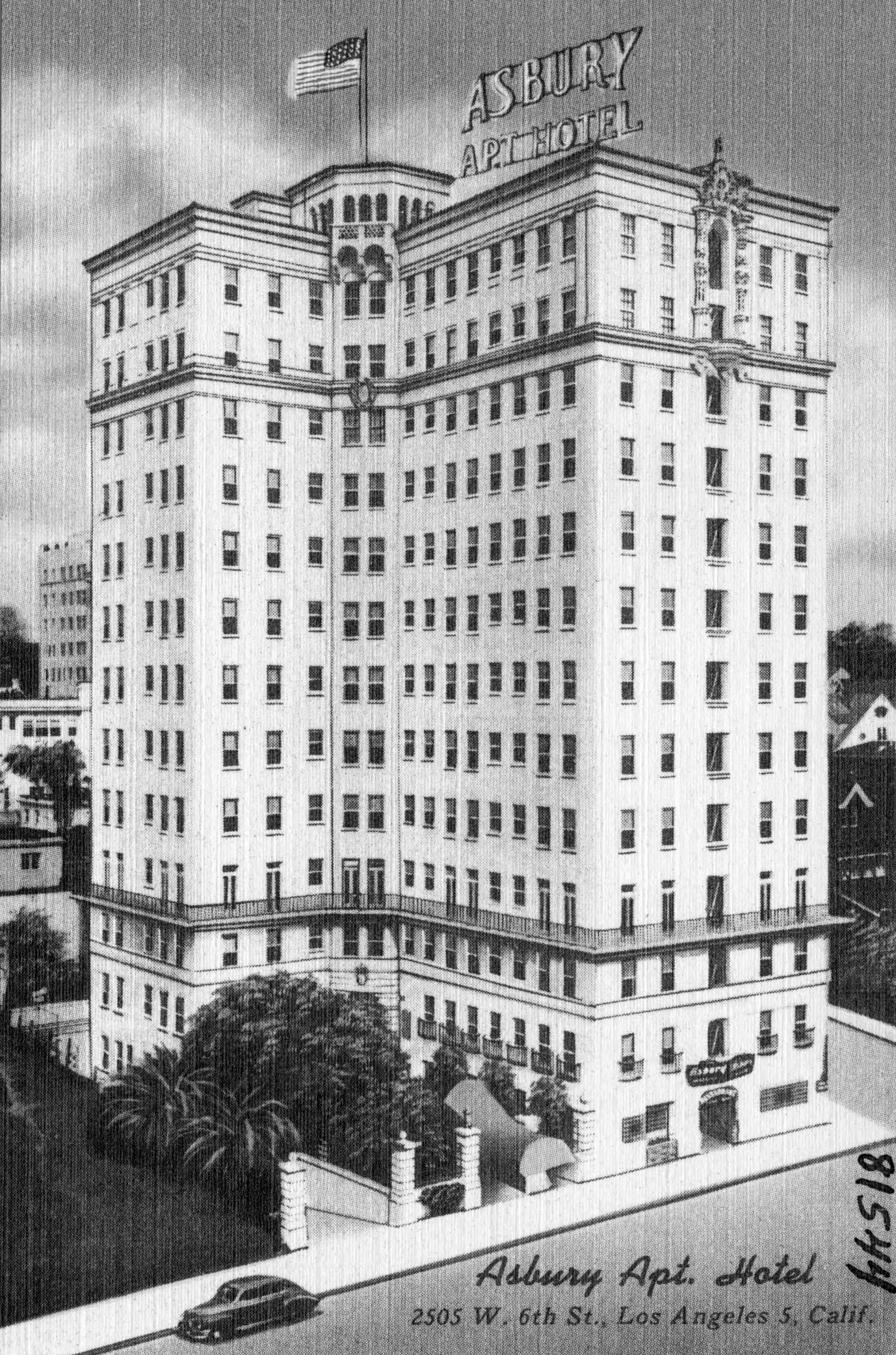 |
|
| (1940s)^* - Postcard view showing the Asbury Apartment - Hotel on 6th Street. |
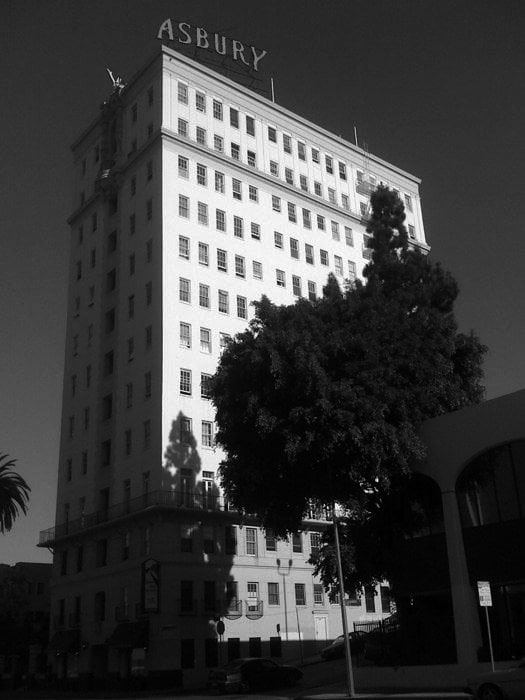 |
|
| (2009)^^ – Looking up toward the top of the Asbury Apartments as it appears today. View is looking southeast. Click HERE for contemporary close-up view. |
Historical Notes The two rooftop signs, advertising "Asbury" in neon, are visible for several blocks and were restored by the city's LUMENS program (Living Urban Museum of Electric and Neon Signs). |
* * * * * |
Talmadge Apartments
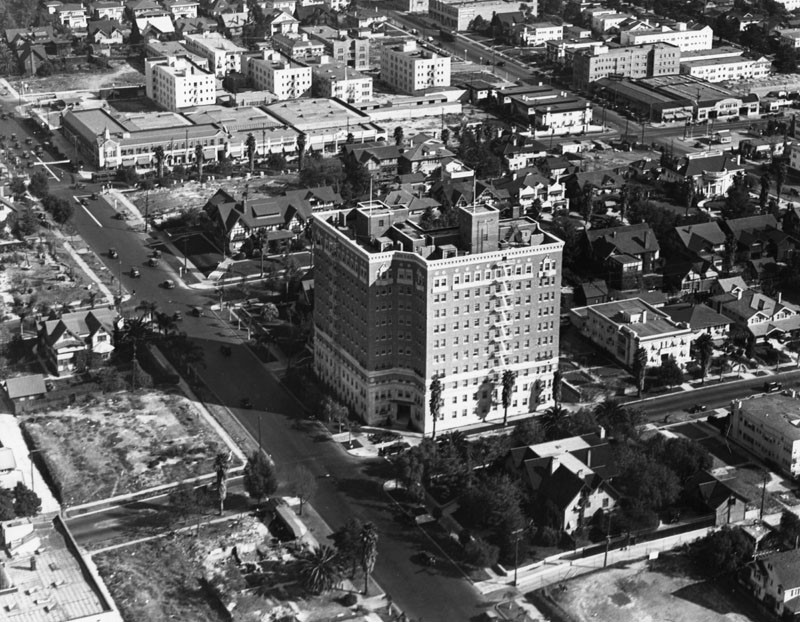 |
|
| (1924)* – Aerial view looking southeast showing The Talmadge Apartments located at 3278 Wilshire Boulevard. |
Historical Notes The Renaissance Revival-style building was designed by Architects Curlett and Beelman and completed in 1923. The building rose on the site of a Craftsman mansion designed for automobile dealer Earle C. Anthony in 1909 by legendary Pasadena architects Charles and Henry Greene. In 1923, the home was sold to actor Norman Kerry, who had it moved to North Bedford Drive in Beverly Hills. #^*# |
 |
|
| (ca. 1930s)* – Street view looking across Wilshire Boulevard showing the Talmadge Apartments on the southeast corner of Wilshire and Berendo Street. |
Historical Notes The elegant brick apartment tower bears the name of silent film actress Norma Talmadge. She and her husband, Hollywood producer Joseph Schenk, owned the building when it opened in 1924. The Talmadge opened with a summer garden party attended by socialites and business leaders. The Schenks lived for a time on the tenth floor. It remained an upscale address through the heyday of Wilshire Boulevard, attracting celebrities and dowagers who enjoyed attentive service. #^*# |
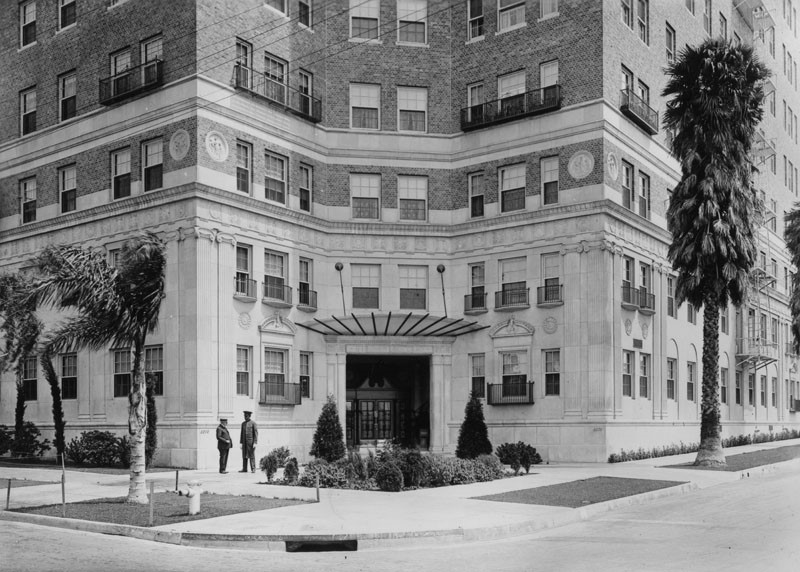 |
|
| (ca. 1940s)* – Close-up view showing the entrance to The Talmadge Apartments. Two men are seen standing in front of the building, one of which appears to be the doorman. |
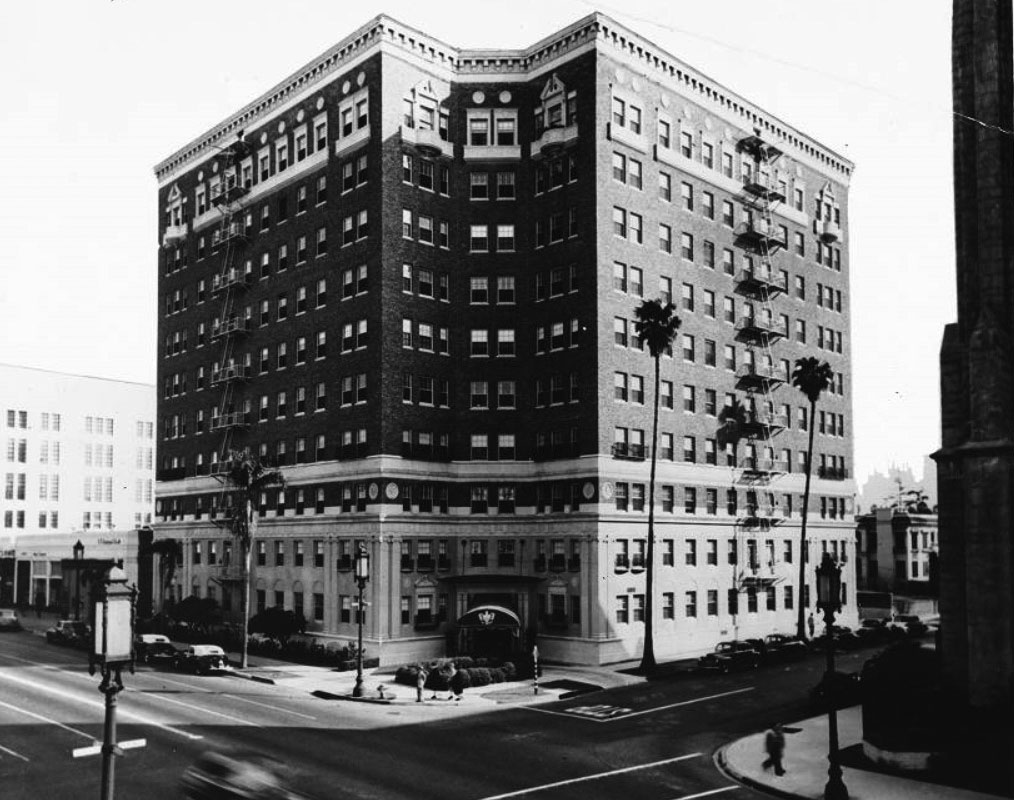 |
|
| (1952)^ - View of the Talmadge Apartments, southeast corner of Wilshire and Berendo. To the right can be seen the Immanuel Presbyterian Church (built in 1928). Note the height of the palm trees when compared to previous photos. |
Historical Notes Click HERE to see a contemporary view of the Talmadge Apartments. |
* * * * * |
George L. Crenshaw Residence
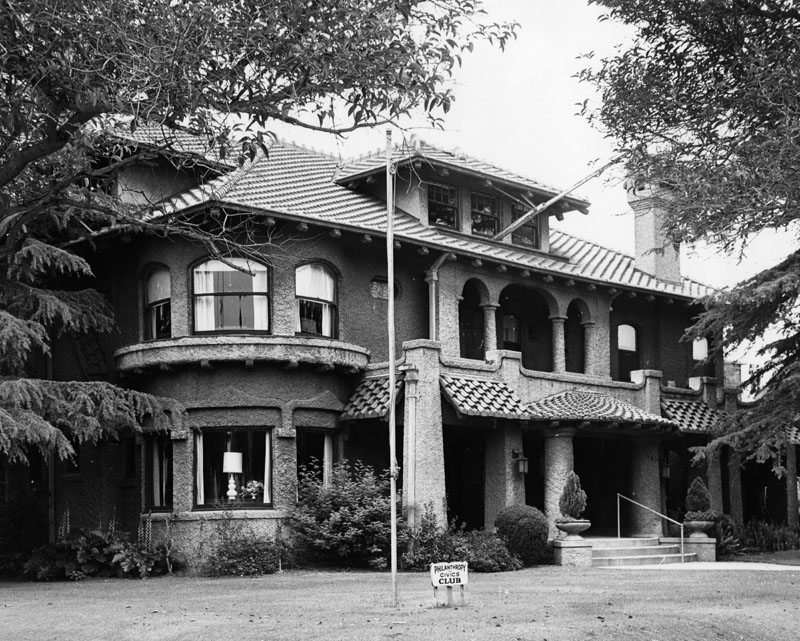 |
|
| (ca. 1924)* - Exterior view of the home once owned by George L. Crenshaw, located at 1419 S. Wilton Place. The roof and eaves are adorned with tiles, there is a slightly rounded dome on the left of the house, and arches on the second floor balcony. Above that, a dormer with three windows. The home became the Philanthropy and Civics Club clubhouse in 1924. A sign next to a flagpole on the front lawn reads, "Philanthropy and Civics Club". |
Historical Notes George L. Crenshaw was a banker and real estate developer who built several upscale residential developments in mid-city Los Angeles in the early 1900s. Among these was Lafayette Square and Wellington Square. The Crenshaw district of Los Angeles and its principal thoroughfare, Crenshaw Boulevard, bear his name.^* |
* * * * * |
First Church of Christ
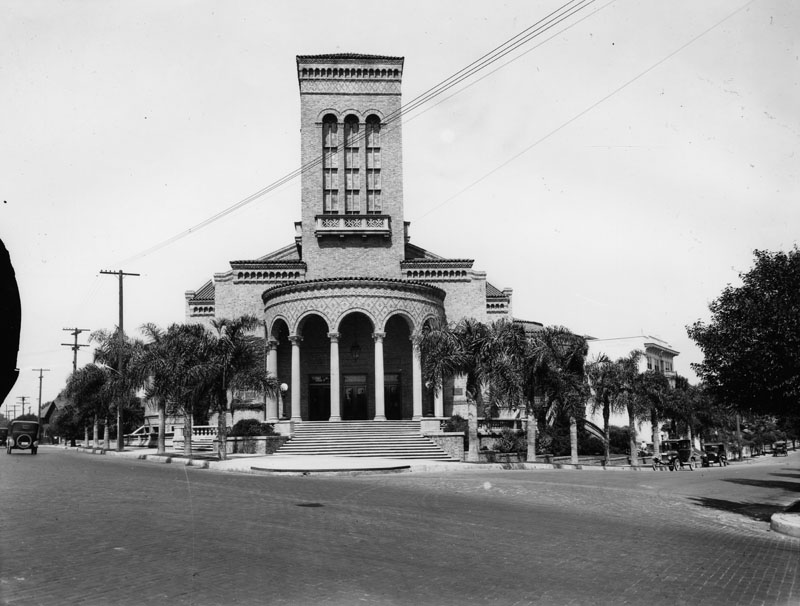 |
|
| (ca. 1920)* - View of the First Church of Christ from Hoover Street. Alvarado Street is on the left and Alvarado Terrace is on the right. |
Historical Notes Designed by architect Elmer Grey in the Beaux Arts/Italian/Spanish Romanesque style, the First Church of Christ, Scientist was constructed in 1912. It later became the Central Spanish Seventh-Day Adventist Church. It is Los Angeles Historic-Cultural Monument No. 89.* Click HERE to see the complete list of the LA Historic-Cultural Monuments. |
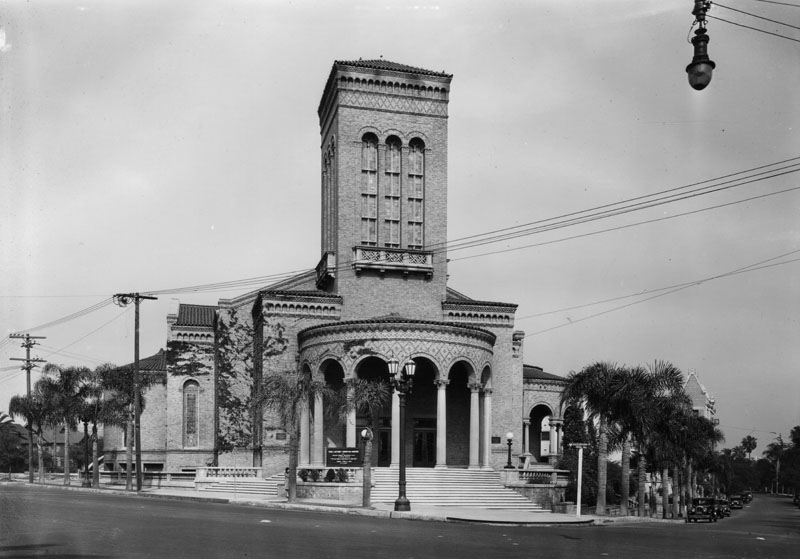 |
|
| (ca. 1925)* - Exterior view of First Church of Christ, Scientist, located at 1366 So. Alvarado Street. |
Historical Notes Now the Iglesia Adventista Central. For a time in the 1970s it served as the Los Angeles branch of the ill-fated Peoples Temple led by the Rev. Jim Jones. |
* * * * * |
B'nai B'rith Temple
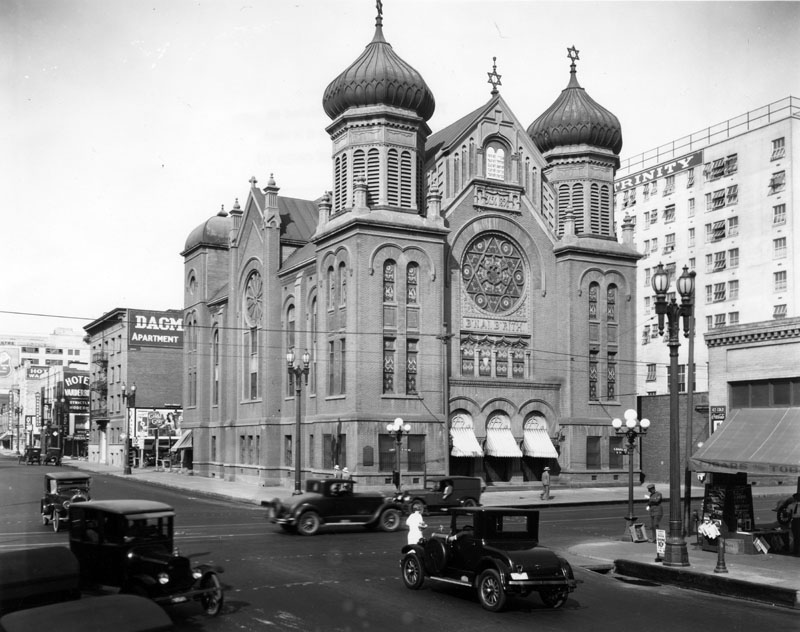 |
|
| (1926)* - Exterior view of the second B'nai B'rith Temple on the corner of 9th and Hope streets. Neighboring businesses, hotels and apartment buildings are visible all along Hope Street, which runs from the foreground to the left side of the image. |
Historical Notes Architect Abraham M. Edelman designed this synagogue, the second building for the congregation of B'nai B'rith. The cornerstone was laid on March 15, 1896 and it was dedicated on September 5th of the same year. The synagogue, which had seating for 600 people, was built of red brick with twin towers and pomegranate domes, its floors were carpeted in deep red with plush-cushioned pews and had a chandelier containing 60 bulbs, which made it the largest in the city. H.W. Hellman, Harris Newmark, Kaspare Cohn, and Mrs. J.P. Newmark presented the beautiful stained glass windows. This grand edifice was replaced in 1929 when Wilshire Boulevard Temple opened.* Congregation B'nai B'rith occupied its first building at Temple and Broadway in Downtown from 1862 until 1895.* Click HERE to see first location of B'nai B'rith Temple. |
* * * * * |
Wilshire Congregational Church (now Wilshire United Methodist Church)
 |
|
| (1925)*^*^ – View showing the Wilshire Boulevard Congregational Church still under construction, located at 4350 Wilshire Boulevard. Wilshire Boulevard appears to be unpaved. |
Historical Notes Designed by Allison & Allison and built in 1924-1925, the church was promoted by Portland Cement Association as being "all-concrete." The exterior has a Romanesque revival appearance, while the interior is reminiscent of the Gothic revival style.* |
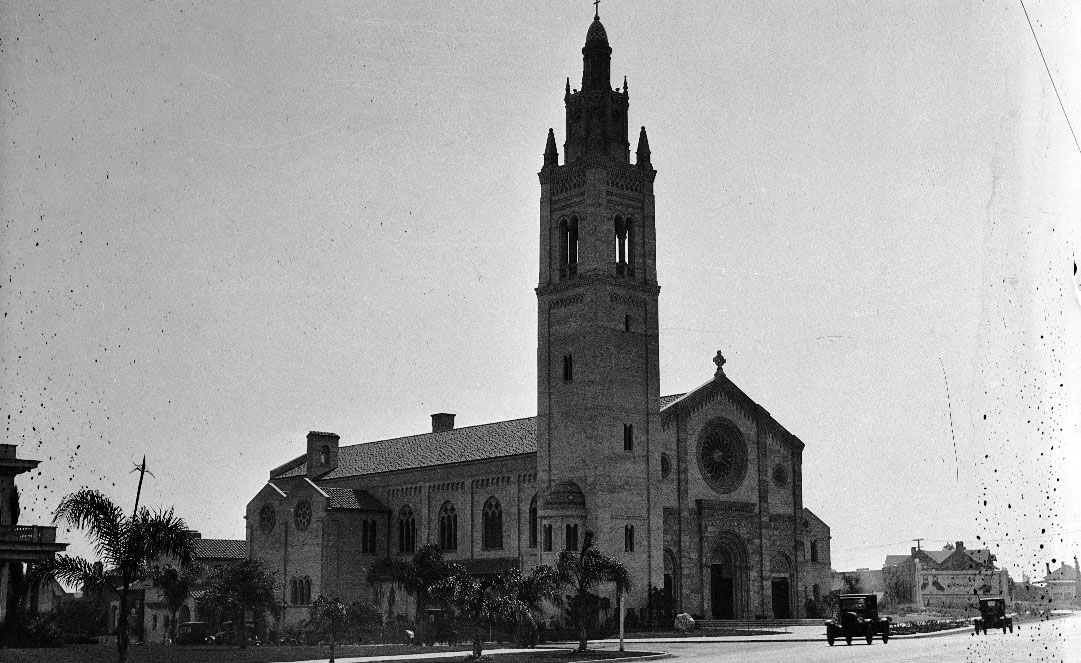 |
|
| (ca. 1925)*^*^ – View showing the Wilshire Boulevard Congregational Church shortly after its completion, located on the southwest corner of Plymouth and Wilshire Boulevards. |
Historical Notes The architects, Allison and Allison, who also designed First Congregational Church (540 S. Commonwealth), Janss Dome Building (1099 Westwood Blvd.), and buildings at UCLA, were known for their masterful use of concrete and fusion of Italian, Spanish, and Gothic styles, all in evidence here. #^*# |
.jpg) |
|
| (1925)* - Close up view of the Wilshire Boulevard Congregational Church (later Wilshire United Methodist Church). It was designed by Allison and Allison to have a Romanesque exterior with a Gothic interior. |
Historical Notes In its early years, the church's founding pastor, Frank Dyer, engendered great controversy by holding a jazz concert in the sanctuary and by staging a church fundraiser at the Olympic Auditorium that was to include prizefighter Jack Dempsey. #^*# |
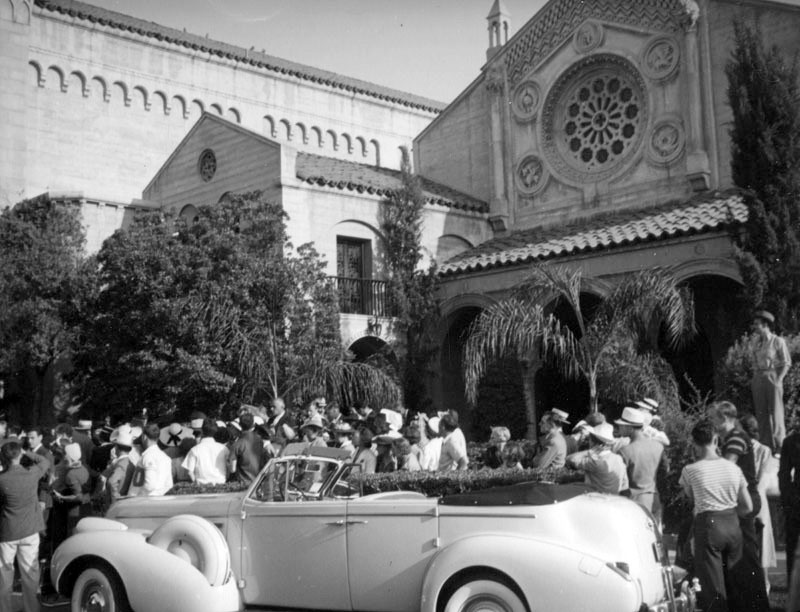 |
|
| (ca. 1939)* - A car is parked and crowds gather in front of the community hall of the Wilshire United Methodist Church, during what appears to be a wedding. |
Historical Notes In the 1930s and 1940s, the church became known for its celebrity contingent, hosting the weddings of Jeannette MacDonald in 1937 and seventeen-year-old Shirley Temple in 1945. #^*# |
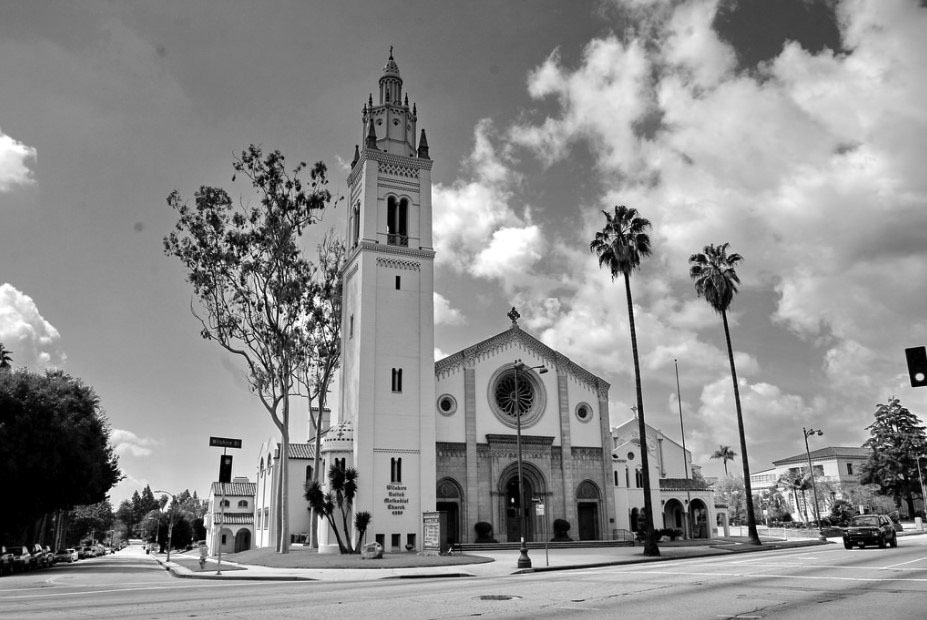 |
|
| (2010)^^** – View showing the Wilshire United Methodist Church as it appears today, SW corner of Wilshire and Plymouth Blvds. |
Historical Notes The church was designated a Los Angeles Historic-Cultural Monument in 1973 (No. 114). Located at 4350 Wilshire Blvd. in the Hancock Park neighborhood of Los Angeles. |
* * * * * |
Wilshire Christian Church
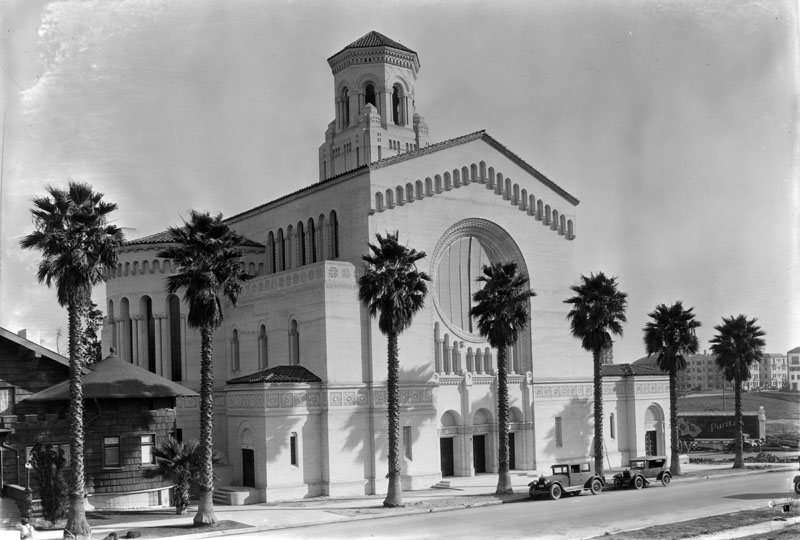 |
|
| (ca. 1927)* - Exterior view of the Romanesque Revival style Wilshire Christian Church during its construction, as seen from the western side of Normandie Avenue. The church's large rose window designed by Judson Studios has yet to be installed, but the window opening has been covered to protect the interior of the structure. |
Historical Notes After land was donated by Charles Chapman in 1911, a small bungalow style church was built at this corner of Wilshire Boulevard and Normandie Avenue. In 1927 the original church was replaced by this Northern Italian Romanesque style structure with a 200-foot tower, designed by Robert H. Orr.* Charles Clarke Chapman (1853–1944) was the first mayor of Fullerton, California and a relative of John Chapman, the legendary "Johnny Appleseed." He was a native of Illinois who had been a Chicago publisher before settling in Southern California. Chapman was a supporter of the Disciples of Christ, who was a primary donor and fundraiser for California Christian College, which in 1934 changed its name to Chapman College, and is now Chapman University, in his honor.^* |
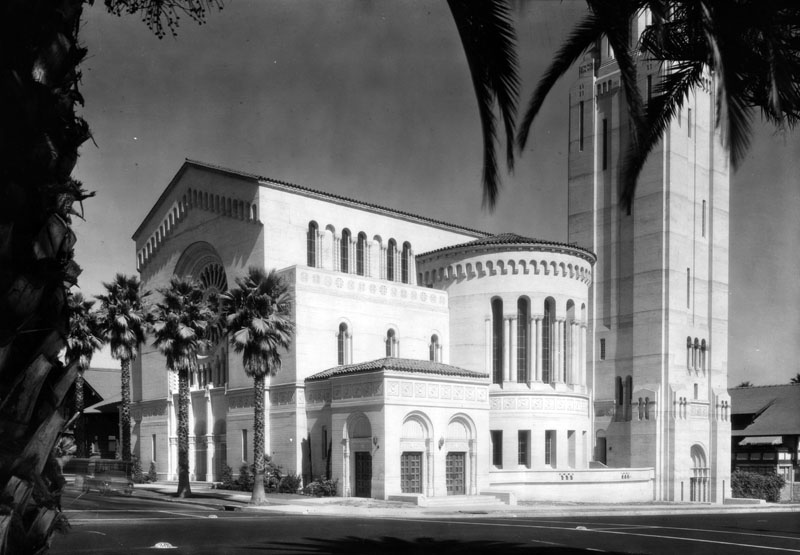 |
|
| (ca. 1927)* - Exterior view of the Romanesque Revival style Wilshire Christian Church, as seen from the southwest corner of the intersection of Normandie Avenue and Wilshire Boulevard not long after it was constructed in 1927. |
Historical Notes Located at 634 S. Normandie Avenue, the church was designated Los Angeles Historic-Cultural Monument No. 209 (Click HERE to see complete listing). |
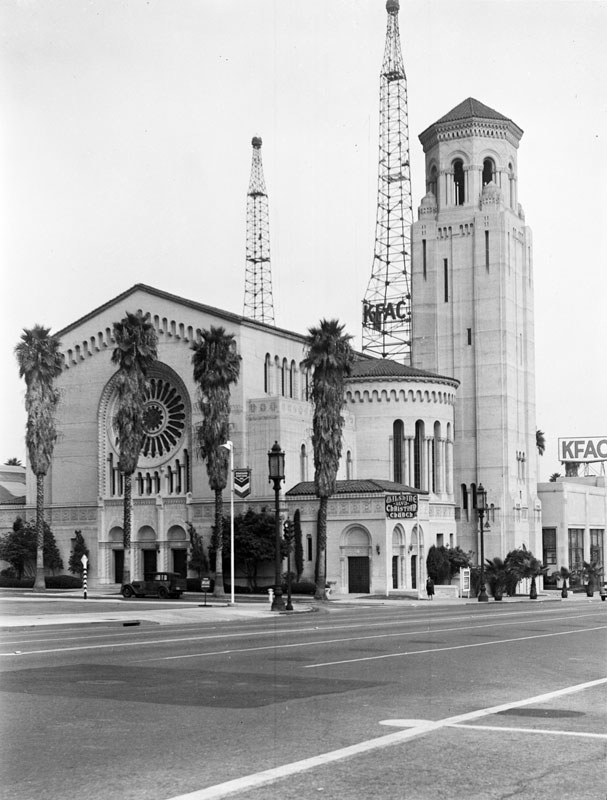 |
|
| (ca. 1930)* - Exterior view of the Wilshire Boulevard Christian Church taken from across Wilshire Boulevard. Located at 634 S. Normandie Avenue. The two towers for KFAC, a radio station next door, are visible. |
Historical Notes On May 19, 1940, First Christian Church of Los Angeles merged with Wilshire Boulevard Christian Church to become Wilshire Christian Church, which is of the Disciples of Christ denomination.* |
* * * * * |
Los Angeles Stock Exchange
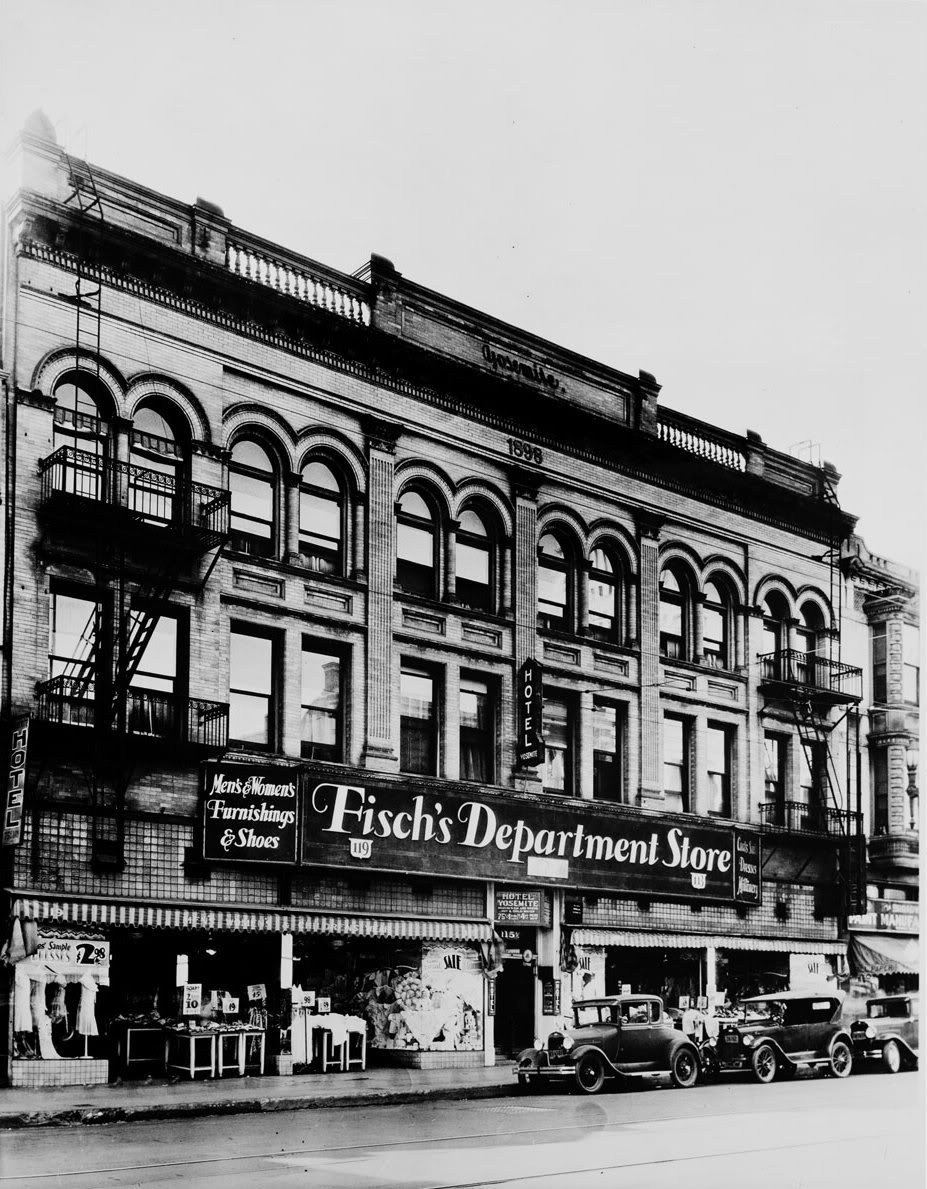 |
|
| (ca. 1927)^ - View of the Yosemite Building located at 115 South Broadway. This was the first home of the Los Angeles Stock Exchange in 1900. |
Historical Notes On December 7, 1899, a group of oil men lead by Wallace Libby Hardison met to organize the Los Angeles Oil Exchange to promote their industry, figure out how to get more investments, and set up a marketplace for related securities. The Exchange’s first trading session was on February 1, 1900, in the Yosemite Building on South Broadway, with seats selling for fifty bucks. At the end of the year, on December 23, the powers-that-be broadened the market’s services and renamed it the Los Angeles Stock Exchange.***# |
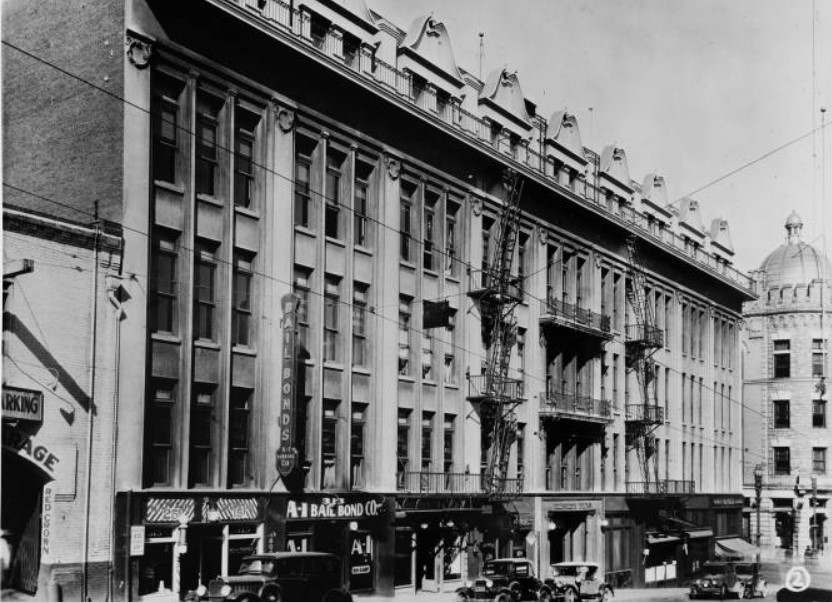 |
|
| (1930s)^ - View looking east on First Street showing the second home of the Los Angeles Stock Exchange. It was located on the second floor of the Tajo building, 307 West First Street. The LA Times building is seen at right on the corner of First and Broadway. |
Historical Notes The Exchange had relocated to half a dozen different locations in the city (including the Buildings Tajo, Hellman, and Chamber of Commerce) when, in early May 1929, the market bought the Strong & Dickinson (formerly Meredith) Building at 618 South Spring.***# |
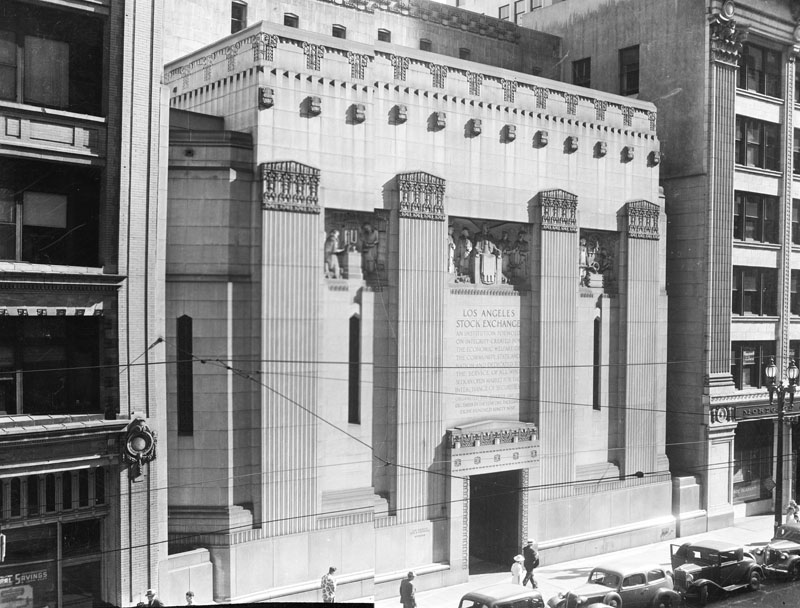 |
|
| (1939)* - Exterior view of the Los Angeles Stock Exchange Building at 618 South Spring Street on May 5, 1939, ten years after it was built. |
Historical Notes Built in 1929, the eleven-story exchange building was designed by Samuel Lunden in the Moderne style. Ground was broken in October 1929, just as the Great Depression hit, and when the Los Angeles Stock Exchange opened its doors there in 1931, the country was deep into the Depression. The Stock Exchange would stay in this building until 1986.^* On January 3, 1979, the Los Angeles Stock Exchange Building was designated LA Historic-Cultural Monument No. 205 (Click HERE to see complete listing). |
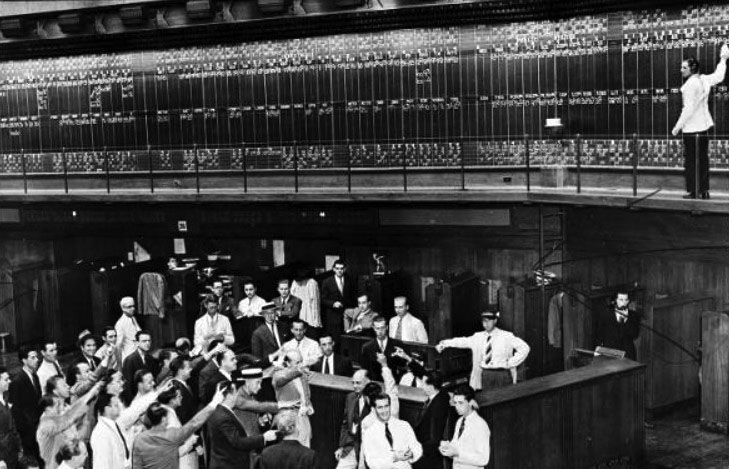 |
|
| (1938)^ - Stock brokers on the floor of the Los Angeles Stock Exchange at 618 S. Spring Street. |
* * * * * |
Temple Block to City Hall
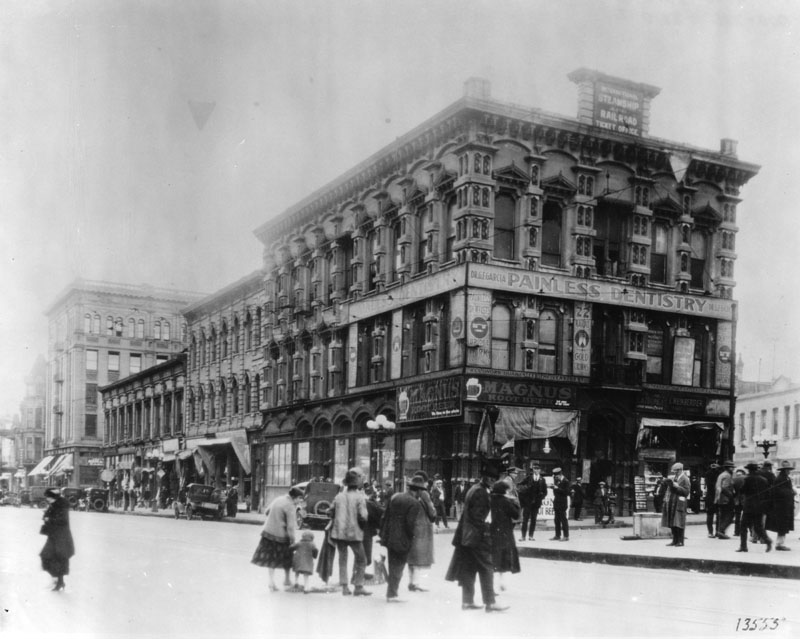 |
|
| (ca. 1926)* - Temple Block as it appeared just one year before construction of today's City Hall. |
Historical Notes This site, at the intersection of Spring, Main and Temple, is where John Temple built his original two-story adbobe two-story adobe in the early 1800s. Jonathan Temple was one of Los Angeles’ first developers, constructing the original Temple Block and the Market House, which later served as city and county administrative headquarters, contained the county courthouse, and featured the first true theater in southern California. Temple Street carries his name.^* The Old Courthouse occupied Temple Block between 1861 and 1891.* |
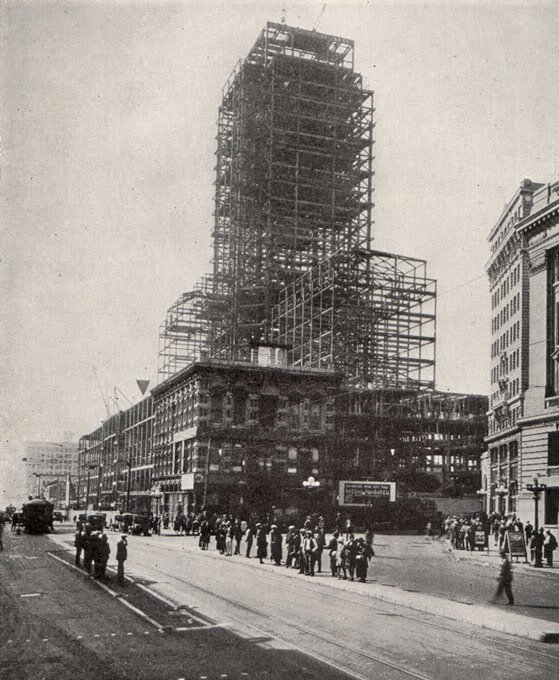 |
||
| (1927)^*^* - The last stand of the historic Temple Block. As the steel frame of the new City Hall neared completion the proud building, once dominant in the business and professional life of the city, was razed. |
Click HERE to see more of Construction of Today's City Hall |
* * * * * |
LA Evening Express and Everning Herald Building (later LA Herald-Express Building)
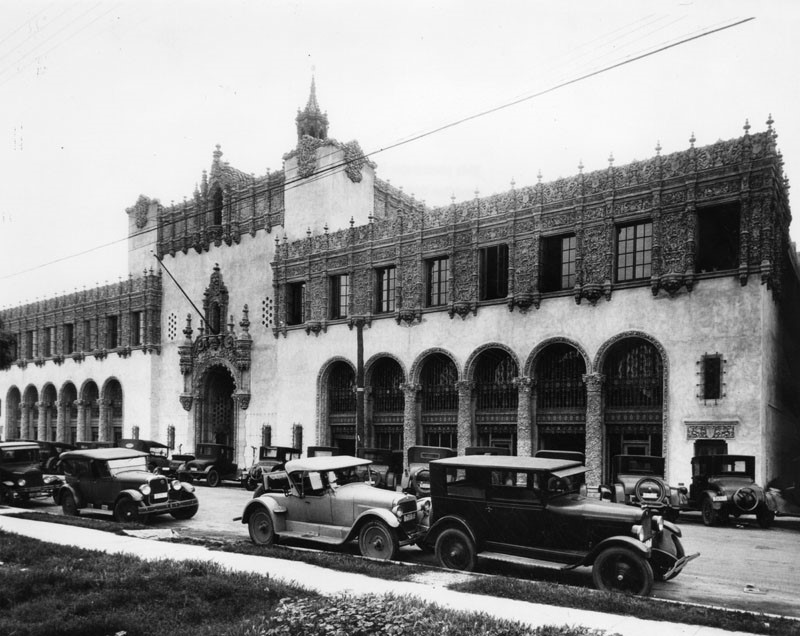 |
|
| (1926)* – View showing the Los Angeles Evening Express and Evening Herald Building, later the Los Angeles Herald-Express Building, located at 1243 Trenton Street. Photo dated July 21, 1926. Another source indicates the building was located on Georgia St, in downtown Los Angeles, between 12th and Pico (behind where the Staples Center is now).* |
Historical Notes The Mediterranean/Churrigueresque structure was designed by Morgan, Walls & Clements and built in 1925. When the Los Angeles Evening Herald and Express merged, it became the Herald-Express Building. |
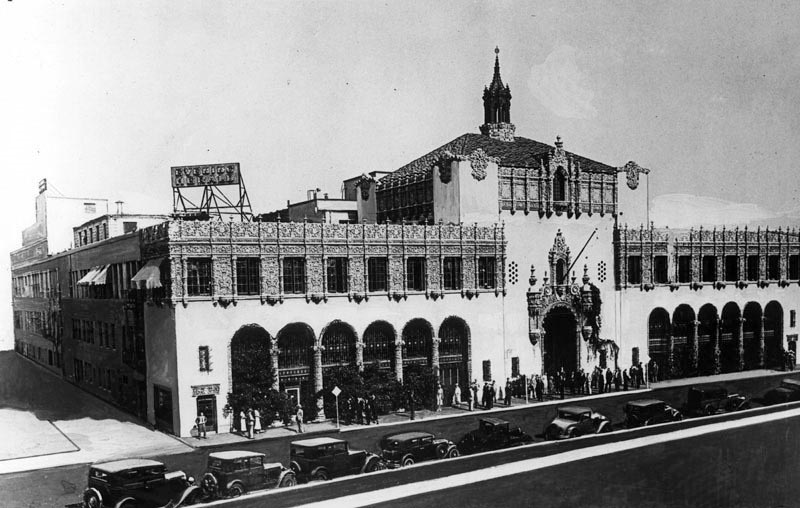 |
|
| (1926)*- Looking across the street towards the Los Angeles Evening Express and Evening Herald Building showing dozens of people by the front entrance. |
Historical Notes Established in 1873, the Los Angeles Herald represented the largely Democratic views of the city and focused primarily on issues local to Los Angeles and Southern California. Appealing to a mostly working-class audience during its 116 years of publication, the Herald evolved from a primary focus on agriculture to reporting extensively on Hollywood gossip and local scandal, reflecting the transformation of Los Angeles itself during the twentieth century. ^* |
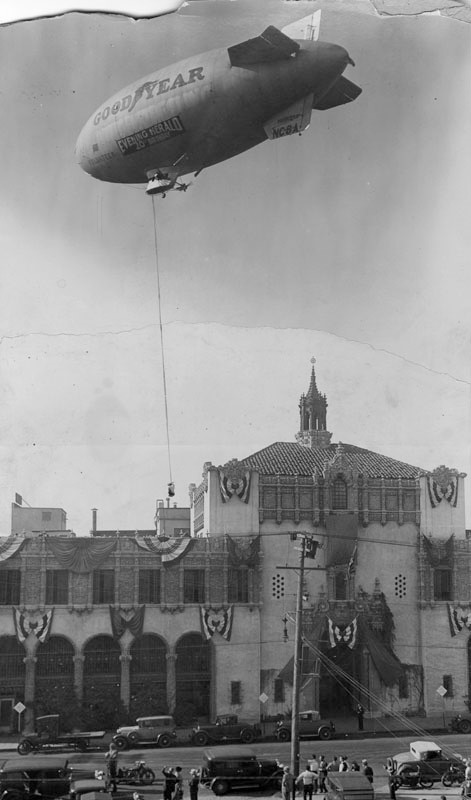 |
|
| (1931)* - Photograph caption dated November 5, 1931 reads, "Photo shows the Goodyear blimp 'Volunteer' soaring over The Evening Herald building today and picking up a bundle of Twentieth Birthday editions for delivery to civic officials at the city hall. The blimp dropped a rope weighed with a sandbag to the roof of the Evening Herald building. While the ship slowly passed over, two men running across the roof unhooked the sandbag and hooked on a bag containing the papers. The blimp then hauled the bag aboard, roared away and on reaching the city hall let the bag down on the end of the rope." |
Historical Notes In 1922, the Herald officially joined the Hearst News empire, although several sources suggest that Hearst had secretly purchased the paper in 1911. In 1931, Hearst merged the Los Angeles Daily Herald with the Los Angeles Evening Express to form the Los Angeles Evening Herald and Express, which was then the largest circulating evening newspaper west of the Mississippi. |
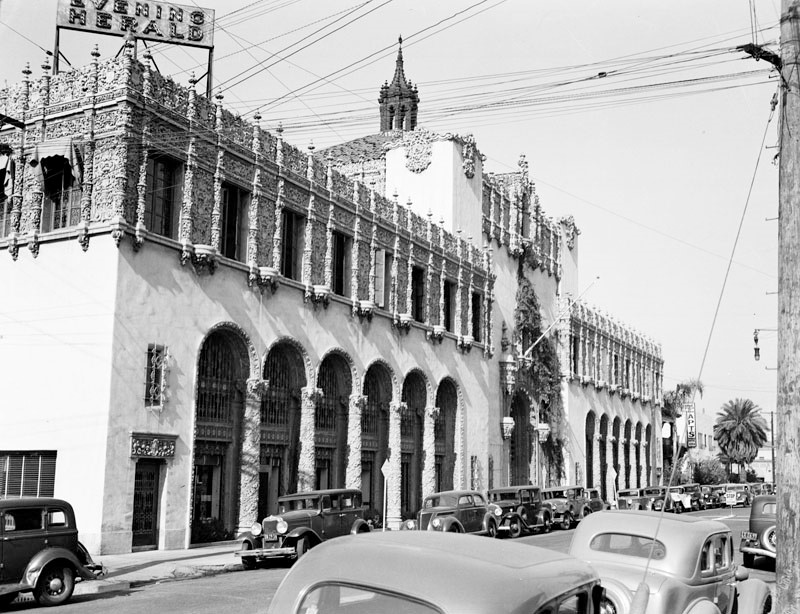 |
|
| (1937)* - View showing the Mediterranean style (with Churrigueresque detailing) Herald-Express Building. |
Historical Notes The Los Angeles Herald-Express was one of Los Angeles' oldest newspapers, formed after a combination of the Los Angeles Herald and the Los Angeles Express. After a 1962 combination with Hearst Corporation's Los Angeles Examiner, the paper became the Los Angeles Herald-Examiner. All operations were moved to the 1914-built Examiner Building located at 1111 S. Broadway. The Herald-Express Building used to stand on Georgia St, in downtown Los Angeles, between 12th and Pico (behind where the Staples Center is now). It was demolished in the mid-to-late 1960s.* |
* * * * * |
Hotel Figueroa
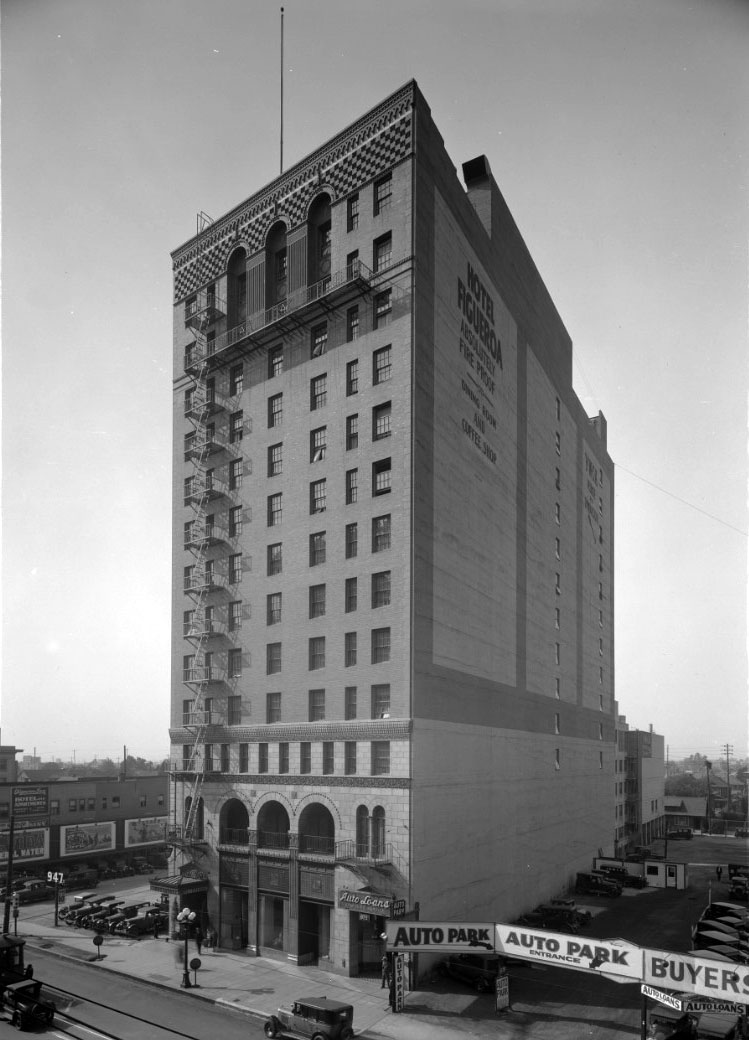 |
|
| (1925)^*# – View showing the newly constructed Figueroa Hotel located at 941 So. Figueroa St. |
Historical Notes Built in 1925, Hotel Figueroa was the first hotel to be completely financed, owned and operated by women in the United States. The YWCA (Young Women’s Christian Association) hired architecture firm Stanton, Reed & Hibbard to design and build the hotel. The Spanish Colonial style of the hotel pays tribute to the city’s Spanish and Mexican heritage. Defining features include the elaborate coffered ceiling, sculpture columns, wrought iron finishes, and ornate floor tiles.^ The Friday Morning Club was built directly across the street from the Hotel Figueroa in 1924. It was also financed and run by women. The two are a microcosm of the increasingly important and complex roles women were playing in American society in the 1920s. |
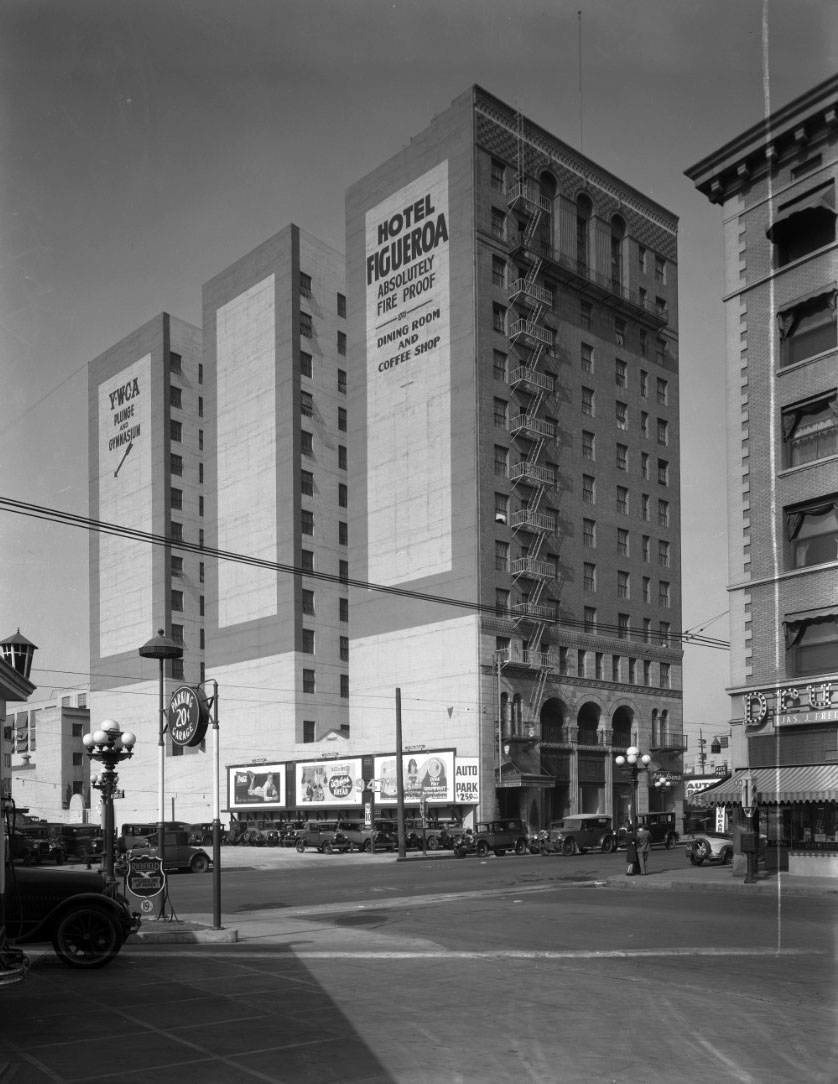 |
|
| (1925)^*# – View showing the Hotel Figueroa as seen from a gas station on the SE corner of Figueroa St. and 10th Street (later *Olympic Blvd). Signs on the side of the building read: ‘Hotel Figueroa - Absolutely Fire Proof’ and ‘YWCA – Plunge and Gymnasium’. Note the ornate 5-lamp streetlights. Click HERE for contemporary view. |
Historical Notes *Olympic Boulevard was originally named 10th Street. In 1932, the entire length of the street, from East L.A. to Santa Monica, was renamed Olympic Boulevard for the Summer Olympics being held in Los Angeles that year. |
.jpg) |
|
| (1931)^.^ – View looking north on Figueroa Street showing several women standing in front of Hotel Figueroa. Note the 5-globe streetlight in front of the hotel. Click HERE to see more. |
Historical Notes Originally the hotel only hosted travelling business women and their children. However, as effects of the Great Depression were becoming more severe, Hotel Figueroa started to accommodate men.^ |
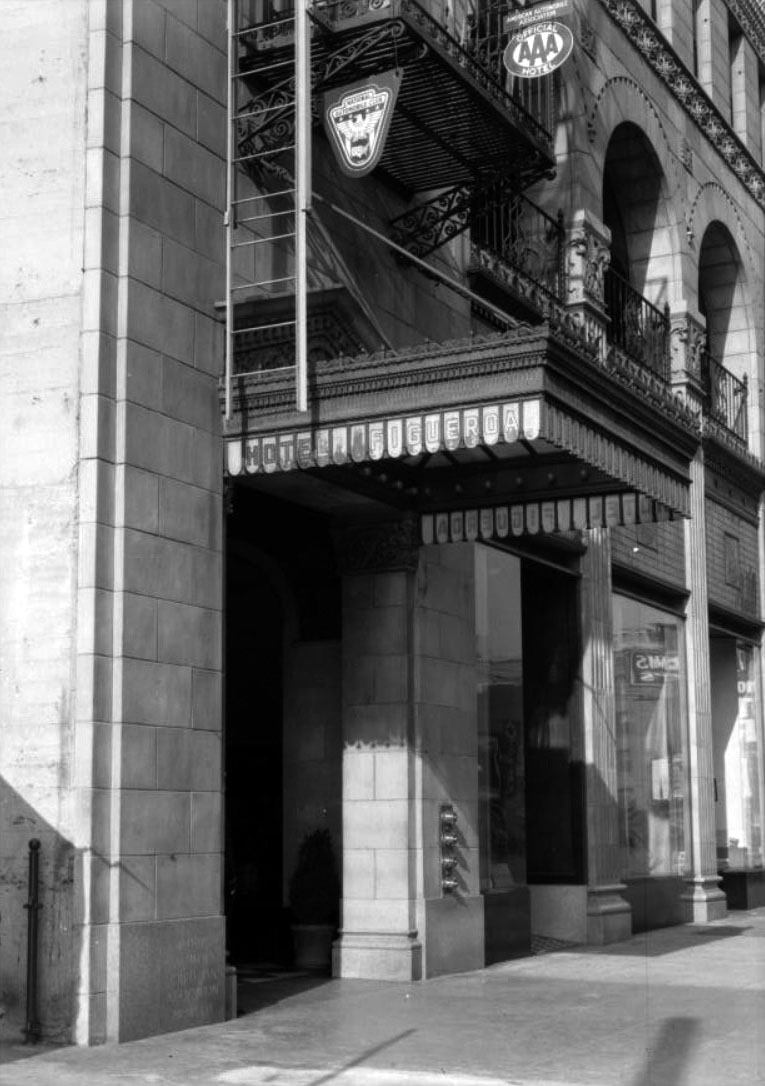 |
(1931)^ – Close-up view showing entrance to the Hotel Figueroa. A sign above the canopy reads: 'Official AAA Hotel'. | |
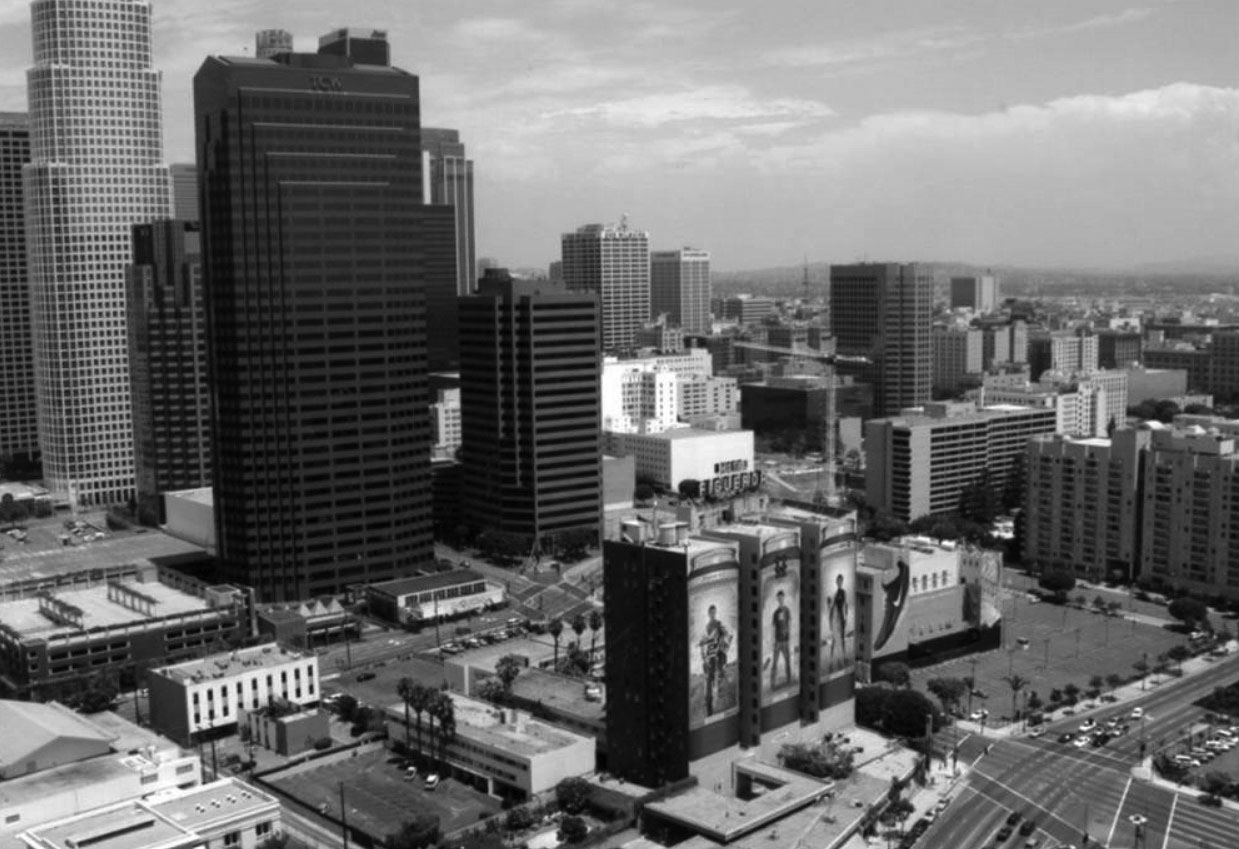 |
|
| (2005)* - Panoramic view of Downtown Los Angeles looking northeast with the Hotel Figueroa in the foreground, NW corner of Figueroa and Olympic. Murals, showing three male athletes and a Nike brand shoe announcing the ESPN X Games, can be seen painted on the south face of the hotel. |
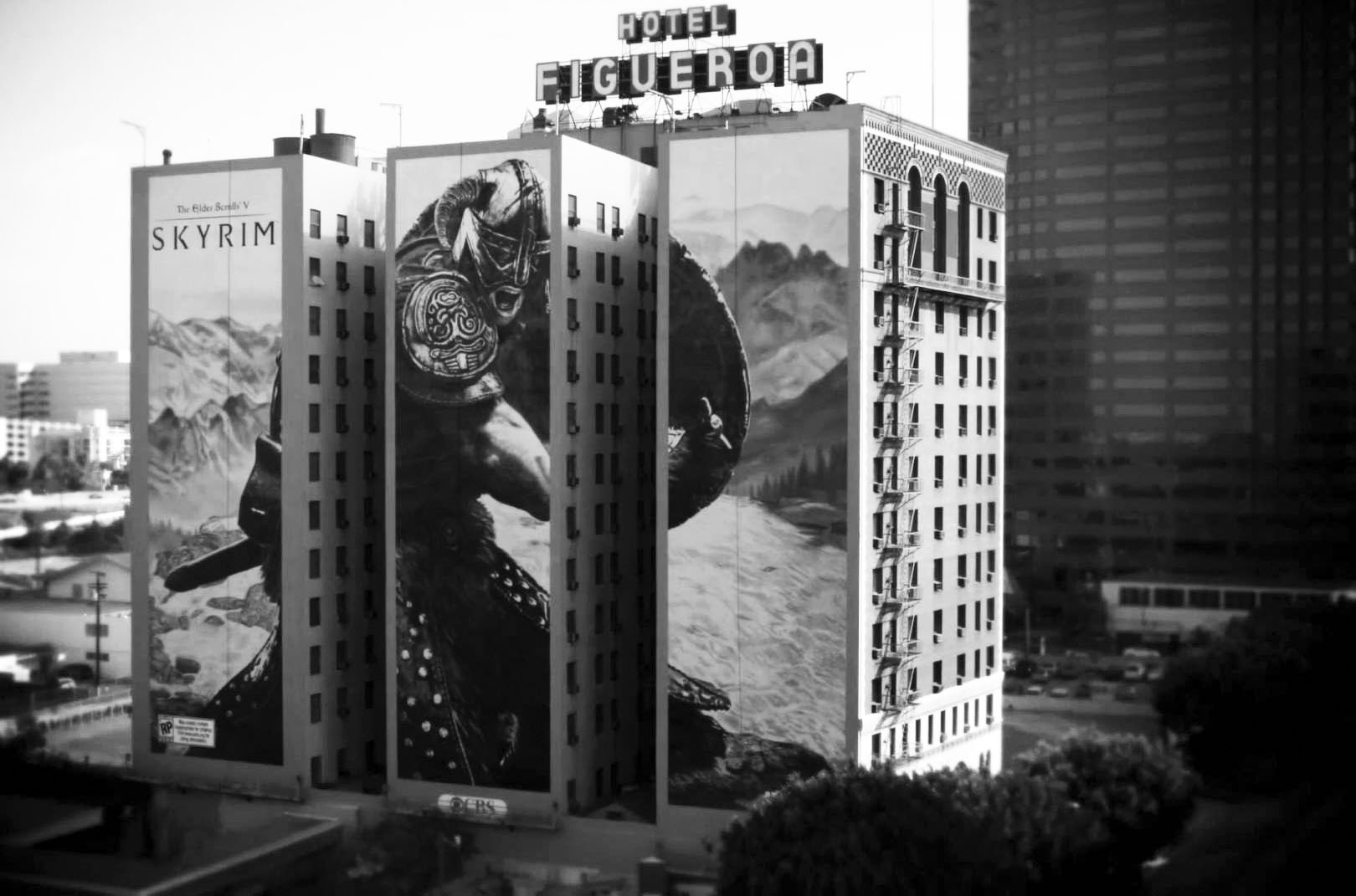 |
|
| (2010)^.^ – View of 12-story, triple towers Hotel Figueroa and its south face wall murals. |
Historical Notes Hotel Figueroa Historical Timeline: ◆ August 14, 1926 opened as Hotel Figueroa, for women only ◆ February 1928, Hotel Figueroa opened floors for men ◆ October 1930, Hotel Figueroa opened to all sexes ◆ 1931-1958 Hotel Figueroa is a hub of creative community, political organizations and social clubs in DTLA ◆ 1959-1976 Hotel Figueroa (and DTLA) operates as a semi-permanent residential hotel as the once dynamic downtown neighborhood experiences westward migration of offices and residents ◆ February 1976, Uno Thimansson takes over Hotel Figueroa as General Manager, begins transforming it into a “Moroccan retreat.” ◆ July 2014 Hotel Figueroa is purchased by Green Oak Real Estate and Urban Lifestyle Hotels, begins 3 year restoration to original Spanish Colonial Revival style ◆ February 2018: Reopens to the public^ |
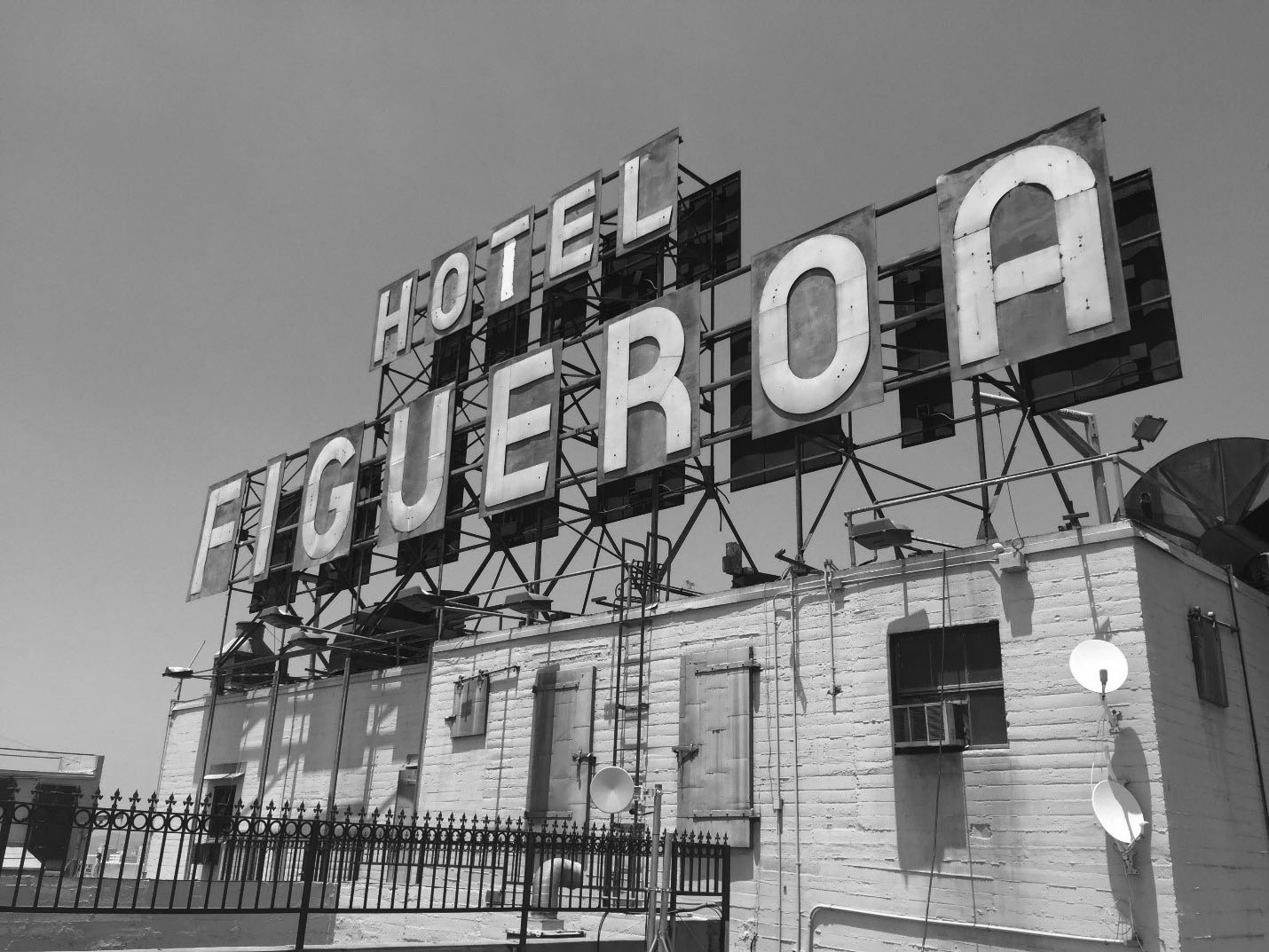 |
|
| (2010s)^.^ - Close-up view of the Hotel Figueroa's roof-mounted sign. |
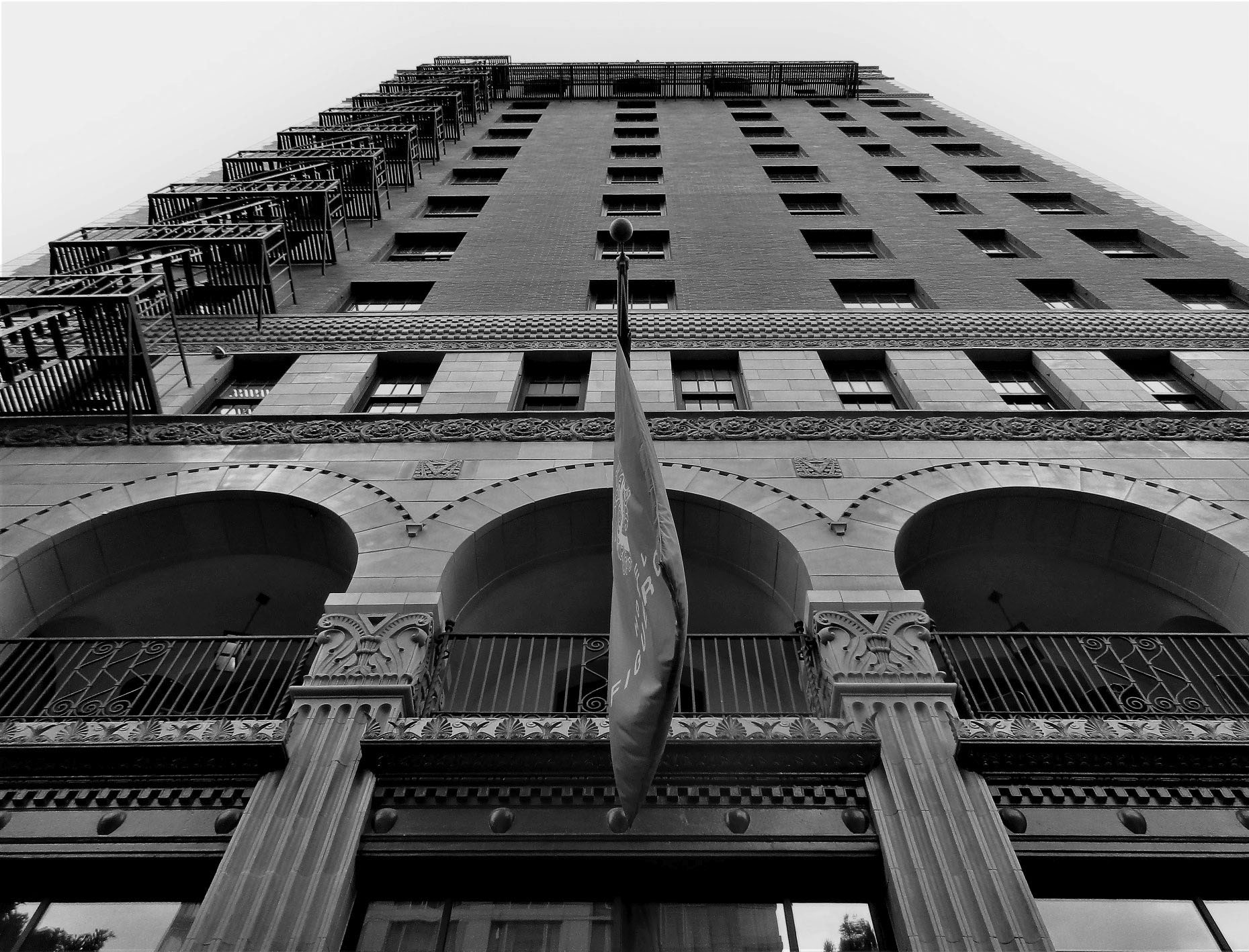 |
|
| (2019)^.^ - Looking up to the top of the Figueroa Hotel from the sidewalk in front. Photo by Howard Gray |
* * * * * |
Patriotic Hall
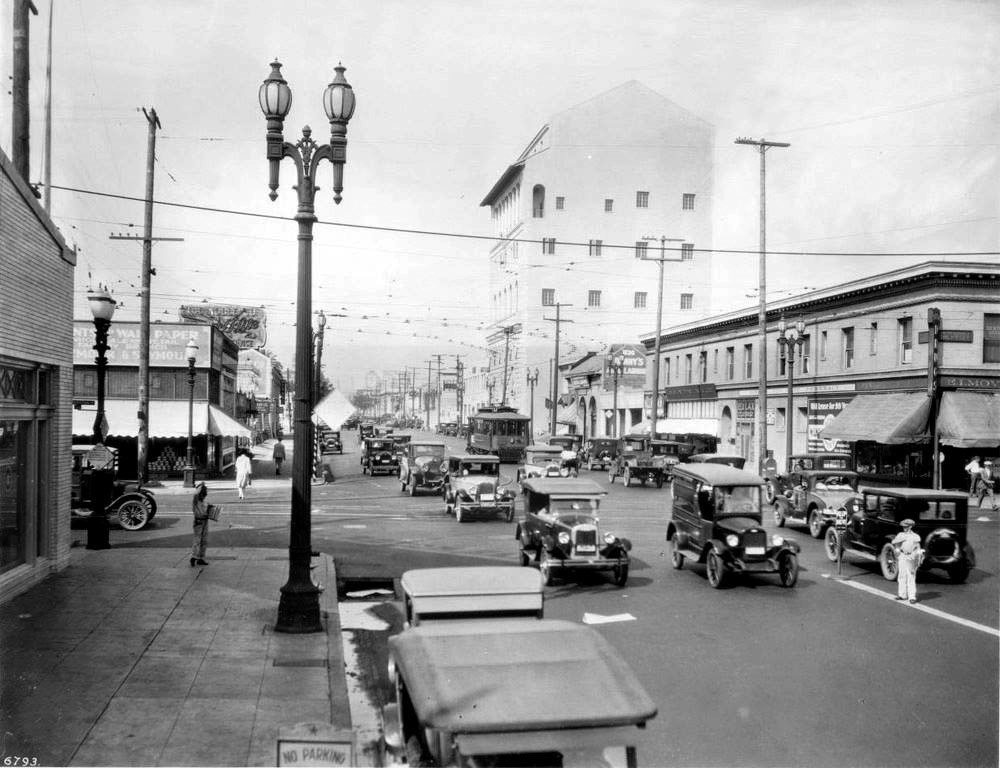 |
|
| (ca. 1927)^ - View looking north on Figueroa from just south of Washington Boulevard. A paperboy dressed in light-colored clothing stands at the center of the street to the right hawking papers while cars pass him on either side. The large building in the background is the Patriotic Hall. |
Historical Notes The Allied Architects Association of Los Angeles designed Patriotic Hall in the Italian Renaissance Revival style. When completed in 1926, the building was the tallest in all of Los Angeles, at the equivalent of twelve stories. ^ |
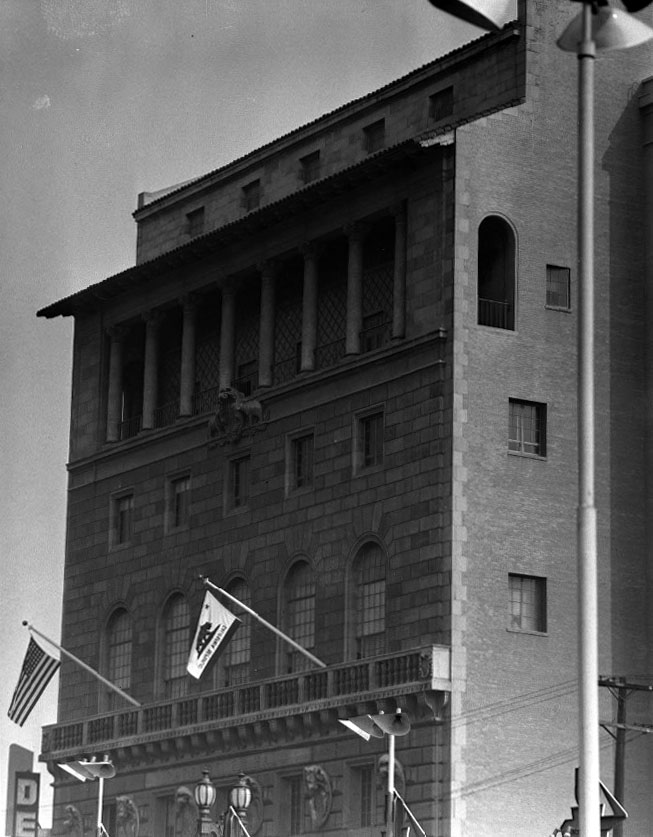 |
|
| (ca. 1940s)^ – View showing Patriotic Hall, headquarters and meeting place of various service organizations. LA Times / UCLA Image Archive |
Historical Notes Patriotic Hall housed service members on leave during World War II. It also hosted top performers who entertained the troops, including Bob Hope, Bing Crosby, and Dorothy Lamour. |
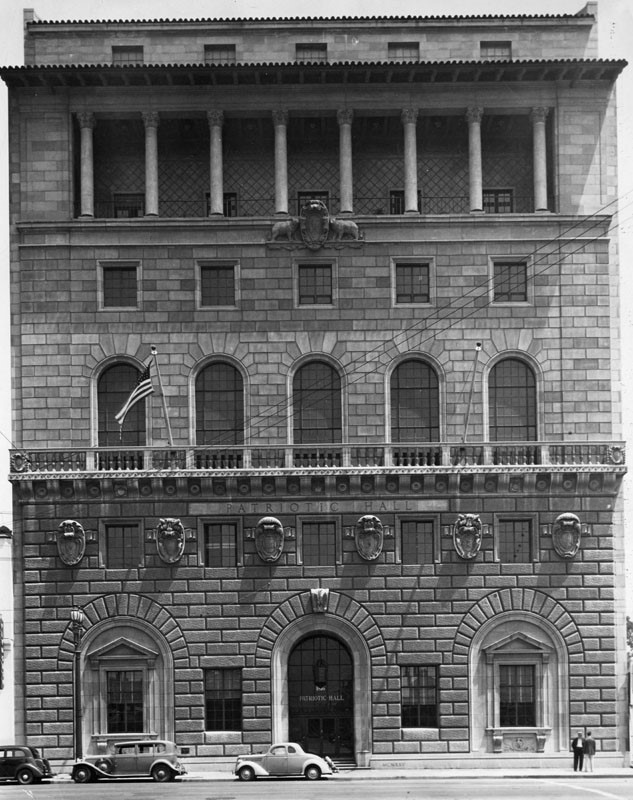 |
|
| (1937)* – View showing the front entrance to Patriotic Hall located at 1816 S. Figueroa Street. |
Historical Notes The building also housed the City’s municipal courts in the 1940s, as new ones were being constructed. During the Korean War, it served as a processing center for the Army and Air Force. ^ |
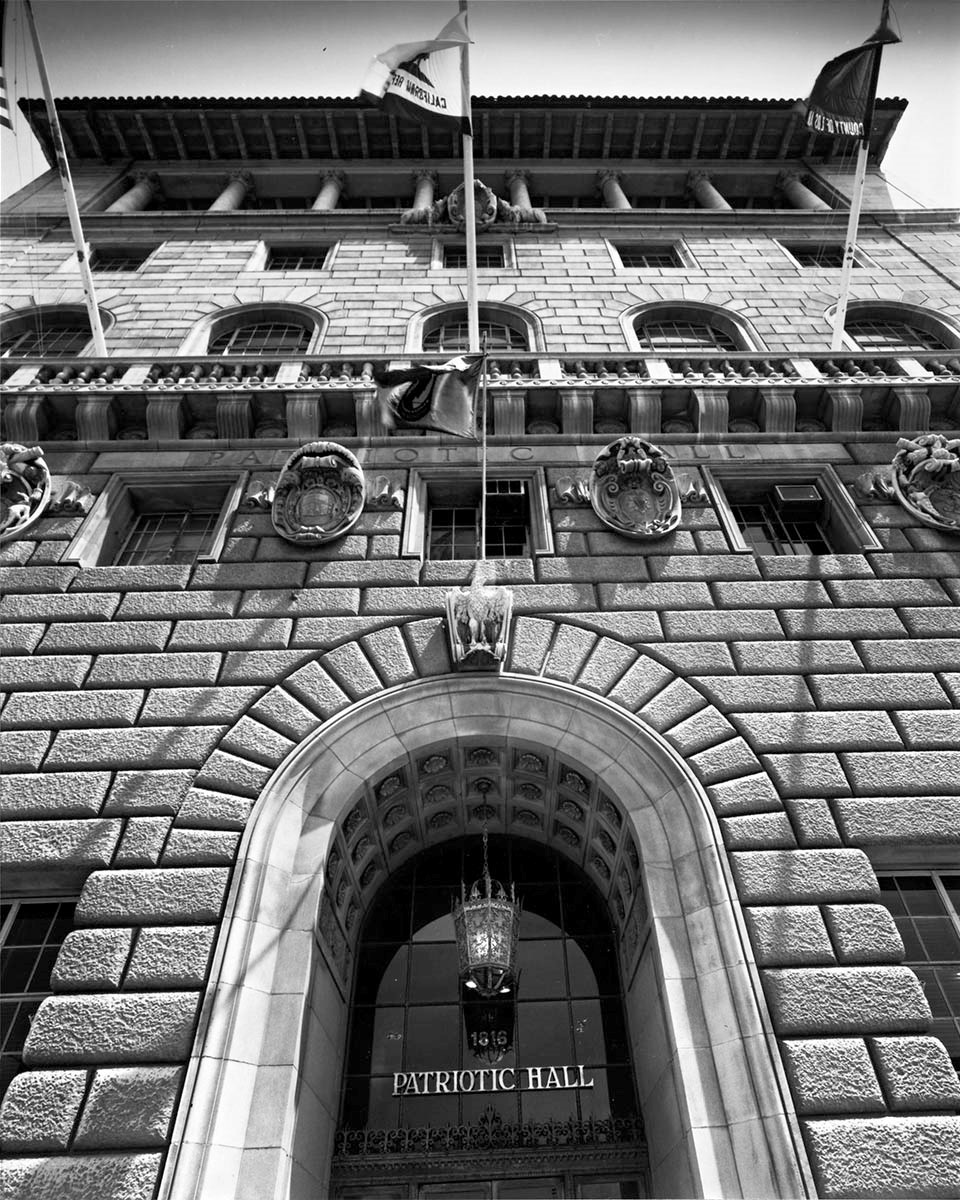 |
|
| (1985)*++ - View looking up towards the top of Patriotic Hall. Photo by Julius Shulman |
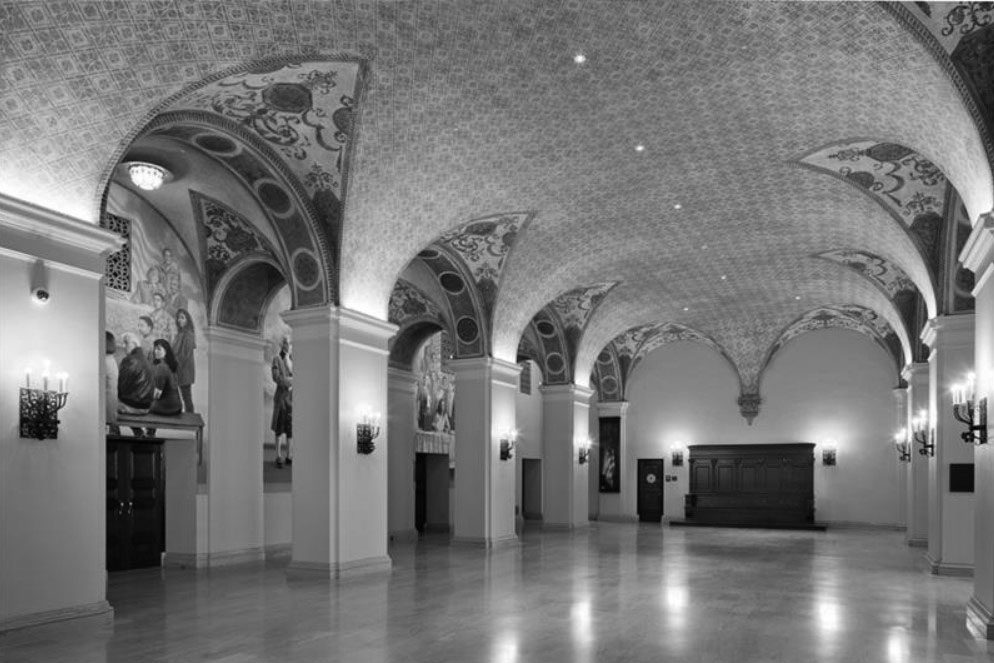 |
|
| (ca. 2012)^+^ – View showing the Bob Hope Patriotic Hall grand lobby after renovation. |
Historical Notes On November 12, 2004, the building was renamed “Bob Hope Patriotic Hall” in honor of Bob Hope an honorary veteran of the U.S. Armed Forces. Over the years, Bob Hope Patriotic Hall fell into disrepair. Its infrastructure and systems were sorely out of date, and it suffered from deferred maintenance. In 2006, the County of Los Angeles fundraised for the rehabilitation of the facility, a project with a budget of over $75 million. The project entailed a large-scale, comprehensive interior and exterior rehabilitation. Internally, the project team restored wood doors and hardware, marble finishes, ceramic tile, decorative plaster and painting, murals, and auditorium and gymnasium seats. Externally, the team restored and repaired all historic features, including cast stone, granite, brick masonry, terrazzo, steel windows and hardware, metal skylights, wrought iron doors, metal fire escapes and railings, decorative metal louvers and grilles, copper cornice and gutters, clay tile roof, plaster, decorative painting and stenciling, stained glass, and light fixtures. ^ |
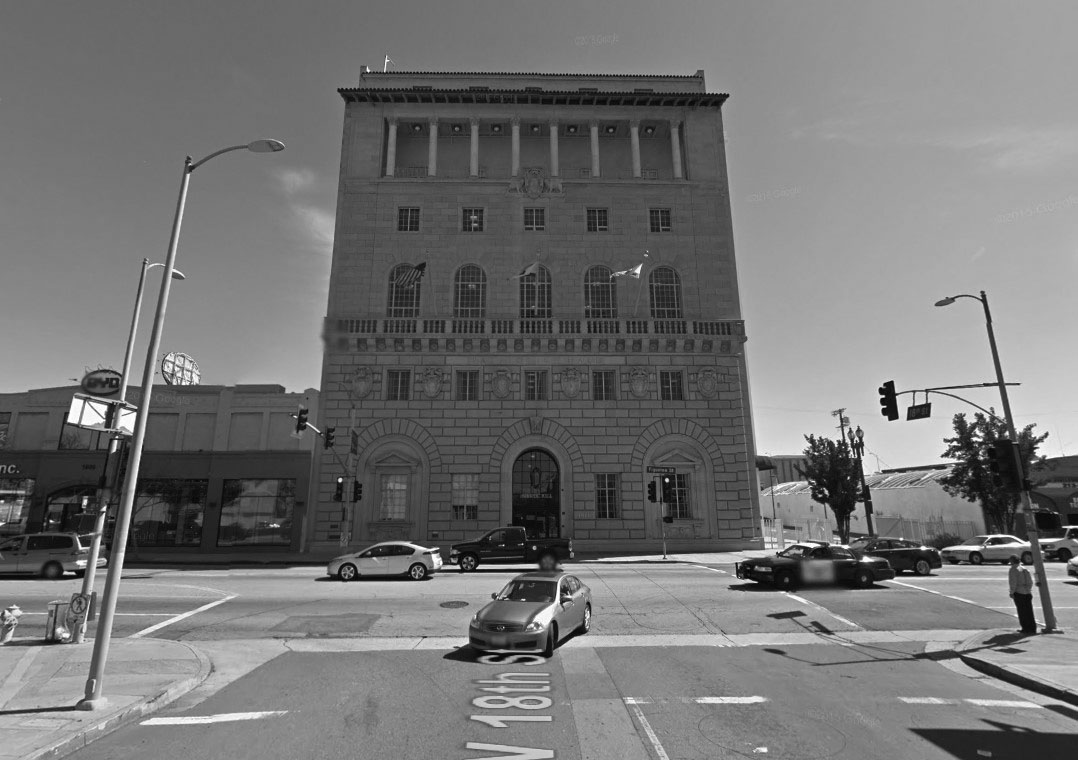 |
|
| (2015)#^** – Google street view showing the Patriotic Hall located where 18th Street meets Figueroa Street.. |
Historical Notes The building’s restoration project preserved one of Los Angeles’ most prominent, highly visible historical facilities, earning a Conservancy Preservation Award in 2014. Bob Hope patriotic Hall now enjoys new life as a multipurpose facility, with ample meeting and conference space for veterans and others in the community to meet and recreate.^ |
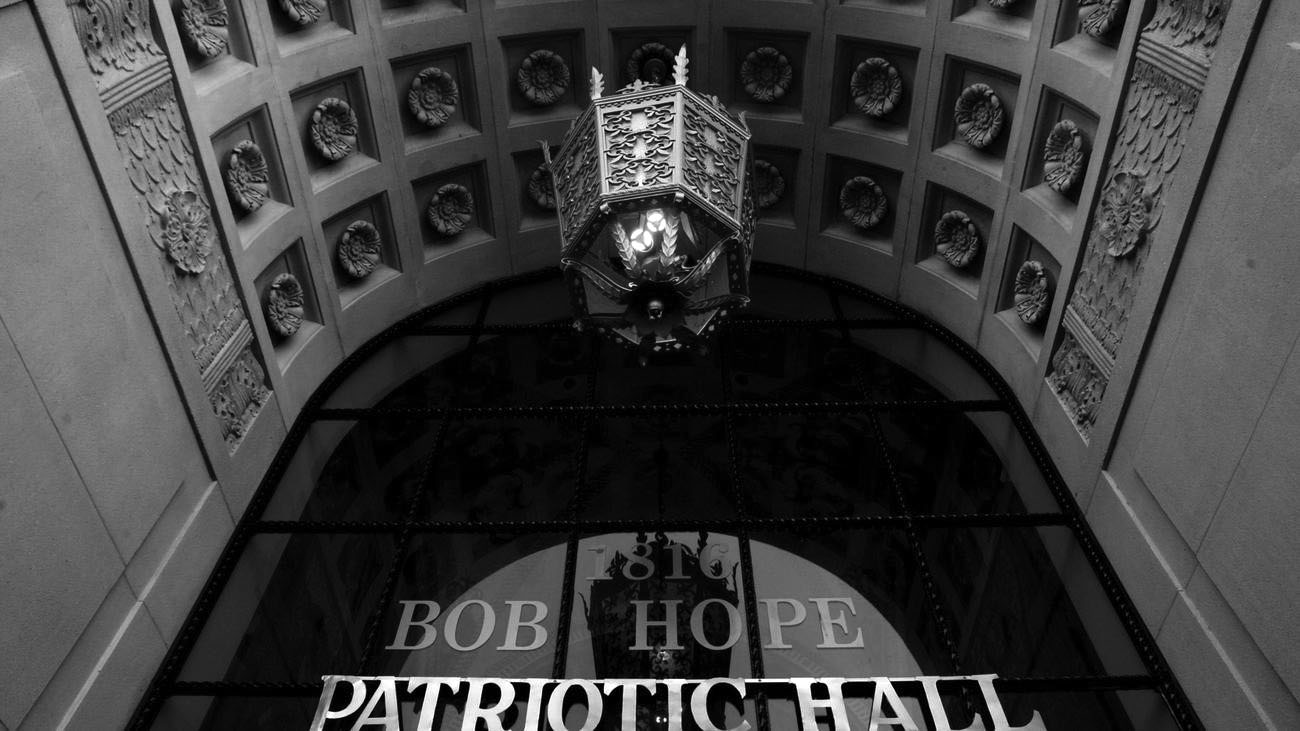 |
|
| (2013)*# - Close-up detailed view showing the ceiling of Bob Hope Patriotic Hall's arched entrance. |
* * * * * |
Barker Brothers
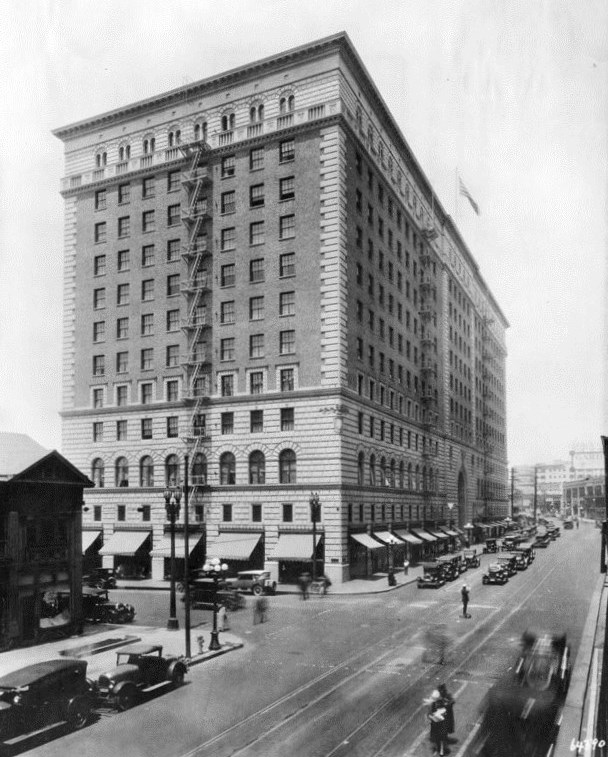 |
|
| (1926)* - Barker Brothers furniture store building, located at 818 W. 7th St. Cars are moving along Seventh St. and Pacific Electric streetcar tracks are visible in the foreground. A policeman is seen standing on a box in the middle of the intersection directing traffic. |
Historical Notes The 1925 building, designed in the Renaissance Revival style by Curlett and Beelman, was said to have been inspired by the Strozzi Palace in Florence. The symmetrically developed twelve-story structure is faced in terra cotta and brick, with a monumental three-story round arched center entry. Inside there is a forty-foot-high lobby court with beamed and vaulted ceilings.* |
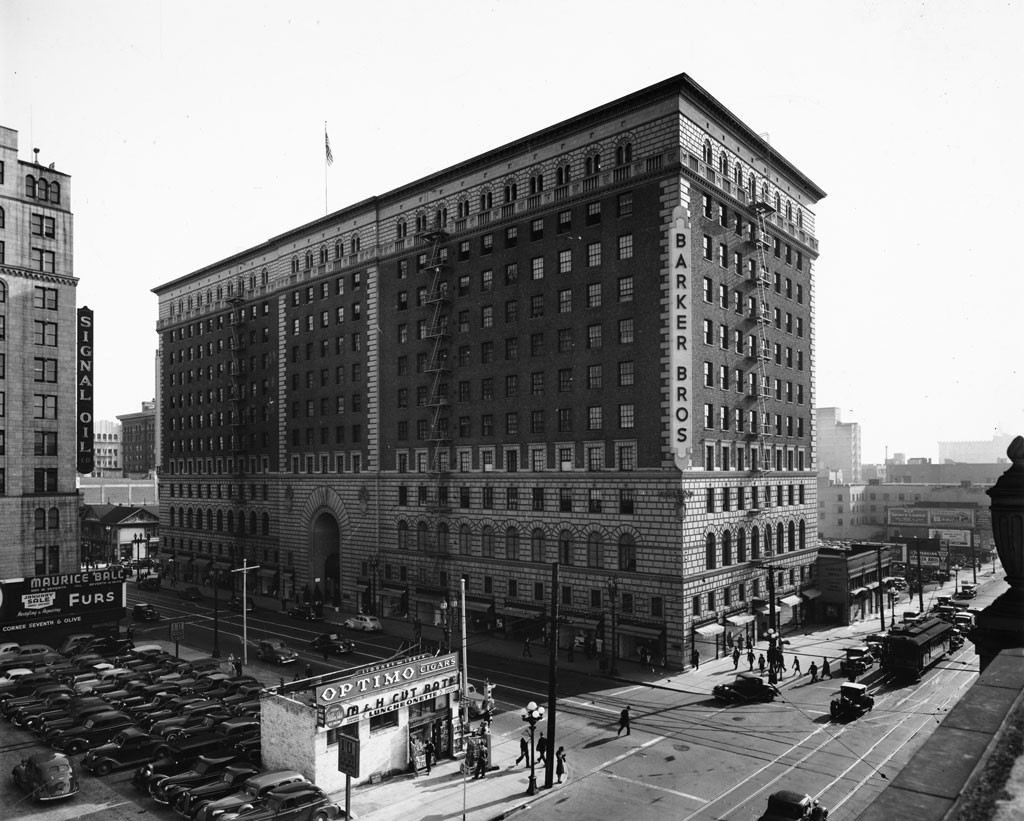 |
|
| (1930s)^ - View of the Barker Brothers building on the southeast corner of 7th & Figueroa. The M & H Cut Rate Luncheonette sits on the opposite corner adjacent to a parking lot. Sign on the mini-diner reads: “Optimo Cigars” |
Historical Notes Obadiah J. Barker was a Los Angeles business man and the founder and president of the furniture company, Barker Brothers. Born in Bloomfield, Indiana, Barker moved with his family to Colorado Springs, Colorado as a young man. He attended Colorado College and also attended dental school in St. Louis. However, he did not complete dental school and moved to Los Angeles with his parents and brothers in 1880. The family began a successful furniture business on Spring Street in Los Angeles. The company became one of the world's biggest house-furnishing stores.^* |
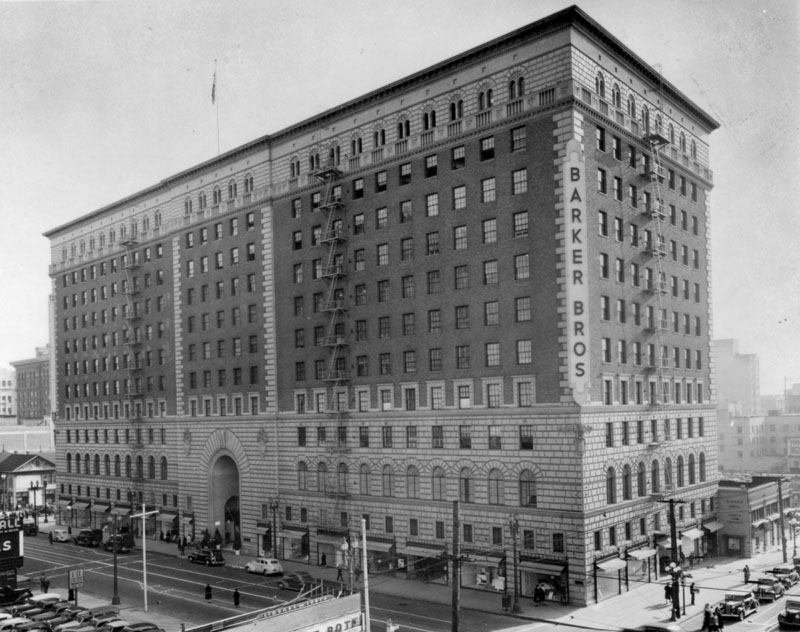 |
|
| (1930s)* - Another look at the Barker Brothers building with a better view of its grand 3-story arched entryway. |
Historical Notes Barker Brothers' fine furnishings was a Los Angeles upscale furniture chain that closed in 1992 after operating for more than 110 years.^* |
 |
|
| (1930s)* - Exterior view of the Barker Brothers furniture store building, located at 818 W. 7th St. Pedestrians can be seen walking in front of the over-sized display windows. |
Historical Notes In 1988, the Barker Brothers Building on the southeast corner of 7th Street and Figueroa was dedicated LA Historic-Cultural Monument No. 356 (Click HERE to see complete listing). |
* * * * * |
Young's Market
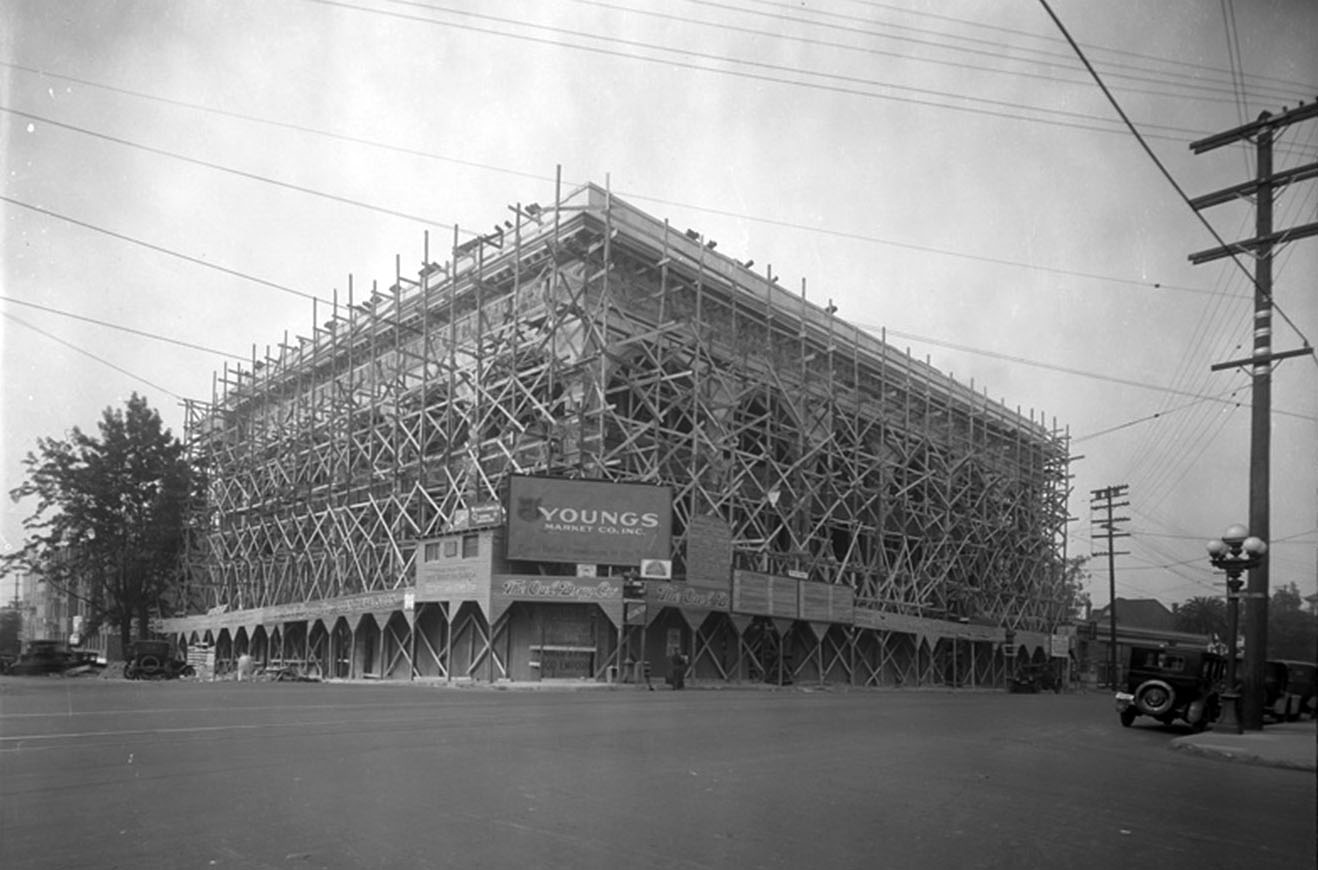 |
|
| (1924)* – View showing Young's Market Company building under construction. Location: 7th & Union, Los Angeles; A sign for Owl Drug Store can be seen on bottom floor. |
Historical Notes Built in Italian Renaissance Revival style. Architect: Charles F. Plummer; general contractors, Weymouth Crowell Co. |
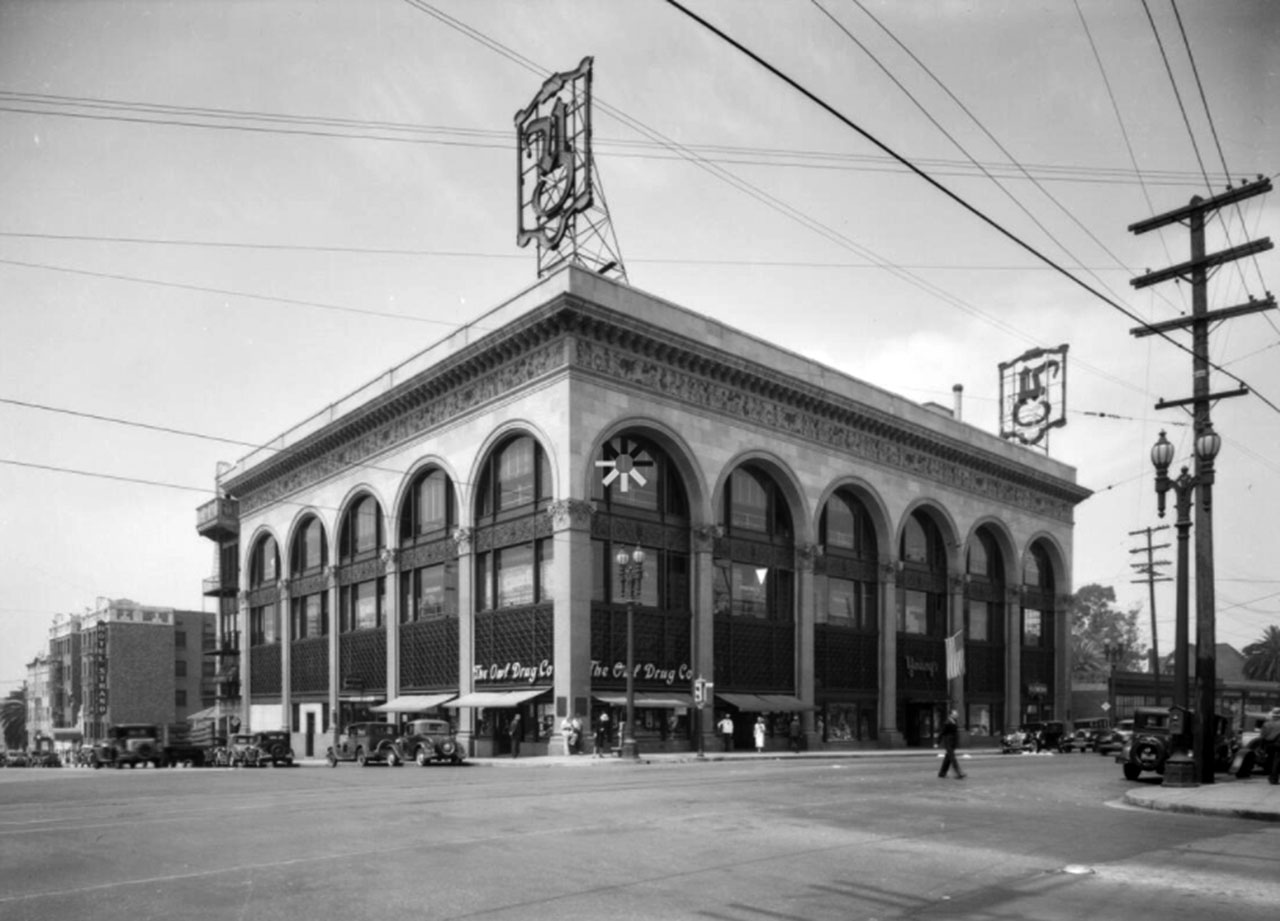 |
|
| (1932)^ – Young’s Market building located at 1610 W. Seventh St in DTLA. Note the two large signs on the roof. |
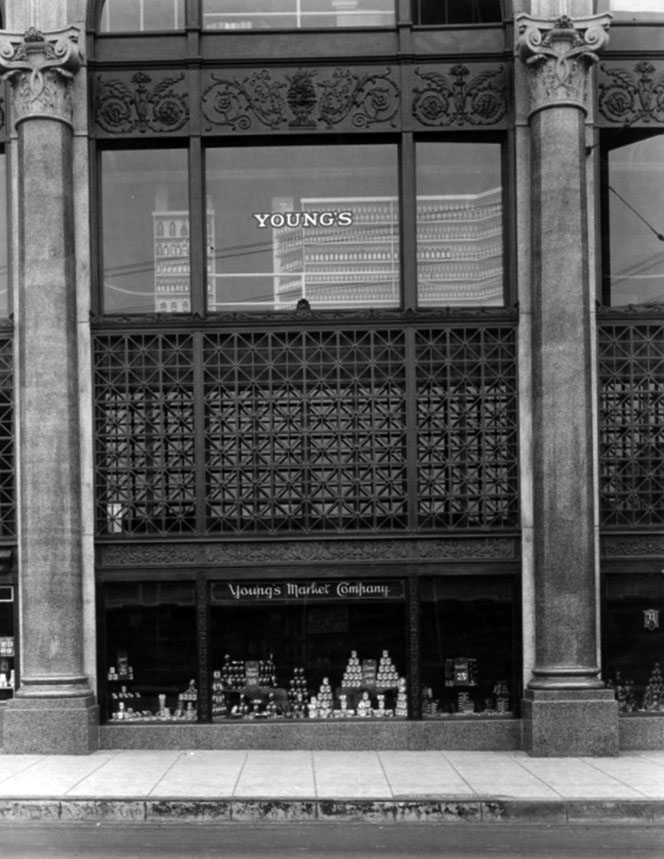 |
|
| (ca.1920s) – Close-up detail view of the Young's Market Company Building, located on the southwest corner of West Seventh Street and Union Avenue. |
Then and Now
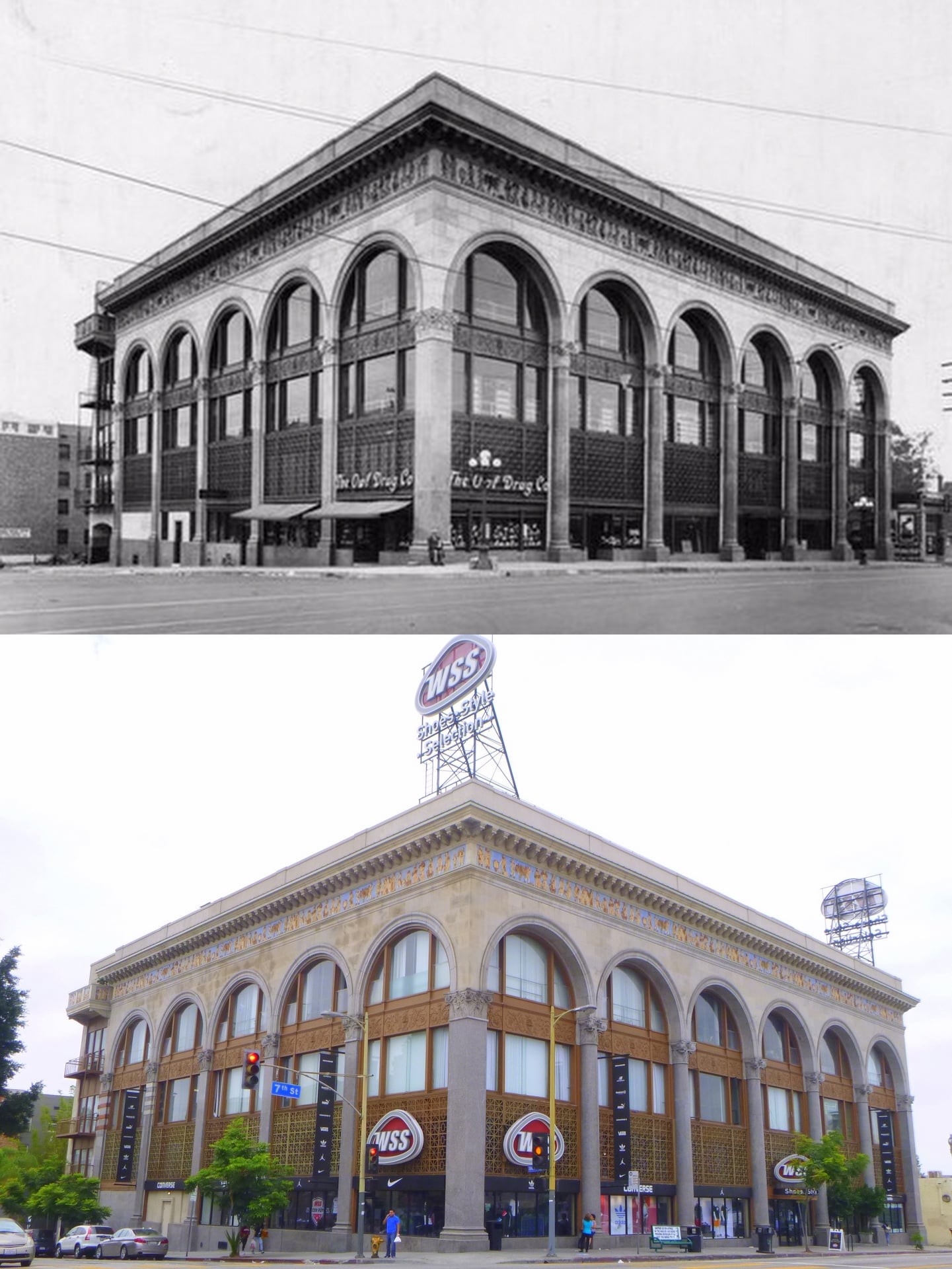 |
|
| Then and Now* |
Historical Notes The market has been repurposed as a shoe store and retains original murals and light fixtures. |
* * * * * |
Coffee Cup Cafe
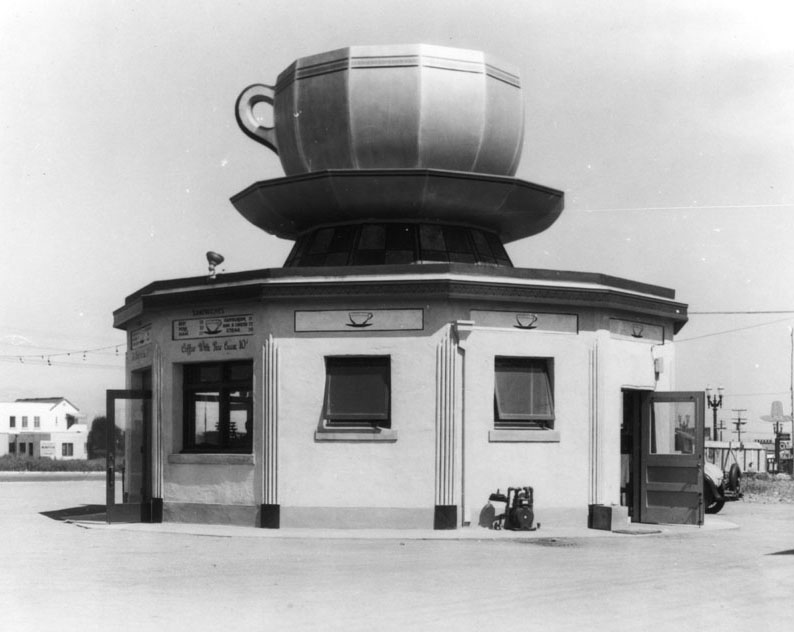 |
|
| (1920s)* - View of the Coffee Cup Cafe located at 8901 Pico Boulevard. A giant coffe cup and saucer sit on top of the cafe structure. |
Historical Notes In the 1920s and 1930s, more and more business catered to the Los Angeles automobile culture. Buildings and structures became more unique, often resembling the merchandise or services they hawked. Giant sized version of objects (Giant Hat – Brown Derby, Giant Dog - Pup Café, Giant Coffee Cup – Coffee Cup Café, etc.) began to pop up everywhere. #^#^ These “hey-you-can’t miss-me!” buildings (referred to as Novelty or Programmatic Architecture) were made to pull automobile drivers right off the road. Click HERE to see more examples of Programmatic Architecture. |
Wilshire Coffee Pot Restaurant
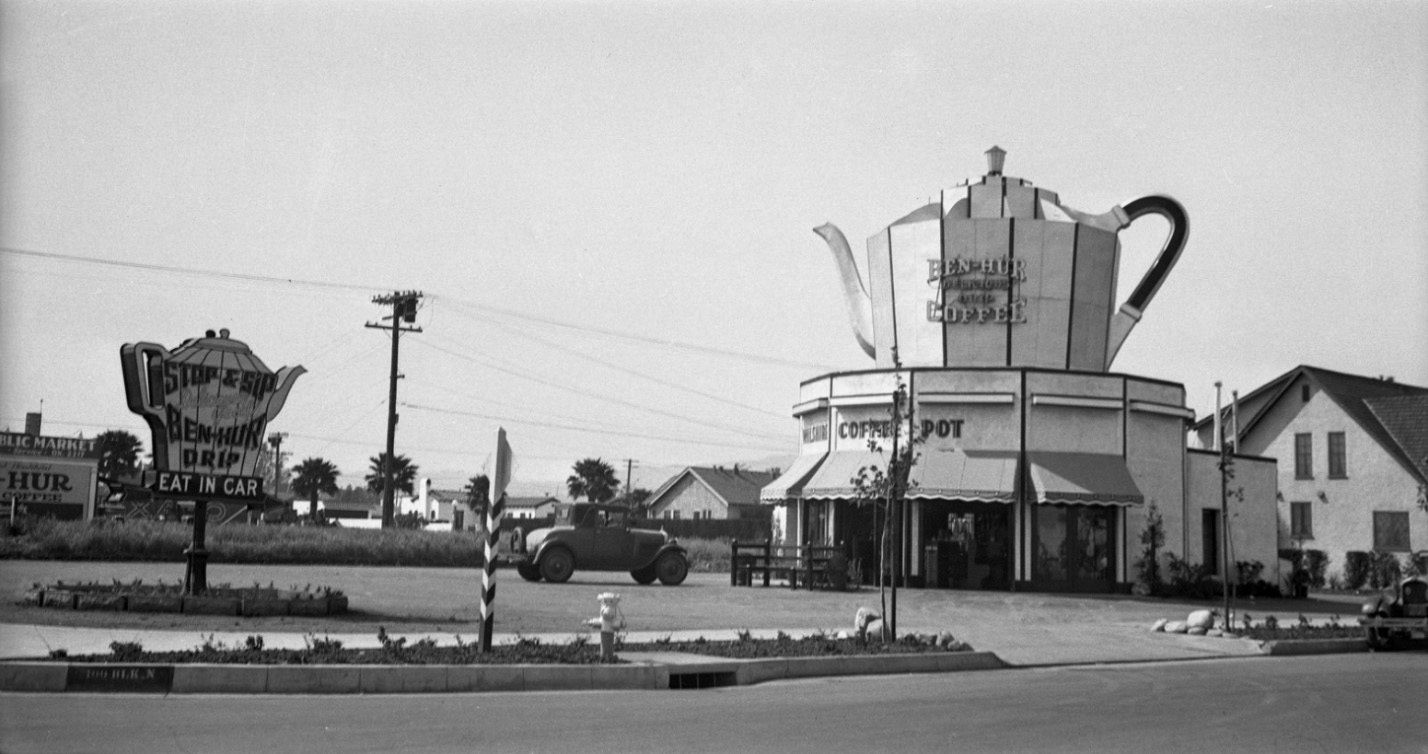 |
|
| (ca. 1925)#*#^ - View showing a car in the parking lot of the Wilshire Coffee Pot restaurant. The restaurant and coffee shop was located at 8601 Wilshire Boulevard, on the northwest corner of Stanley Drive and Wilshire Blvd. A giant coffee pot sits on top of the building. Ben-Hur Coffee is featured. |
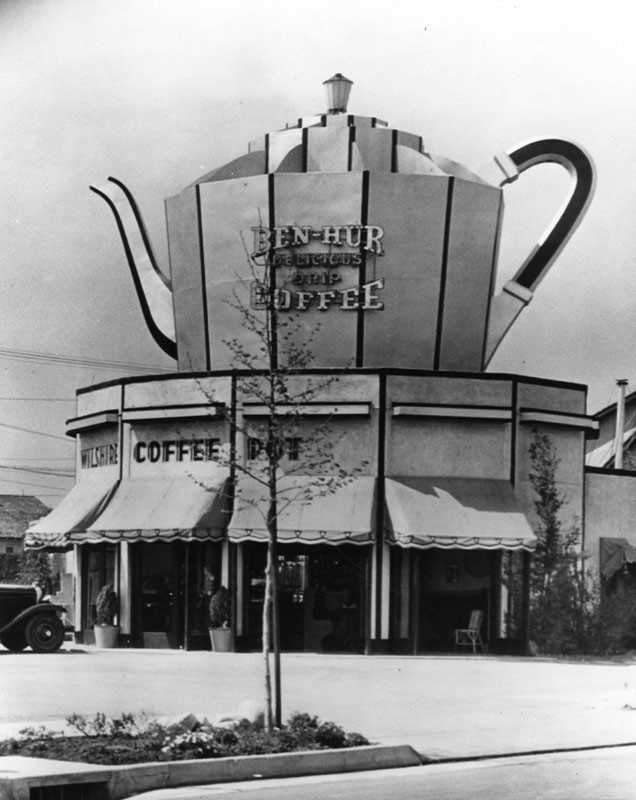 |
|
| (ca. 1930s)* - Close-up view of the Wilshire Coffee Pot restaurant, located at 8601 Wilshire Boulevard in Beverly Hills. The building has a coffee pot on the roof with advertisement for: Ben-Hur Delicious Drip Coffee. |
Click HERE to see more examples of Programmatic Architecture. |
* * * * * |
Hollyhock House
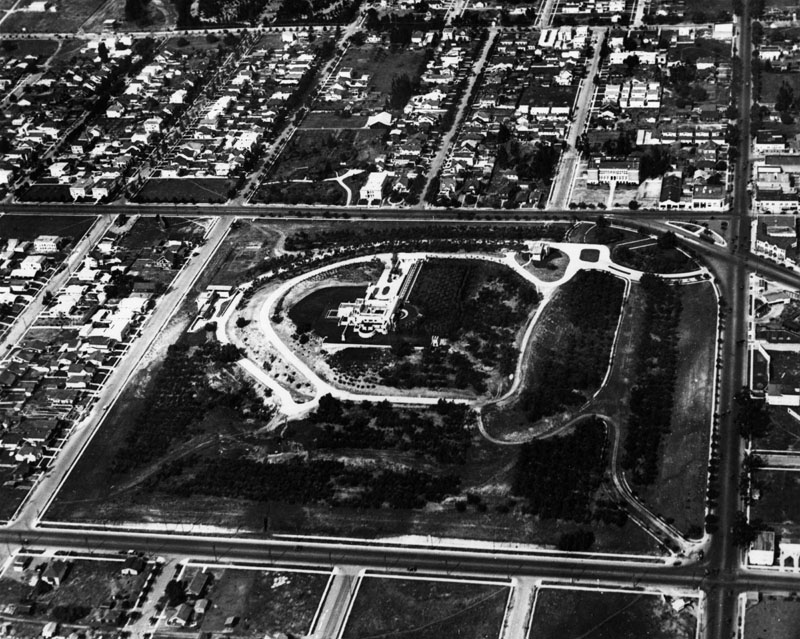 |
|
| (1920s)* – Aerial view looking north showing the Hollyhock House on top of Olive Hill. The estate is bounded by Hollywood Blvd (North), Sunset Blvd(South), Edgemont St (West), and Vermont Ave (East). |
Historical Notes Originally designed by Frank Lloyd Wright as a residence for oil heiress Aline Barnsdall, The Hollyhock House was built in 1919–1921. Barnsdall originally intended the house to be part of an arts and theater complex on a property known as Olive Hill, but the larger project was never completed.*^ |
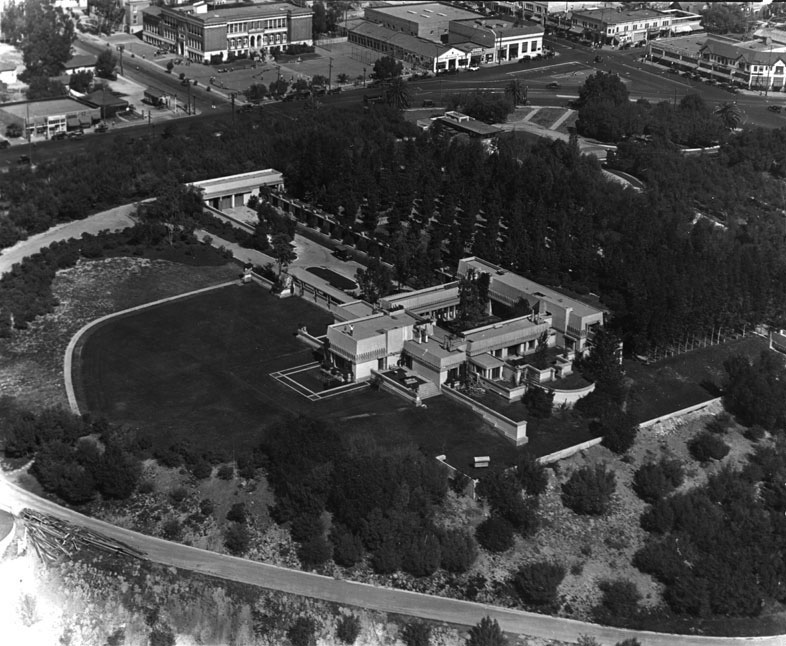 |
|
| (ca. 1927)* - Aerial view showing Barnsdall Art Park and the Frank Lloyd Wright designed Hollyhock House. At upper center-left is Los Feliz Elementary School. At upper-right corner is the intersection of Hollywood Boulevard and Vermont Ave. |
Historical Notes Disillusioned by the costs of construction and maintenance, Barnsdall donated the house to the city of Los Angeles in 1927 under the stipulation that a fifteen-year lease be given to the California Art Club for its headquarters, which it maintained until 1942. The house has been used as an art gallery and as a United Service Organizations (USO) facility over the years. Beginning in 1974, the city sponsored a series of restorations, but the structure was damaged in the 1994 Northridge earthquake. It was again restored, and was open to the public as of June 2005.*^ |
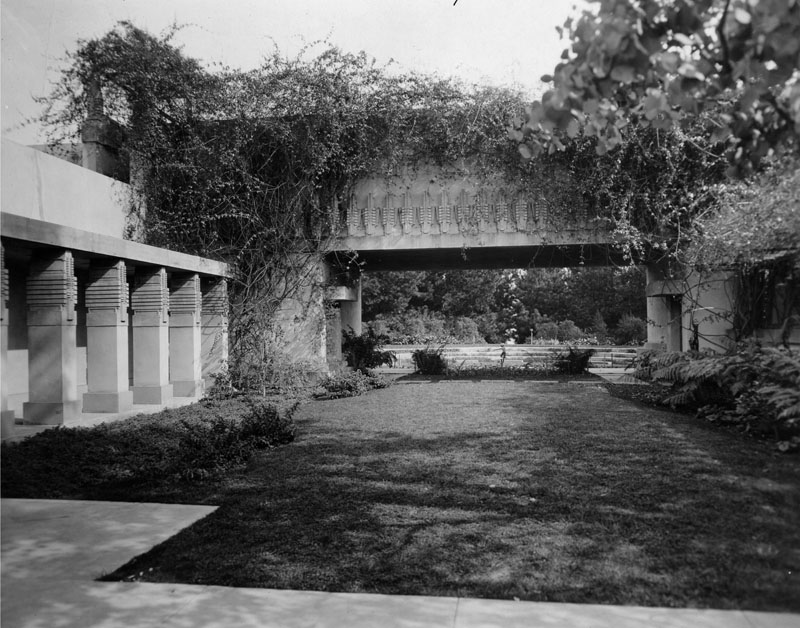 |
|
| (1939)* - View of archway and greenery, Hollyhock House located at 4808 Hollywood Boulevard in Barnsdall Park. The home was built between 1919-1921. Architect: Frank Lloyd Wright. Home has a "pre-Columbian air and stylized hollyhock ornamentation" - Gebhard & Winter, restored by Lloyd Wright (his son). |
Historical Notes Like many houses designed by Wright, it proved to be better as an aesthetic work than as a livable dwelling. Water tended to flow over the central lawn and into the living room, and the flat roof terraces were conceived without an understanding of Los Angeles' rains. The cantilevered concrete also has not stood up well to the area's earthquakes.*^ |
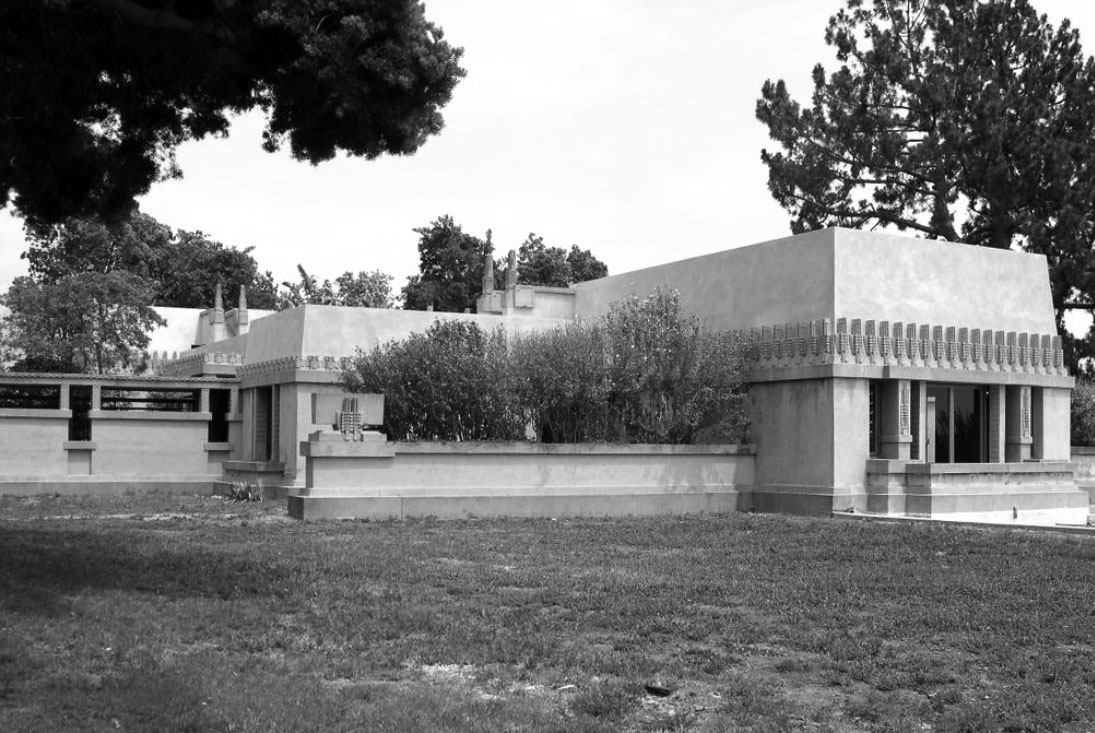 |
|
| (2005)*^ – Frank Lloyd Wright's Hollyhock House, located at 4808 Hollywood Boulevard. |
Historical Notes Originally designed by Frank Lloyd Wright as a residence for oil heiress Aline Barnsdall, The Hollyhock House is now the centerpiece of the city's Barnsdall Art Park.*^ Hollyhock House was added to the National Register of Historical Places in 1971 - Building #71000143 and designated Los Angeles Historic-Cultural Monument #12 in 1963. The 12-acre Barnsdall Park was designated Los Angeles Historic-Cultural Monument #34 in 1965 and Residence A (Barnsdall Park Arts Center) was designated Los Angeles Historic-Cultural Monument #33 in 1965. Click HERE to see complete listing of LA Historic-Cultural Monuments. |
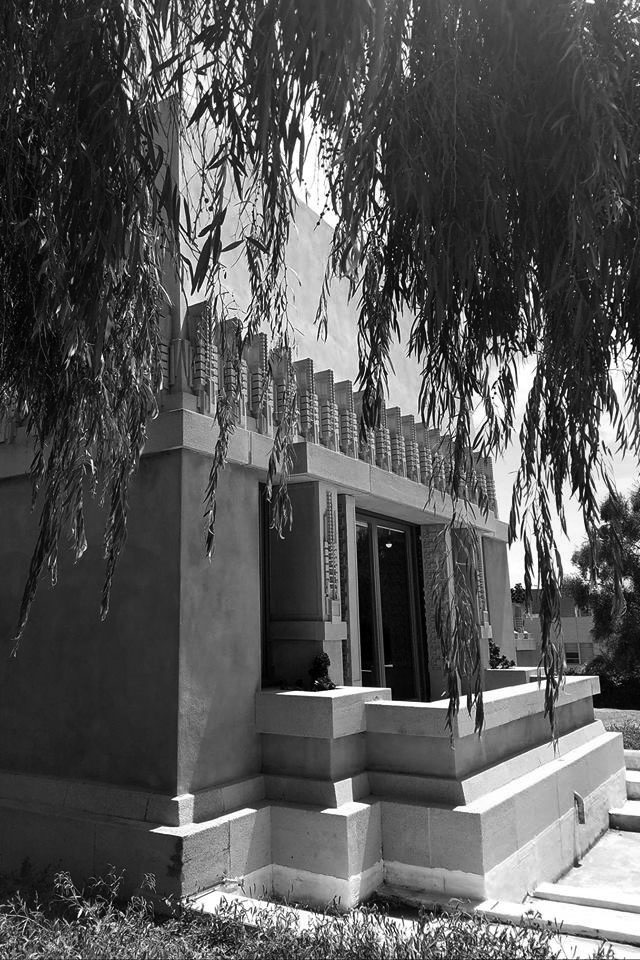 |
|
| (2018)^.^– Close-up view of Frank Lloyd Wright's Hollyhock House as it appears today. |
Historical Notes Hollyhock House is the only one of the 6 houses Frank Lloyd Wright built in LA that is open to the public. |
* * * * * |
Ennis House
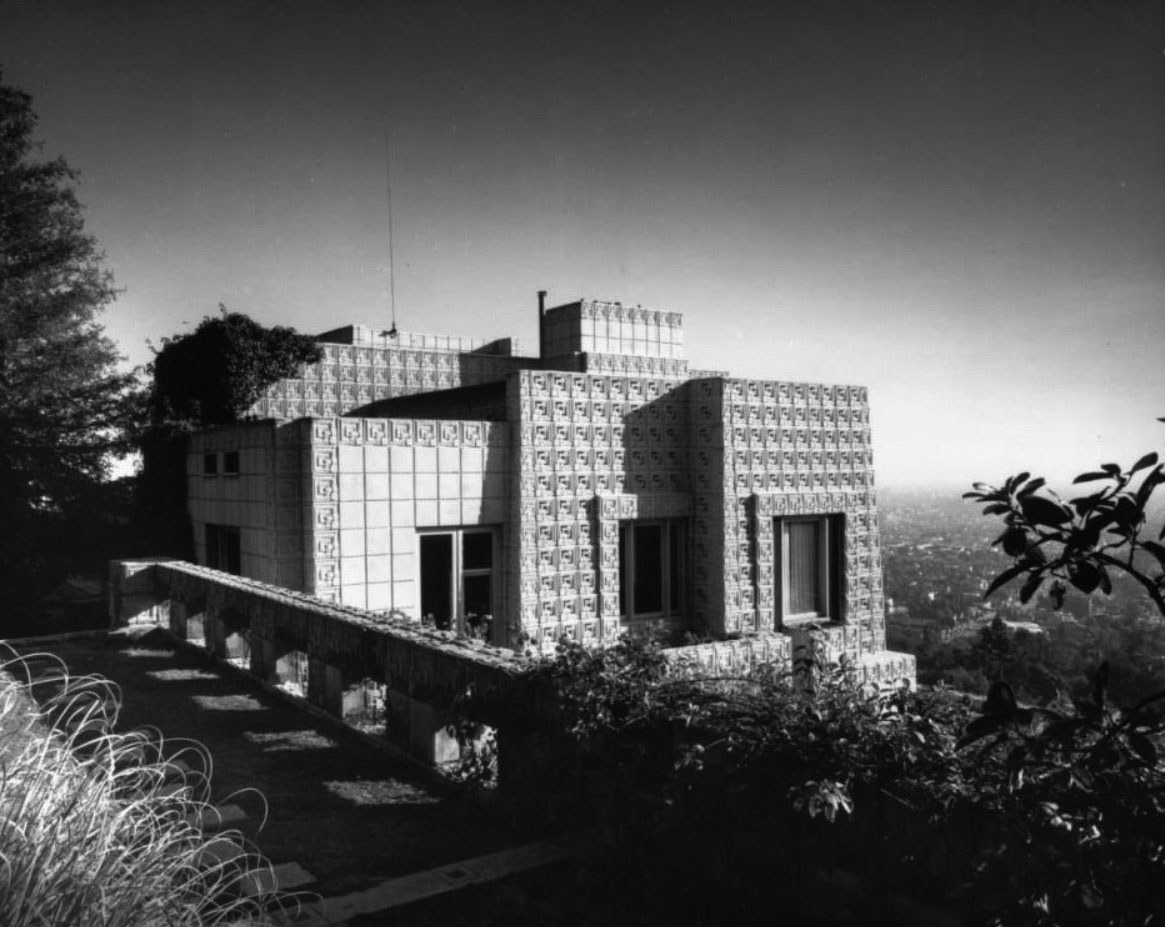 |
|
| (1924)^ - View showing the Ennis House, designed in 1923 by Frank Lloyd Wright for Charles and Mabel Ennis, and built in 1924. It is located at 2655 Glendower Avenue in the Los Feliz area of Los Angeles. |
Historical Notes The Ennis House, designed by Frank Lloyd Wright and built by his son, Lloyd, is the last and largest of the elder Wright’s four “textile block” houses in the Los Angeles area. These homes are noted for their patterned and perforated concrete blocks, which give a unique textural appearance to both the exterior and interior.* |
.jpg) |
|
| (1924)^ – View of the Ennis House showing a number of its elements built of decorated textile blocks. Photo by Julius Shulman |
Historical Notes Built for retailer Charles Ennis and his wife Mabel, the home is constructed of more than 27,000 concrete blocks, all made by hand using decomposed granite extracted from the site. The home’s unique appearance has made it a popular filming location for TV and movies, including The House on Haunted Hill (1959), Blade Runner (1982), and the television series Buffy the Vampire Slayer. * |
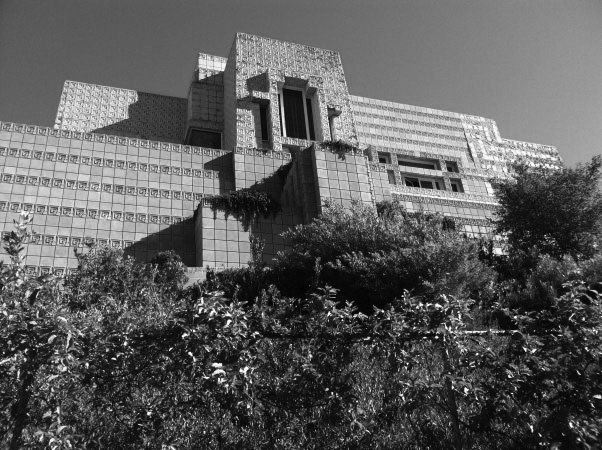 |
|
| (n.d.)** - View looking up toward the Ennis House from bottom of hill. |
Historical Notes By 2005, deferred maintenance, earthquakes, and heavy rains had taken a toll on the Ennis House. Foundations and walls had begun to fail, and the situation grew so dire that the National Trust for Historic Preservation included the home on its 2005 list of America's 11 Most Endangered Places. Work to stabilize and restore the house began in 2006, earning a Conservancy Preservation Award in 2008. * |
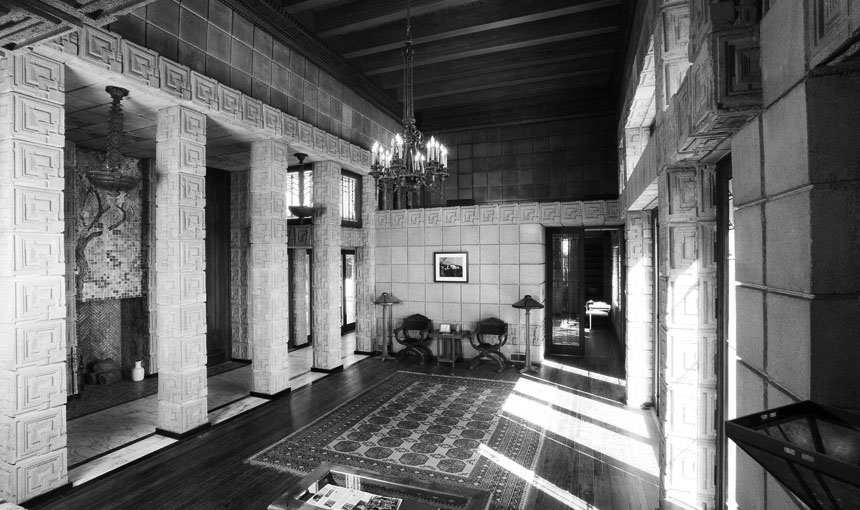 |
|
| (ca. 2008)** - Interior view of the Ennis House showing entryway |
Historical Notes Wright's client was Charles Ennis, the owner of a men's clothing store in downtown L.A. and an enthusiast of Mayan art and architecture. For each of Wright's houses built with concrete blocks, or textile blocks as they are often called, Wright designed a custom pattern. For the Ennis house, the pattern was a Greek key. Within the interlocking form, it's possible to interpret a stylized "g" -- perhaps an allusion to the Masonic Order, of which Ennis was a member, and the organization's symbol, the compass with the letter "g" in the middle representing God.* |
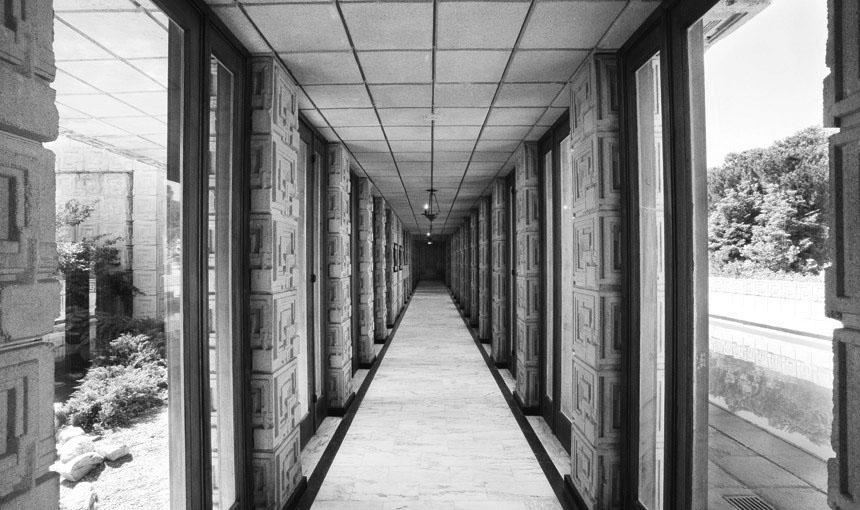 |
|
| (ca. 2008)** - A long symmetical corridor connects two sections of the Ennis House. |
Historical Notes The house consists of two buildings, the main house and a smaller chauffeur's apartment/garage, separated by a paved courtyard. Unlike the vertical orientation of the other three block houses, the Ennis House has a long horizontal loggia spine on the northern side, connecting public and private rooms to the south, and is very large at 10,000 sq ft. The kitchen, pantry, guest room, dining room, living room, master bathroom and bedroom, upper terrace, and second bathroom and bedroom are at the eastern and lower end of the main building.^ |
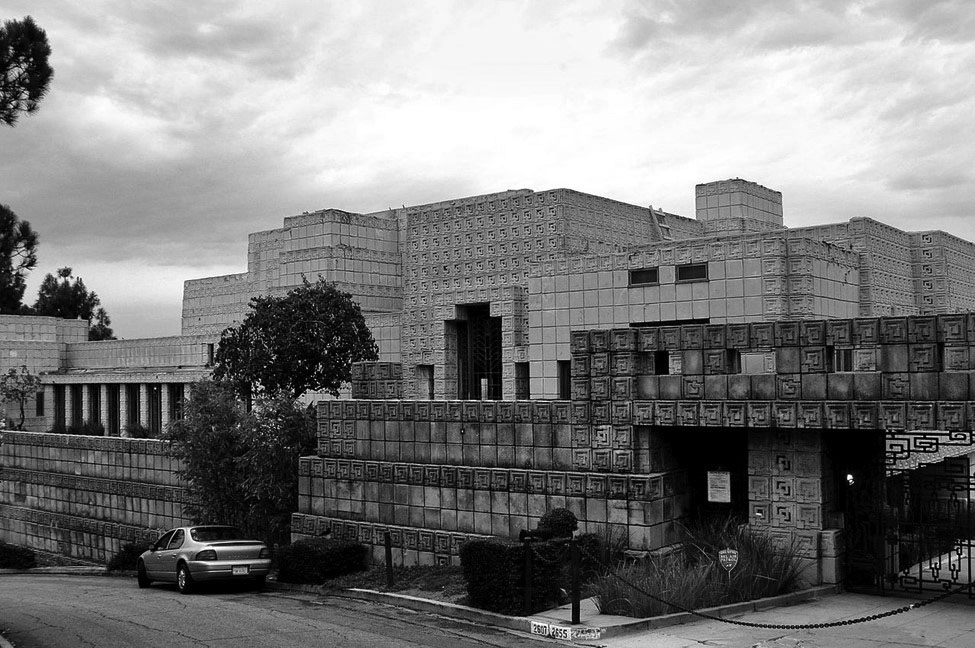 |
|
| (2005)^* - Front side of the Ennis House located at 2655 Glendower Avenue in the Los Feliz community of, Los Angeles. |
Historical Notes When Frank Lloyd Wright completed the Ennis house in 1924, he immediately considered it his favorite. The last and largest of the four concrete-block houses that Wright built in the Los Angeles area remains arguably the best residential example of Mayan Revival architecture in the country. When The Times' Home section convened a panel of historians, architects and preservationists in 2008 to vote on the region's best houses of all time, the Ennis house ranked ahead of the Modernist Eames house, the John Lautner spaceship-on-a-hill known as Chemosphere and the Arts & Crafts beauty the Gamble house.*# In 1976, the Ennis House was declared LA Historic-Cultural Monument No.149.^ |
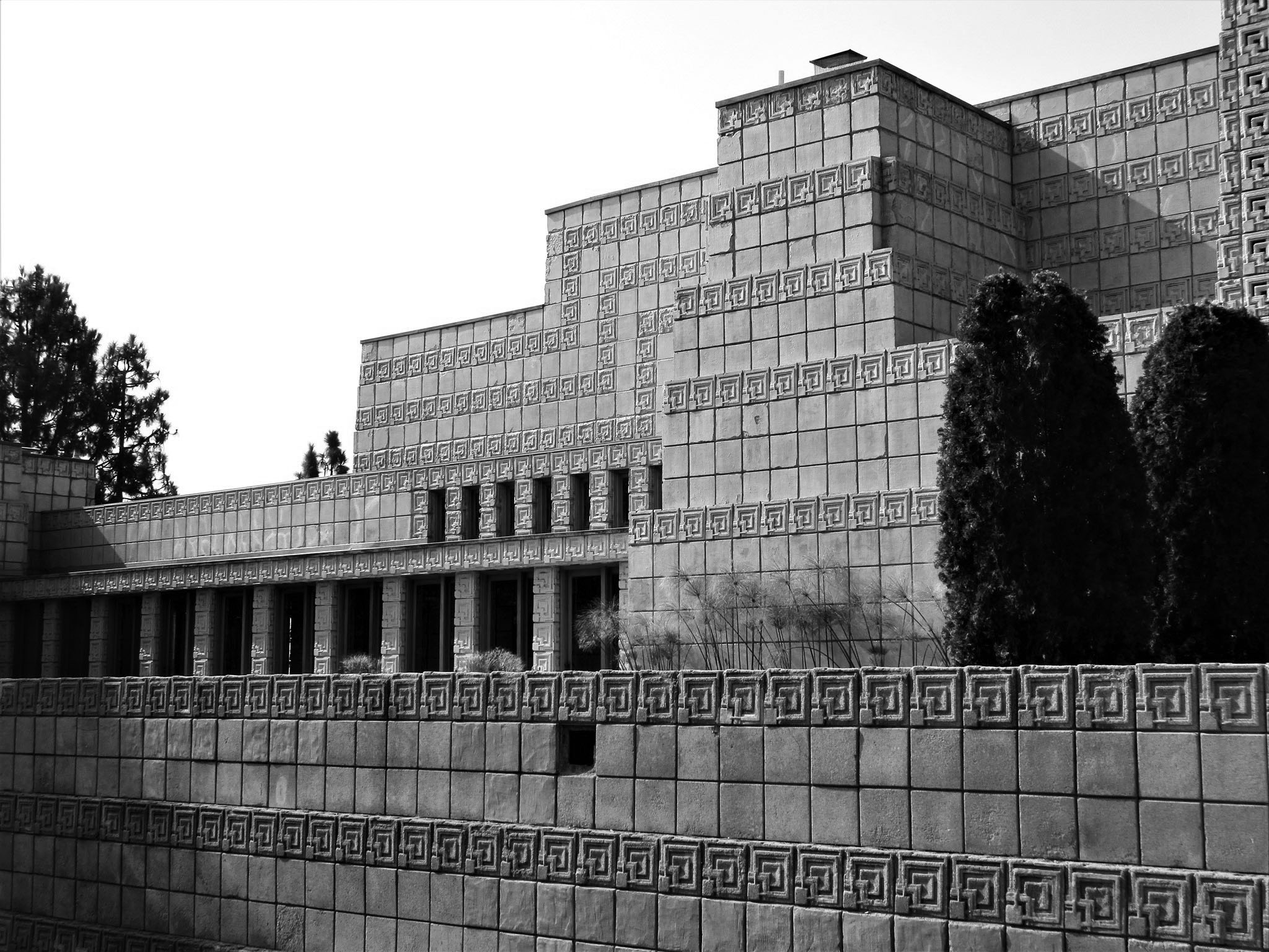 |
|
| (2020)^.^ - Close-up view showing the Frank Lloyd Wright designed Mayan Revival, Textile Block Ennis House located in Los Feliz. Photo by Howard Gray |
Historical Notes On July 15, 2011, The Ennis House Foundation announced the sale of the house to business executive Ron Burkle for just under $4.5 million. A condition of the sale is an easement that allows public viewing 12 days per year, a condition binding on subsequent buyers.^ |
* * * * * |
Pacific-Southwest Trust & Savings Bank (Central and 3rd Branch)
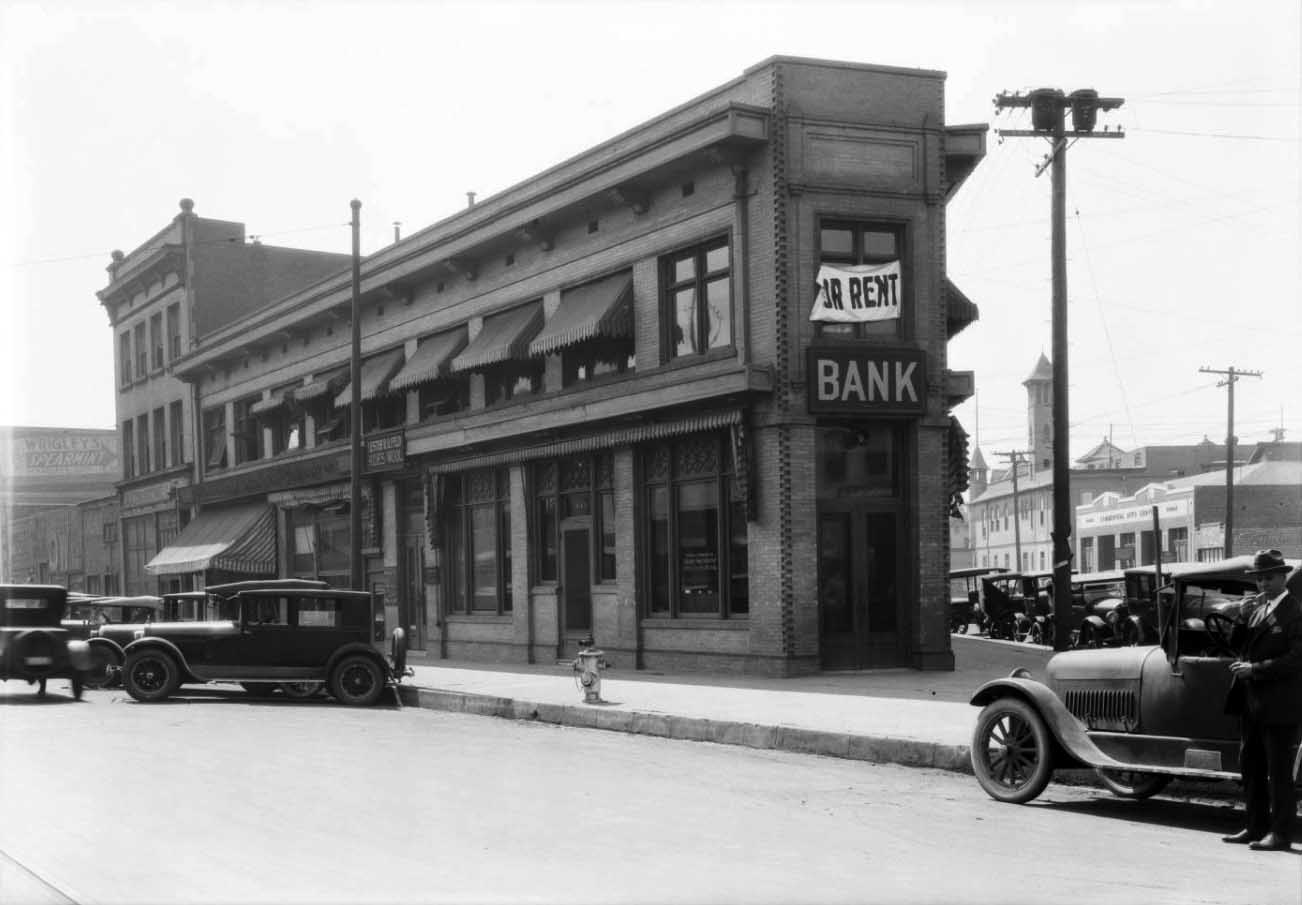 |
|
| (1924)* – View showing the newly constructed Pacific-Southwest Trust & Savings Bank - Central and Third Branch, located at 333 South Central Avenue. There’s a ‘For Rent’ sign for the second floor space above the bank sign. The building is still standing today. |
Historical Notes Originally known as Los Angeles Trust and Savings Bank, the named changed to Pacific Southwest Bank in 1922. |
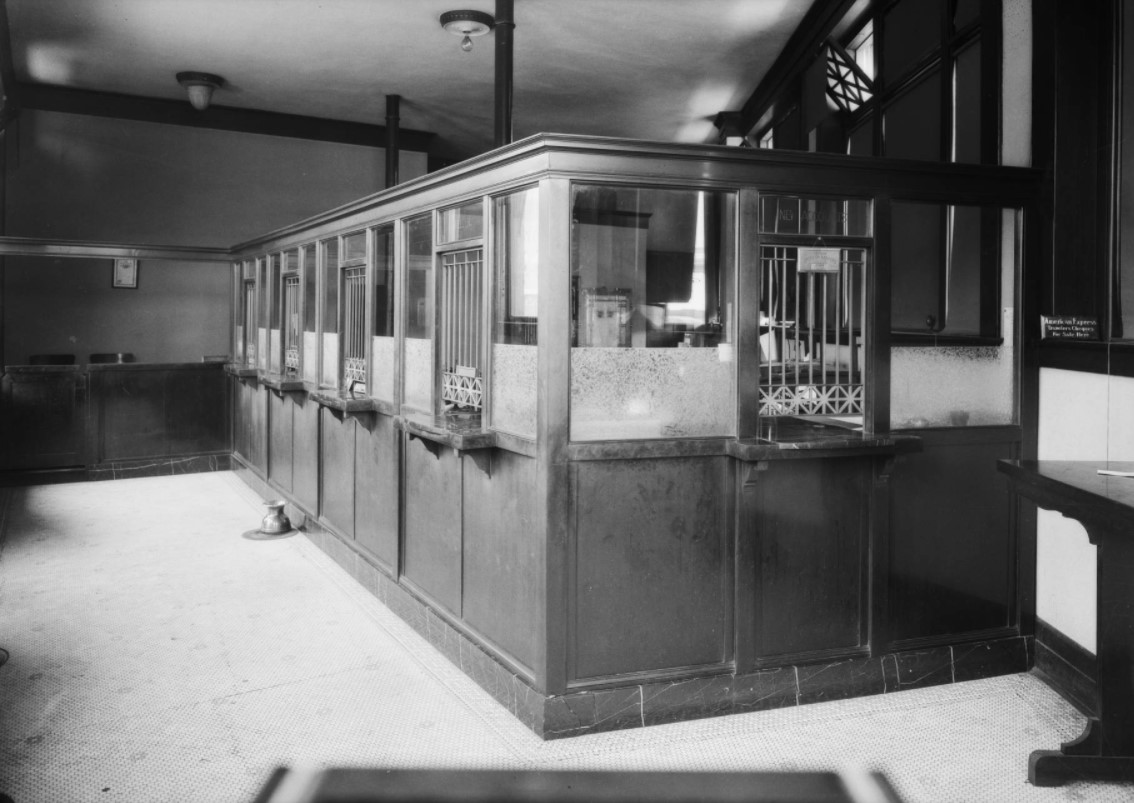 |
|
| (1924)* - Interior view of Pacific-Southwest Trust & Savings Bank showing teller cages. Not sure if that’s a spittoon on the floor. |
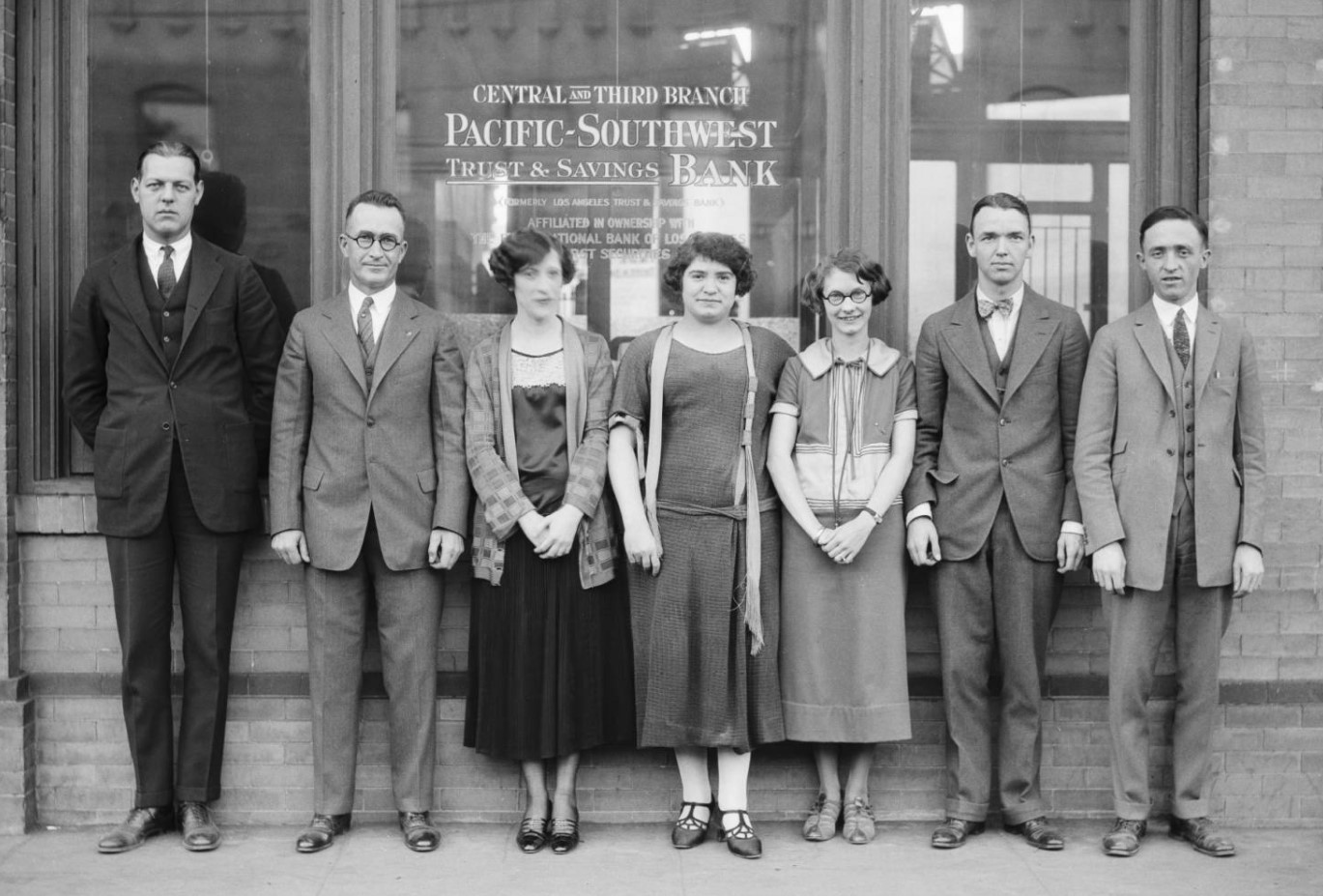 |
|
| (1924)* – Bank employees posing in front of the new building. |
Then and Now
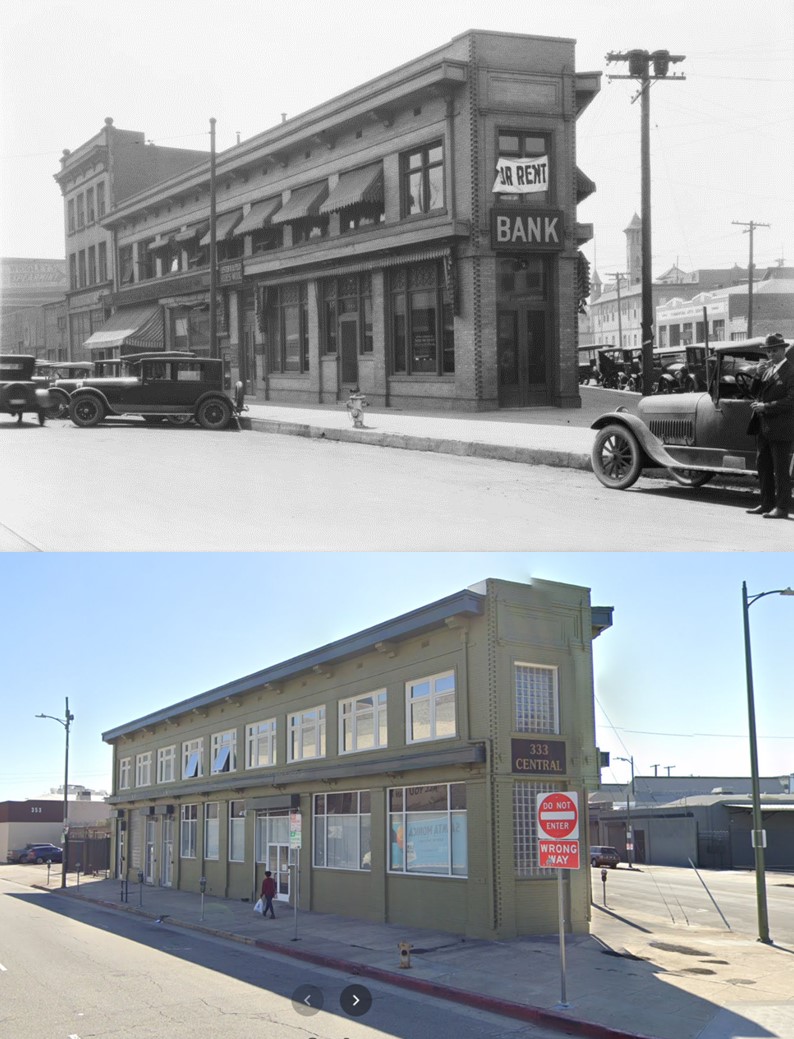 |
|
| (1924) vs. (2019) - 333 S. Central Avenue |
* * * * * |
Lake Vista Apartments
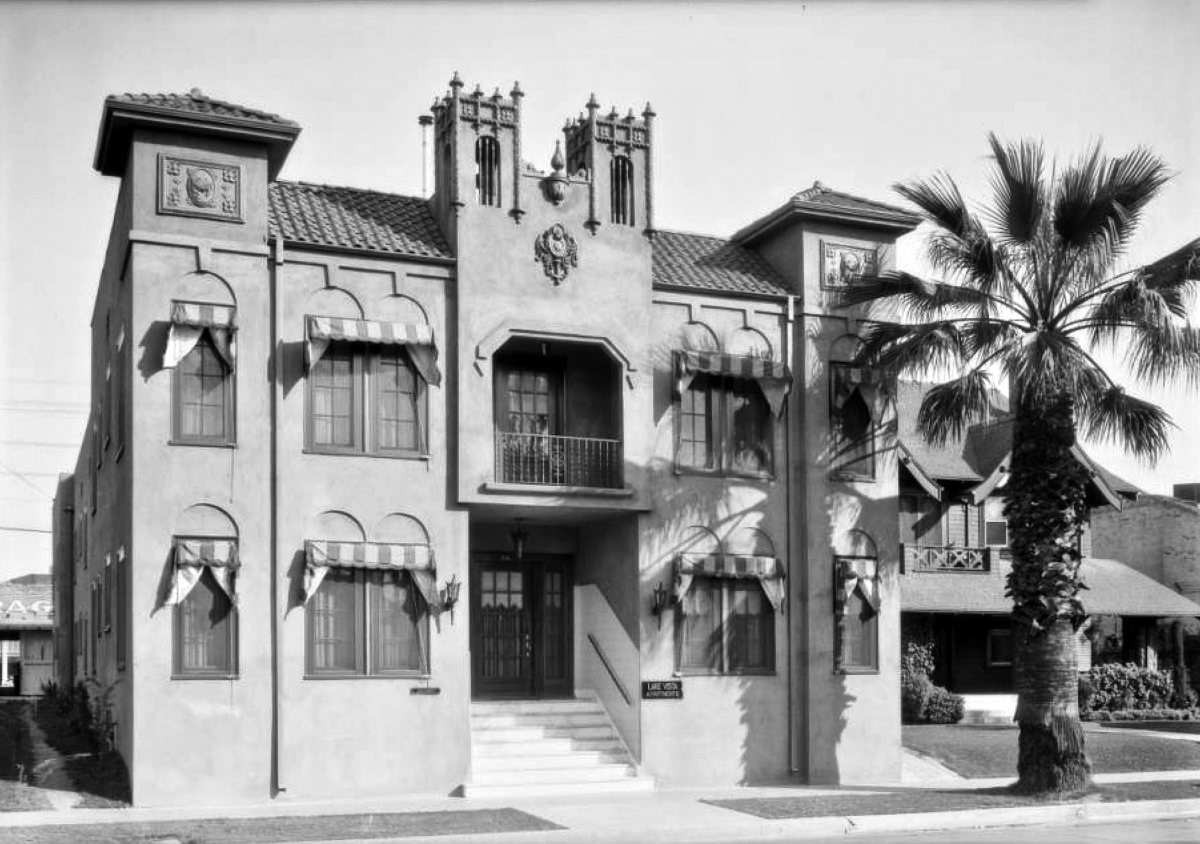 |
|
| (1926)^.^ - View showing the Lake Vista Apartments located at 1244 South Lake Street. Built by Frank Meline. |
Historical Notes Architect Frank L. Meline was born in Illinois and practiced architecture in Los Angeles under the name of Frank L. Meline Company. Among his architectural achievements are included the Fifth Church of Christ Scientist (Hollywood 1914-15); Rustikin Art Club (1922), H.H. Yanow Building (Hollywood, 1920) and the C. Reed Waterman Mausoleum in Inglewood. Frank Meline was also the first sales agent in Bel-Air for developer Alphonzo Bell (1875-1947). Meline became a prominent developer "who in 1912 formed his own Los Angeles construction company, which he expanded in 1919 to a full-service real-estate development and sales opertaion with (by 1924) eighteen branch offices throughout the Los Angeles basin. As a broker, Meline sold half the homes purchased in Beverly Hills before 1930. |
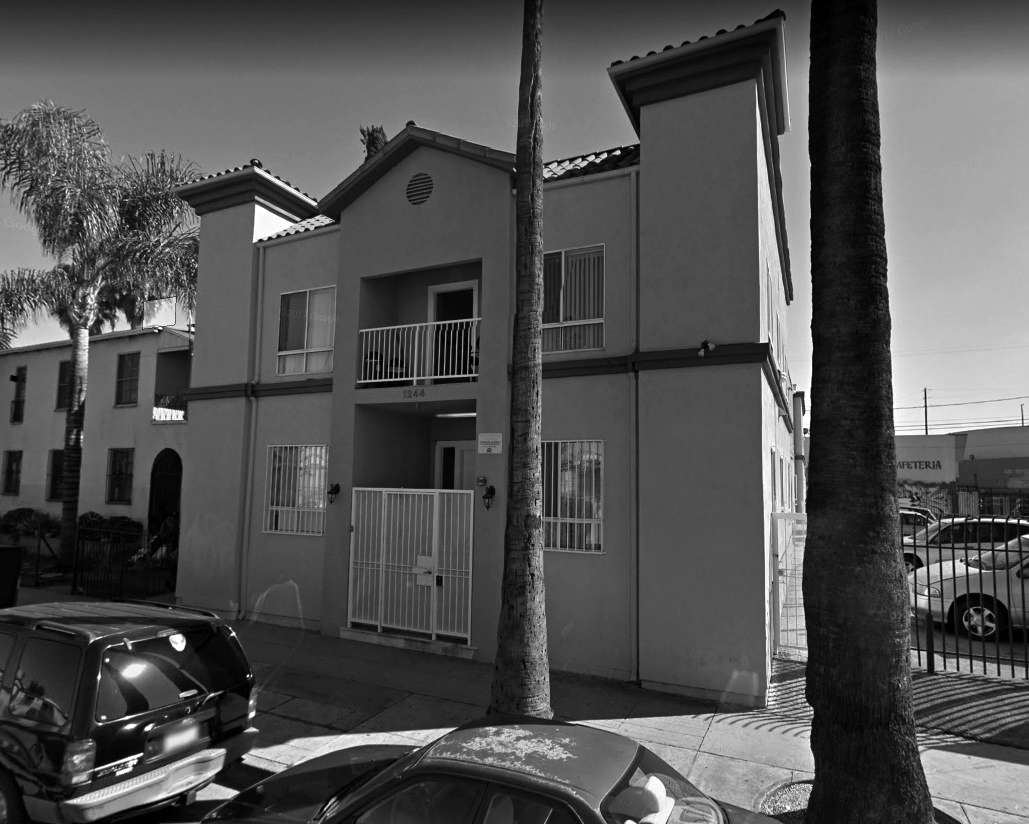 |
|
| (2017)^ – View showing the Lake Vista Apartments building as it appears today. Not as pretty as the original version. |
* * * * * |
Warner Brothers West Coast Studio
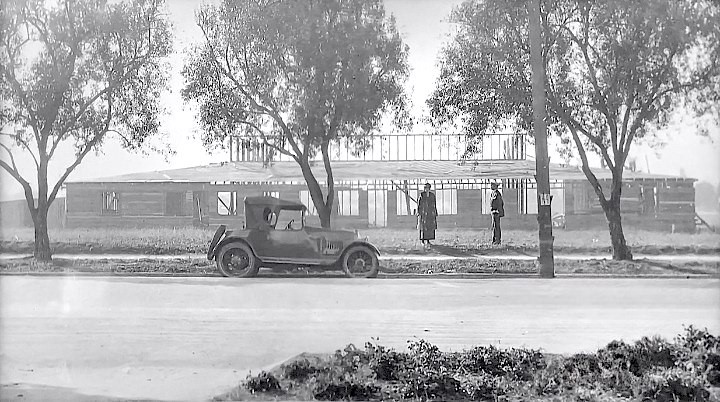 |
|
| (ca. 1919)* - View showing a man and woman standing on a lot at the 5800 Sunset Boulevard. Behind them is a structure under construction which became the birth of Warner Bros. west coast filming studios. The car parked in front happens to be a c1918 Scripps-Booth. |
Historical Notes In 1918, the Brothers Warner (Harry, Albert, Sam and Jack) bought 10.2-acres of land in Hollywood from the Beesmyer family at a cost of $25,000. In 1919 they built a giant stage nicknamed The Barn, which measured 50-feet wide by 100- feet long. This stage was torn down in 1923 and was replaced by a collection of smaller stages and buildings.* |
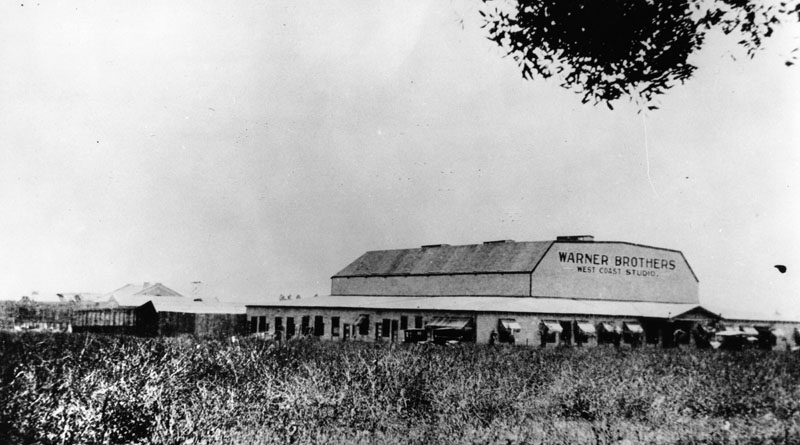 |
|
| (ca. 1918)* - View showing the original "Barn" filming stage at the Warner Brothers West Coast Studio at Sunset and Bronson in Hollywood. |
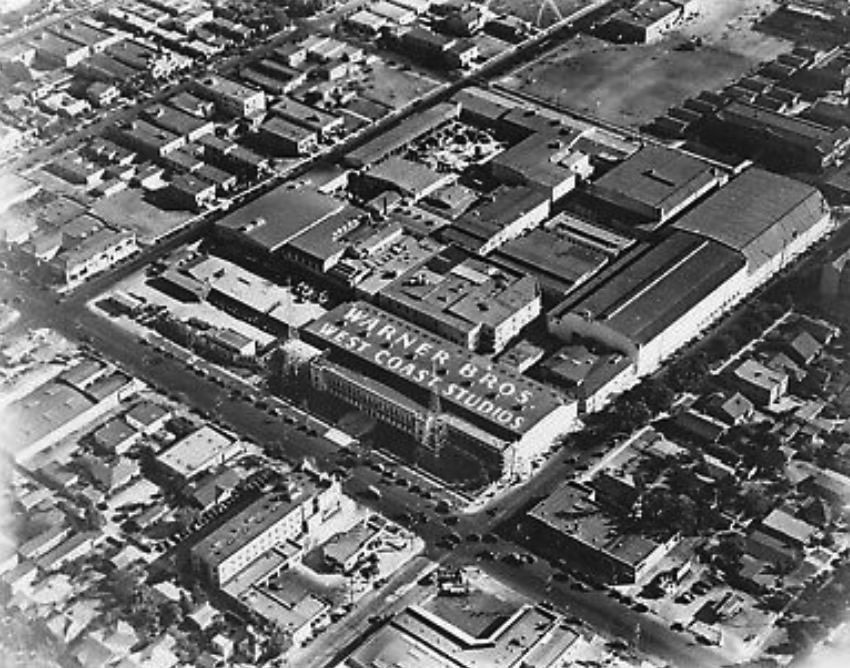 |
|
| (1920s)* – Aerial view looking down at Warner Bros. Studio located at 5800 Sunset Boulevard in Hollywood. The intersection of Sunset Boulevard and Bronson Avenue is seen in the foregournd. |
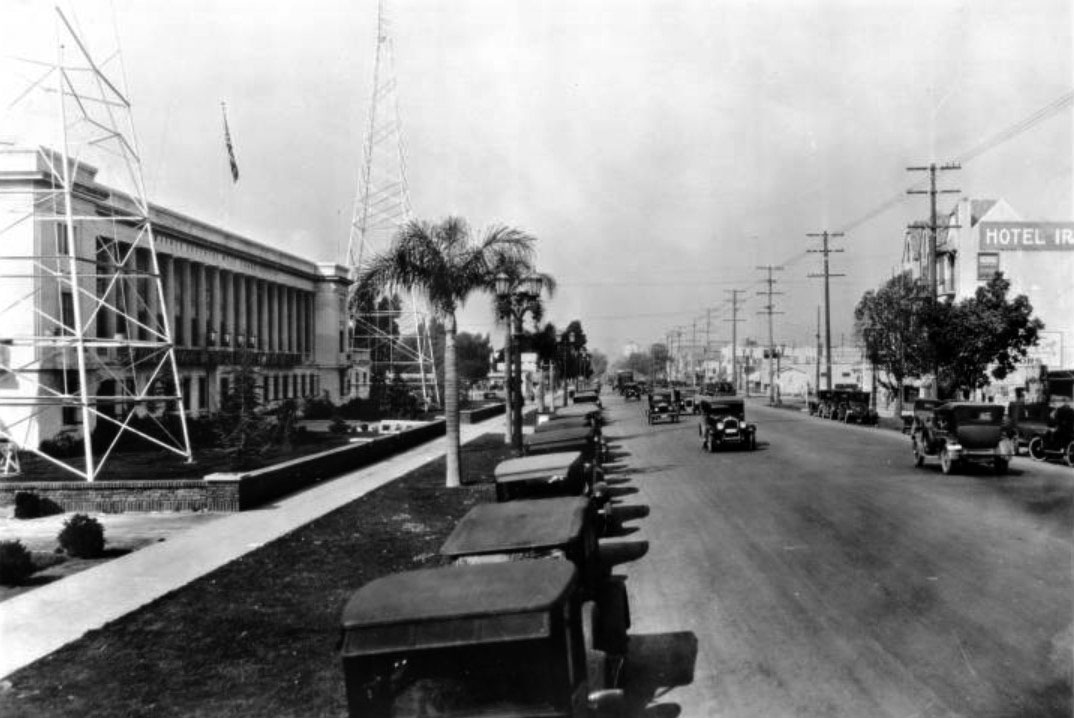 |
|
| (ca. 1926)^ - View of Sunset Boulevard looking west from near Van Ness Avenue showing the Warner Brothers Studio. Automobiles are parked along the left sidewalk while still others navigate the boulevard. To the left, the Romanesque architecture of the Warner Bros. West Coast Studio building can be seen flanked to either side by tall radio towers, with its entranceway supported by Doric columns. Hotel Iris can be seen across the street (This is where Judy Garland once stayed). |
Historical Notes The studio was the site where the first talking feature film, The Jazz Singer, was filmed in 1927.* |
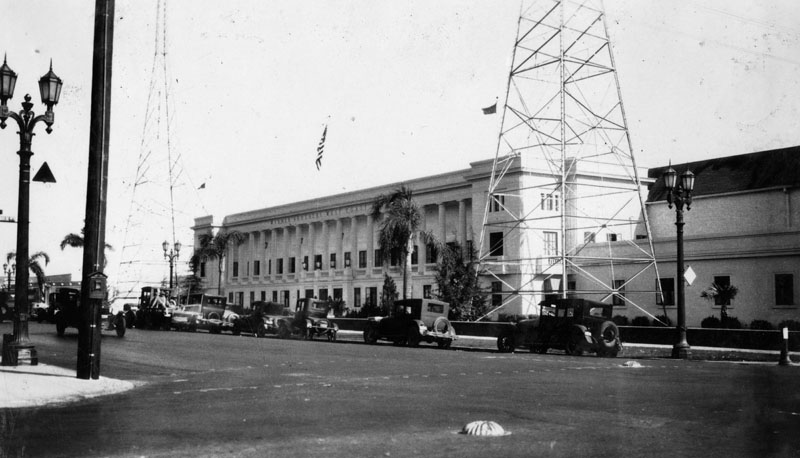 |
|
| (1927)* - View looking southeast from the intersection of Sunset and Bronson Ave showing the Warner Brothers West Coast Studios, located at 5858 Sunset Boulevard. |
Historical Notes In 1925, Sam Warner started KFWB radio station on the lot. Note the station’s two 150-foot towers in the above photo.* |
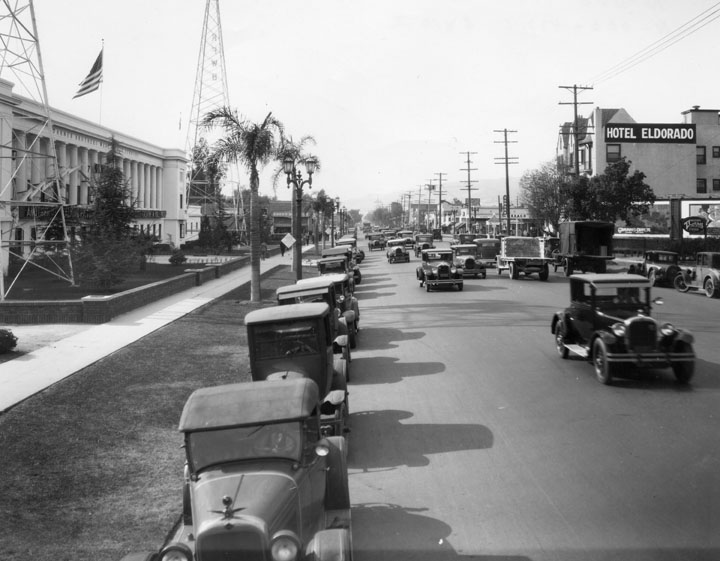 |
|
| (1930)* - Sunset Boulevard looking west from Van Ness. To the left is Warner Brothers West Coast Studios; to the right is the Hotel Eldorado, which was prviously the Hotel Iris . |
Historical Notes Warner Bros bought a majority interest in First National Pictures in 1928, consolidating its executive offices into that company’s 1926 Burbank lot after a $500,000 building program was completed in January 1930. Production followed over the hills shortly thereafter. While filming primarily occurred at the Burbank location, some shooting and phonograph recording continued at the Hollywood lot. In the 1930s, Termite Terrace, the animation production unit behind the Merrie Melodies and Looney Tunes cartoons operated out of the Warner Bros Hollywood studio. By the end of 1937, the Warner Bros had vacated their Hollywood home.***# |
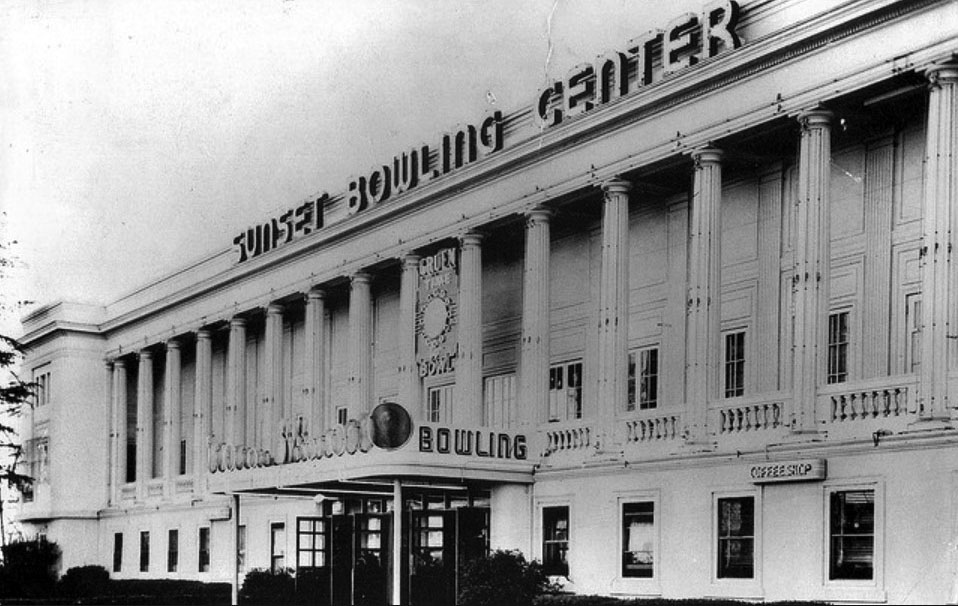 |
|
| (1937)^^** - View of the site of the filming of The Jazz Singer, the first feature film with synchronized sound. Converted to a bowling alley and sports center. |
Historical Notes In 1937, Sam Warner's brother-in-law, Harry Charnas, opened Sunset Bowling Center behind the old executive offices of Warner Bros. Studios. The Sunset Bowling Center was part of a "sports palace" that also contained badminton courts and a skating rink.* |
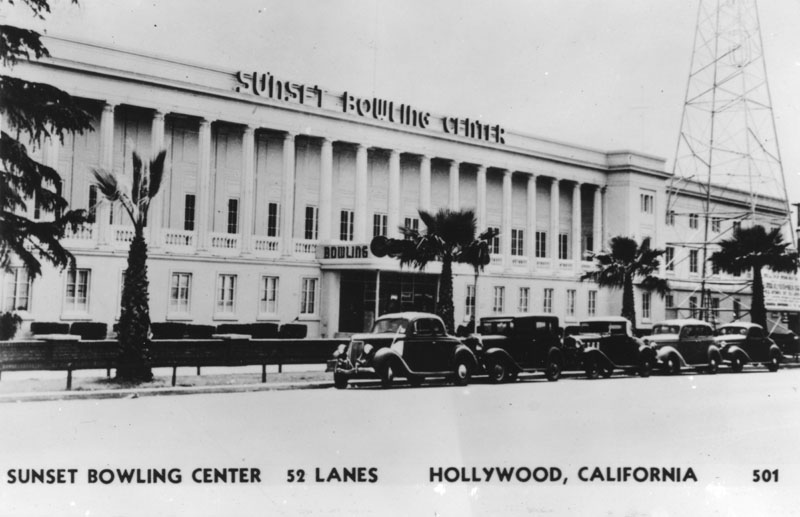 |
|
| (ca. 1941)* - Facade of the Sunset Bowling Center on Sunset Blvd. in Hollywood most likely taken during a bowling tournament held there in 1941. The 1922 building served as the West Coast headquarters of the Warner brothers, Harry, Albert, Sam, and Jack, until 1929. |
Historical Notes With 52 bowling lanes, the Sunset Bowling Center was the largest in the world at that time. Pin boys lived in the loft of the building. The bowling center operated for ten years.* |
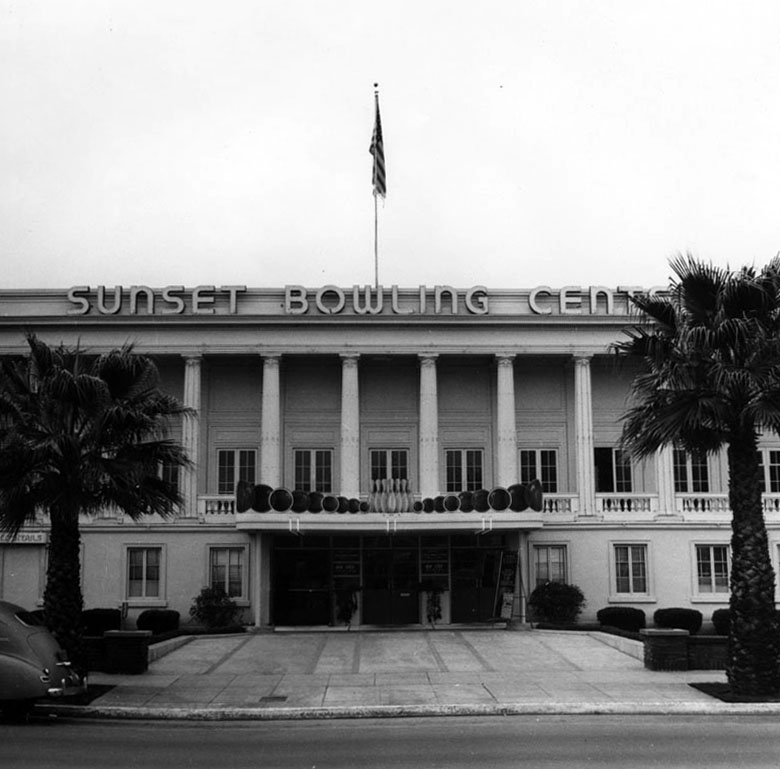 |
|
| (ca. 1940)* - Exterior view of neoclassical style Sunset Bowling Center, located at 5858 Sunset Boulevard in Hollywood. |
Historical Notes In 1954, Paramount bought the site to provide television production facilities for KTLA, which moved to the site in 1958. Gene Autry bought KTLA in 1964, and leased the space from Paramount for three years, after which he bought the property for a whopping $5 million dollars.* In June 1968, radio station KMPC, of which Autry was a principal owner since 1952, also moved to the site.***# |
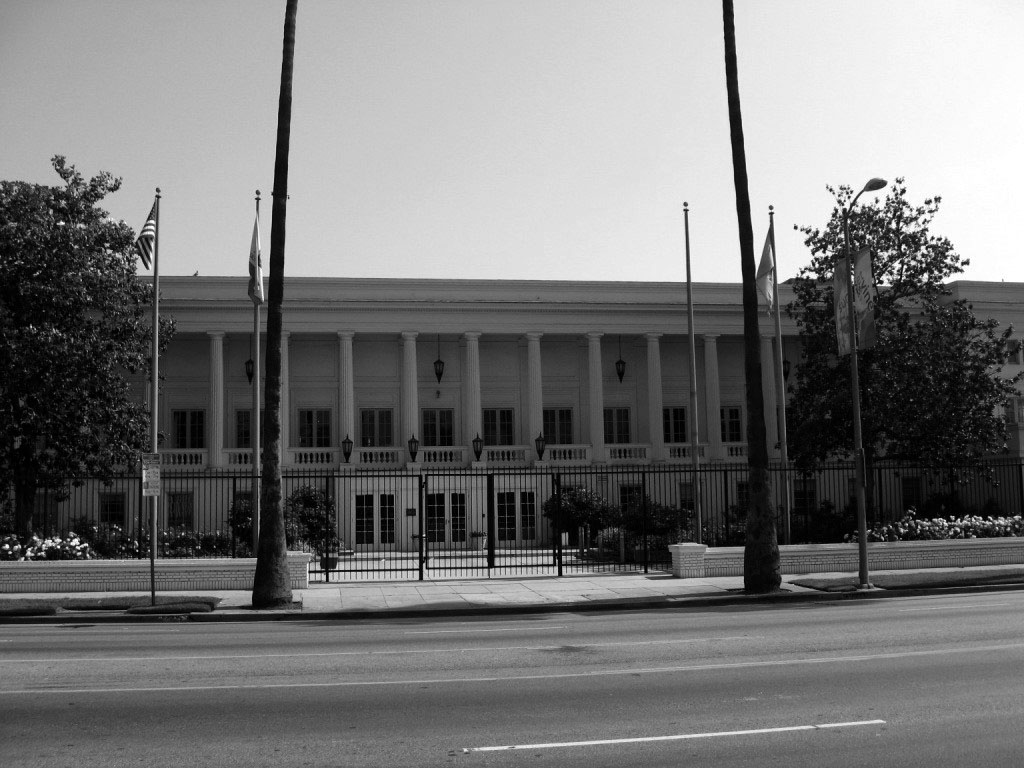 |
|
| (2008)^* - View of the Executive Office Building at the Old Warner Brothers Studio — on Sunset Boulevard, in Hollywood. It is officially called today Sunset Bronson Studios and also known as KTLA Studios and Tribune Studios. |
Historical Notes In 1982, an investment-banking firm bought the lot and KTLA, and three years later, sold out to the Tribune Company. In January of 2008, Hudson Capital purchased the landmark 1920s Warner Bros. Studio for an astounding $130 million dollars.* |
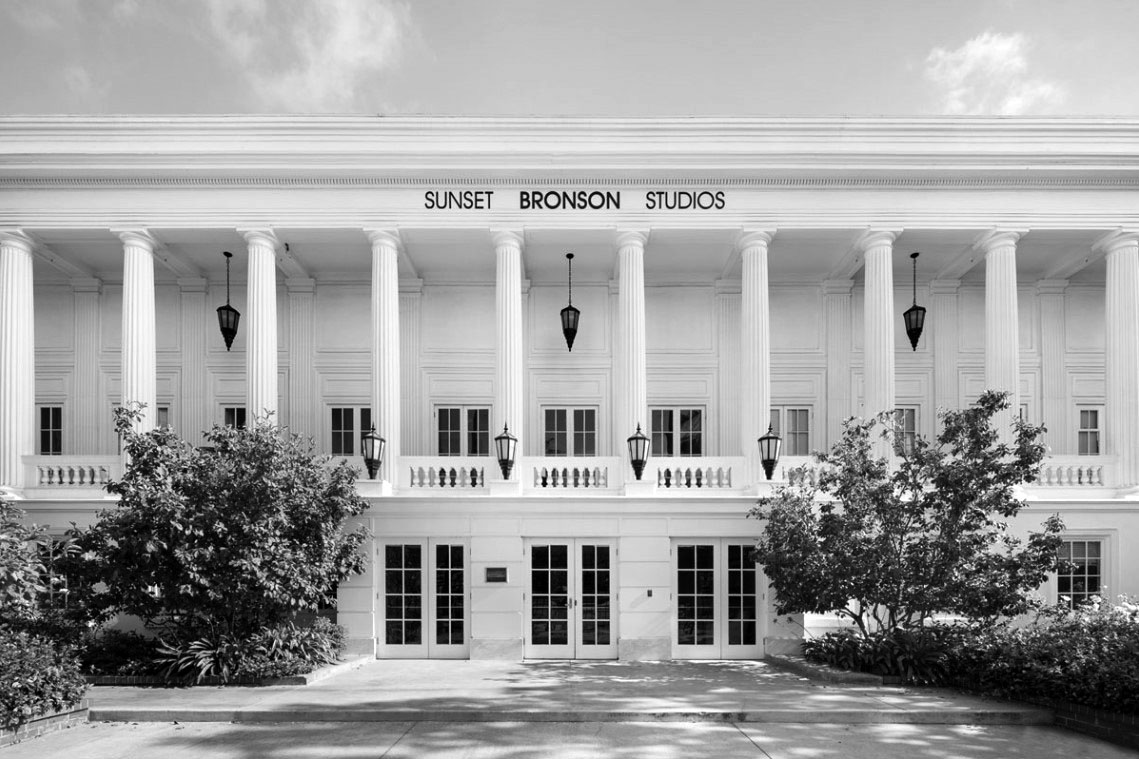 |
|
| (ca. 2014)###* - View of the Sunset Bronson Studios, also known as KTLA Studios and Tribune Studios. |
Historical Notes This beautiful building of classical design, which boasts of a big colonnade of Doric columns, was declared Historic-Cultural Monument No. 180 in 1977 by the city of Los Angeles (Click HERE to see complete listing). Being the "Site of the Filming of the First Talking Film”, the facilities were also listed on the National Register of Historic Places in 2002.^* |
* * * * * |
Castillo del Lago
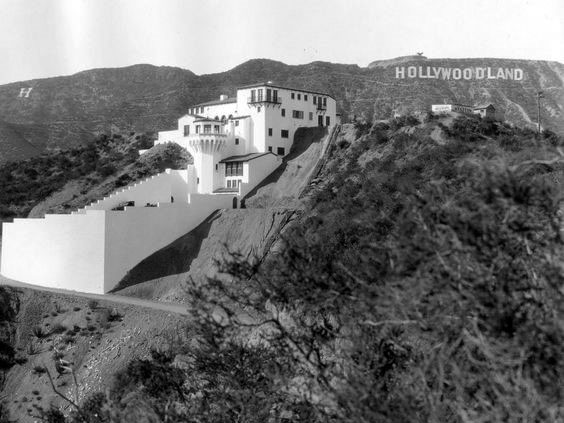 |
|
| (ca. 1926)^ - View showing the very large Mediterranean-style Castillo del Lago in the Hollywood Hills. The Hollywoodland Sign can be seen in the distance at upper-right. Another large letter H appears at upper-left. |
Historical Notes The Spanish colonial style castle called Castillo del Lago was built by oil baron Patrick Longden in Beachwood Canyon in 1926. It was designed by Architect John DeLario, the primary architect of the original Hollywoodland tract. |
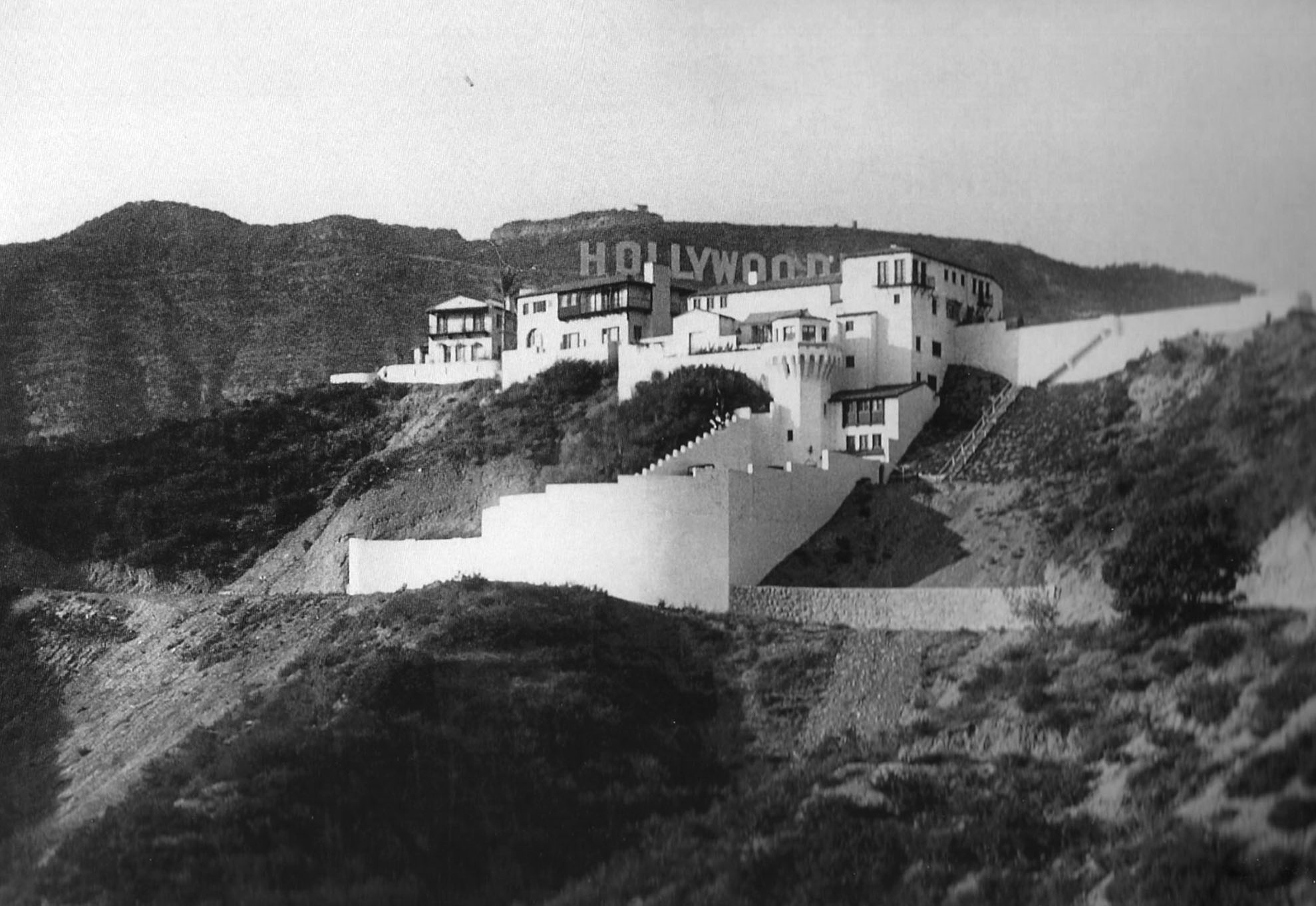 |
|
| (1926)^ – Closer view showing the magnificent Castillo del Lago with part of the Hollywoodland Sign visible behind it. |
Historical Notes At various times in its history, Castillo del Lago has been vacant, a white elephant during the Depression and beyond. Older adults who grew up in Beachwood tell stories of using it as a neighborhood clubhouse, entering through unlocked doors to play in the tower and on the stairs. * |
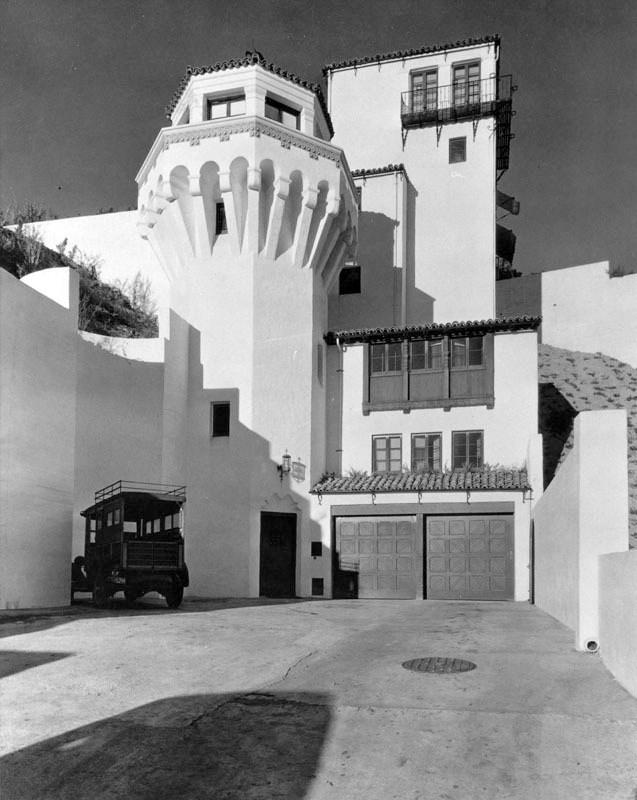 |
|
| (1926)* – Driveway leading to the garage of the Spanish Colornial style Castillo del Lago. |
Historical Notes In the late 1930’s, a newcomer to Beachwood leased the house: Benjamin “Bugsy” Siegel, the gangster best known for spearheading the post-war casino boom in Las Vegas. Though he later took up residence in Beverly Hills, Siegel apparently lived in Castillo del Lago for a time while running it as an illegal casino. (It was not a speakeasy, as many people have claimed, as Prohibition was repealed in 1933.)* |
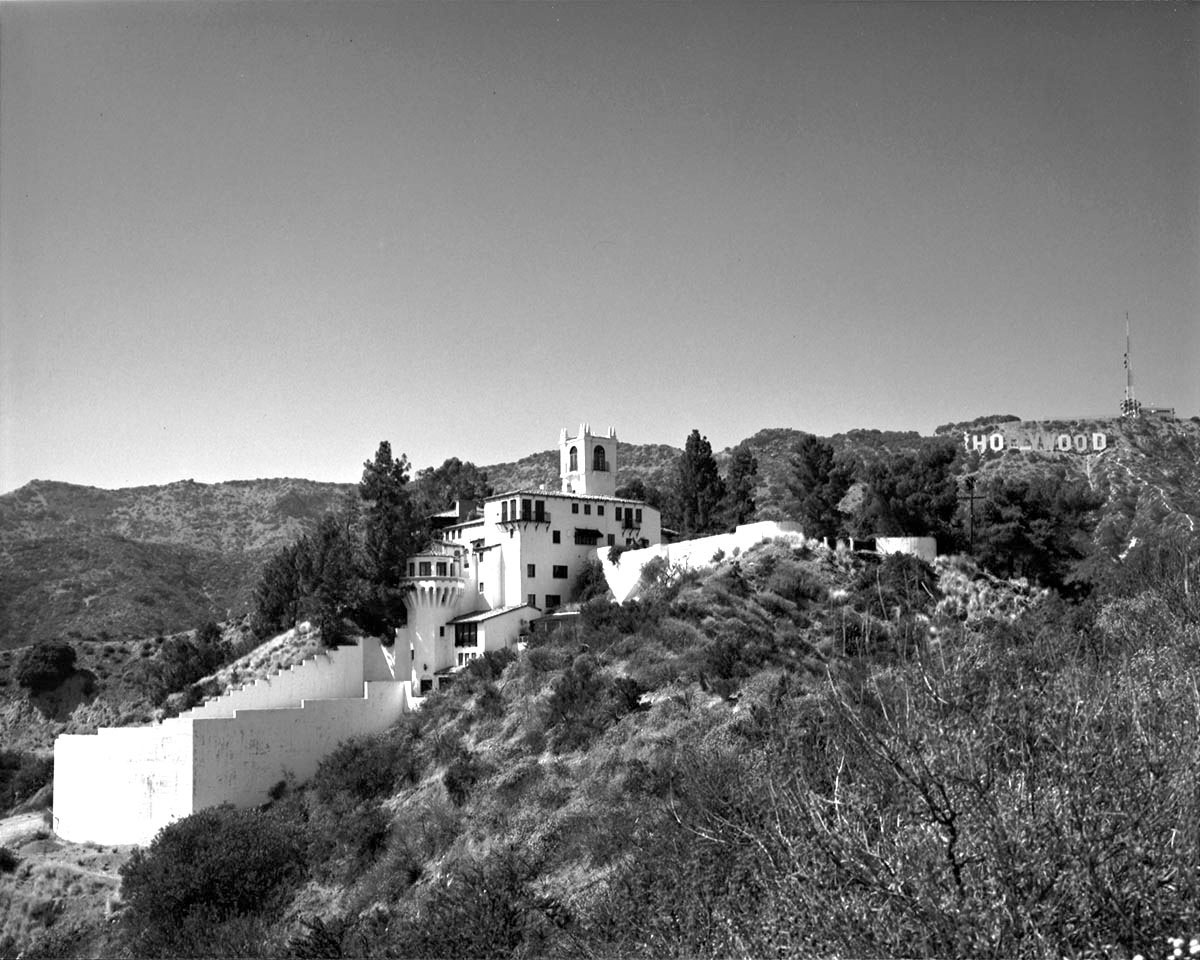 |
|
| (1980)* - Looking up the Hollywood Hills showing the John DeLario designed, Willfong House (aka Castillo del Lago). Photo by Julius Shulman |
Historical Notes In the 1950s, the house fell into a sad state of disrepair, was vandalized and, at one point, caught fire. The property eventually came under ownership by Baron Patrick de Selys–Longchamps who, lived on the property for a few years in un-restored condition. The Baron sold to a couple named Willfong who did over and did up the house and had it published in Architectural Digest. Records show that in 1990, the Willfongs sold to Richard Grossman and Lisa Lyons. The Grossman/Lyons in turn sold it to Madonna Ciccone in 1993.*^ |
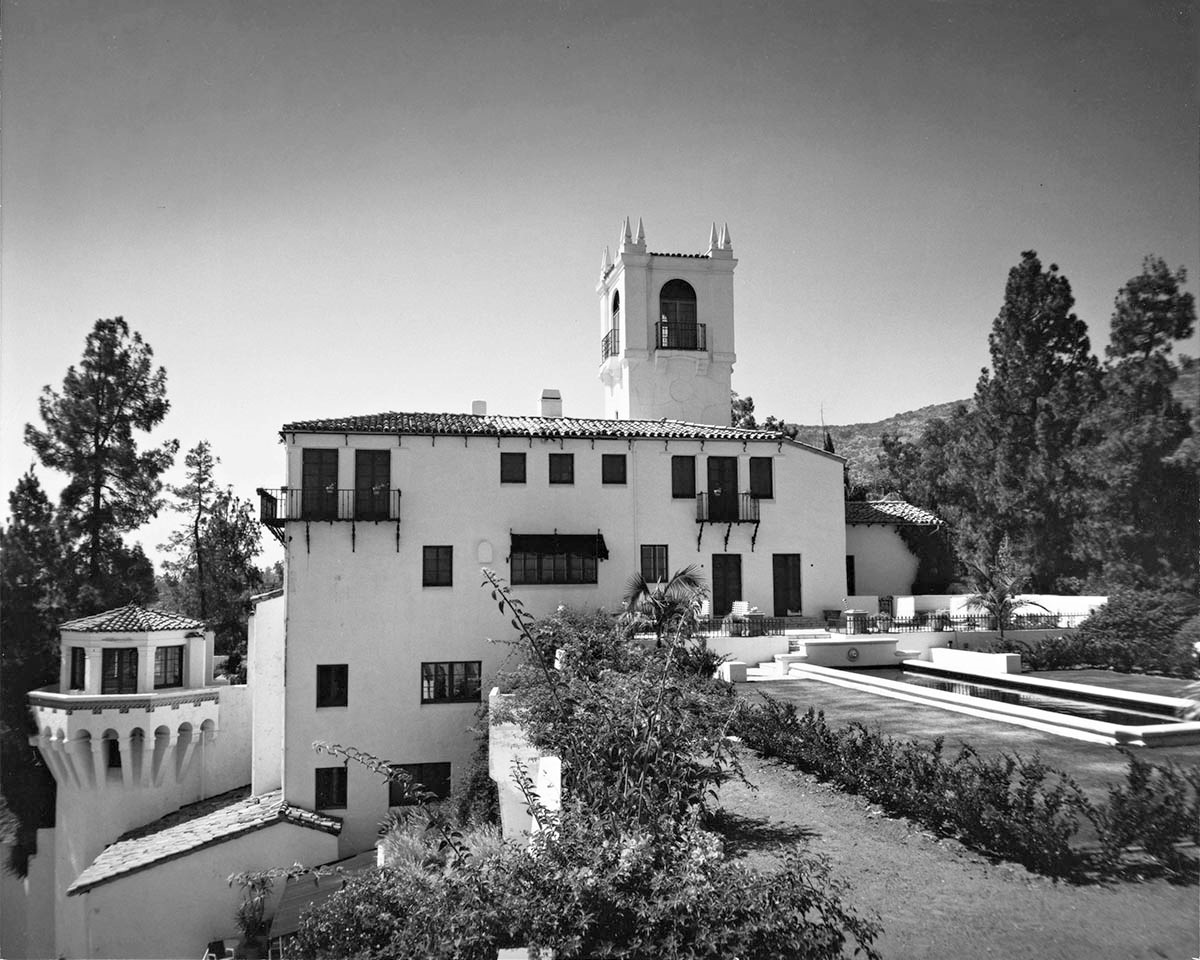 |
|
| (1980)* – View showing the nine-story, 8,000 square foot Castillo del Lago. Photo by Julius Shulman |
Historical Notes In 1993, Madonna bought Castillo del Lago for $5 million. Soon after buying the mansion, Madonna undertook a renovation that cost $3 million and transformed the house from Spanish Colonial to Italianate. (The renovation still irks her neighbors, who claimed she “ruined” the house by painting the wall and replacing the original tiles with cheaper ones.) |
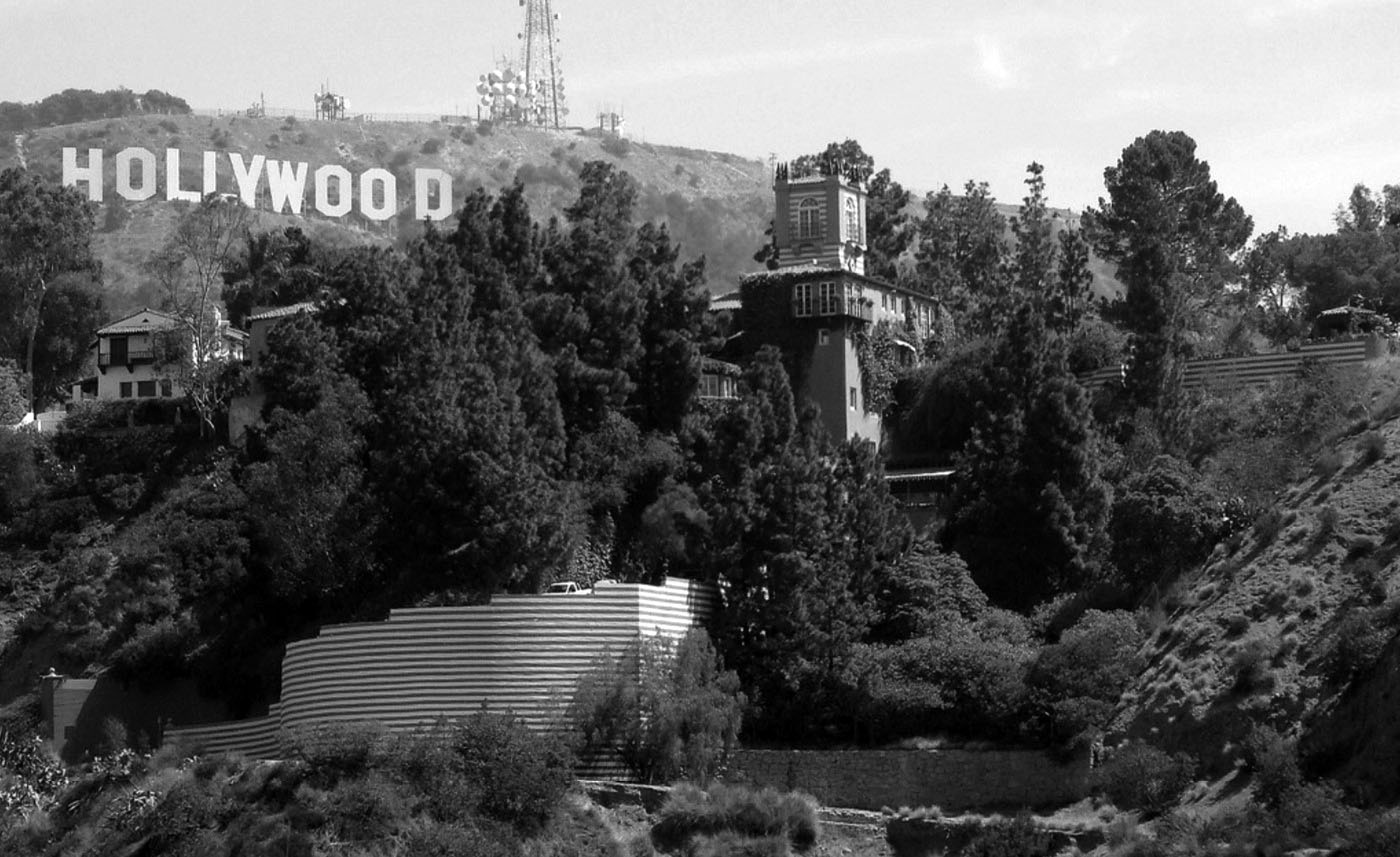 |
|
| (2007)^ - Hollywood Sign behind Madonna's old home, Castillo del Lago, after renovation. located at 6342 Mulholland Drive. Photo by Jeremiah Christopher. |
Historical Notes In 1997, Madonna sold Castillo del Lago at a huge loss to Joe Pytka, the commercial director and restaurant owner (of Bastide, now defunct). Pytka, who bought the house for $5.3 million, listed it last year for $14.95 million after an extensive renovation of his own. (In addition to creating a new kitchen and master suite, he upgraded Madonna’s tilework.)* |
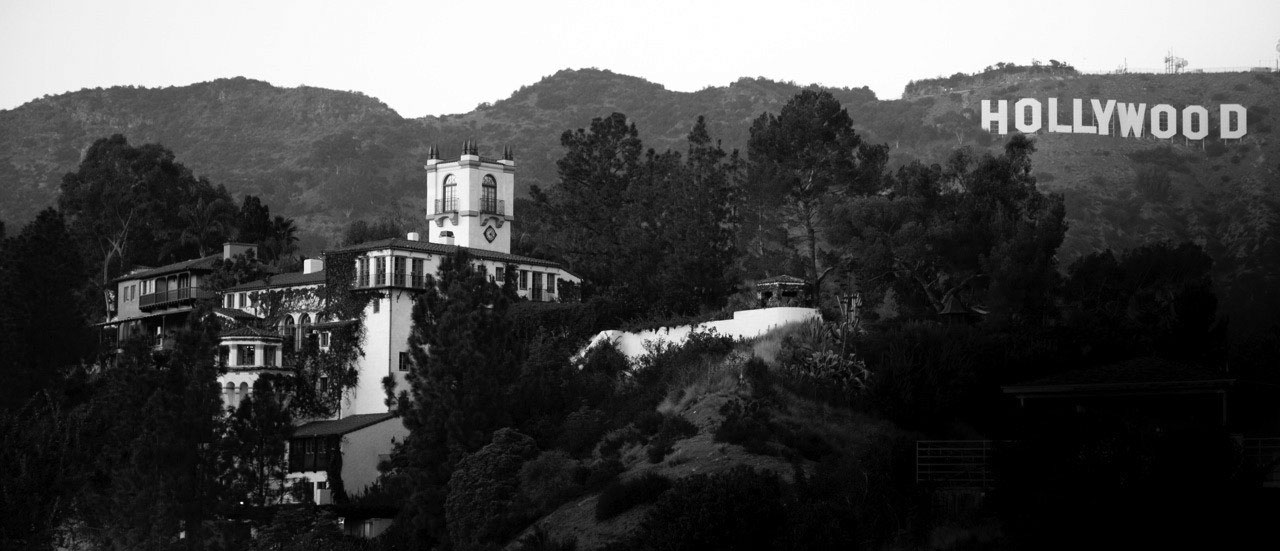 |
|
| (2012)^ – Panoramic view of the Castillo del Lago mansion located at 6342 Mulholland Drive, with the Hollywood Sign in the background. |
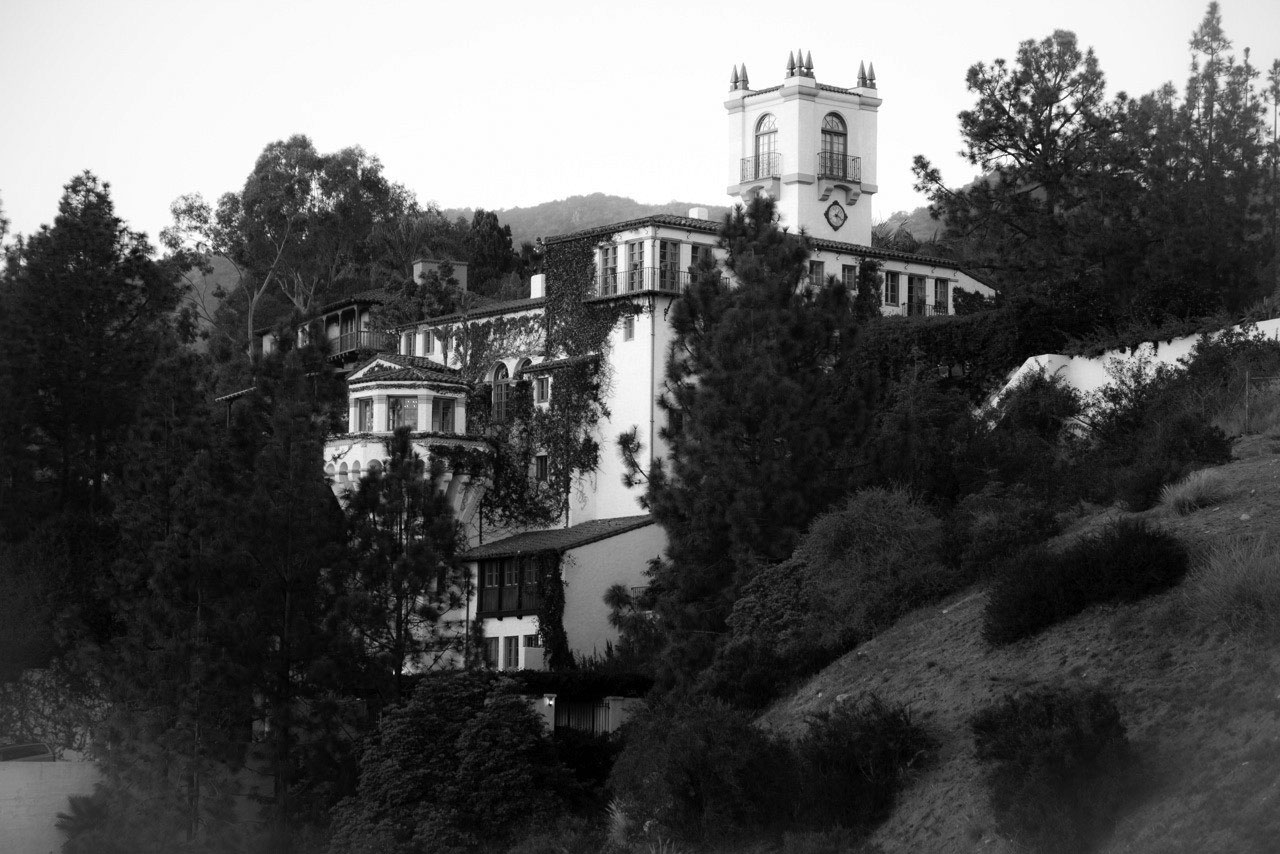 |
|
| (2012)^ – Close-up view of Castillo del Lago in the Hollywood Hills. |
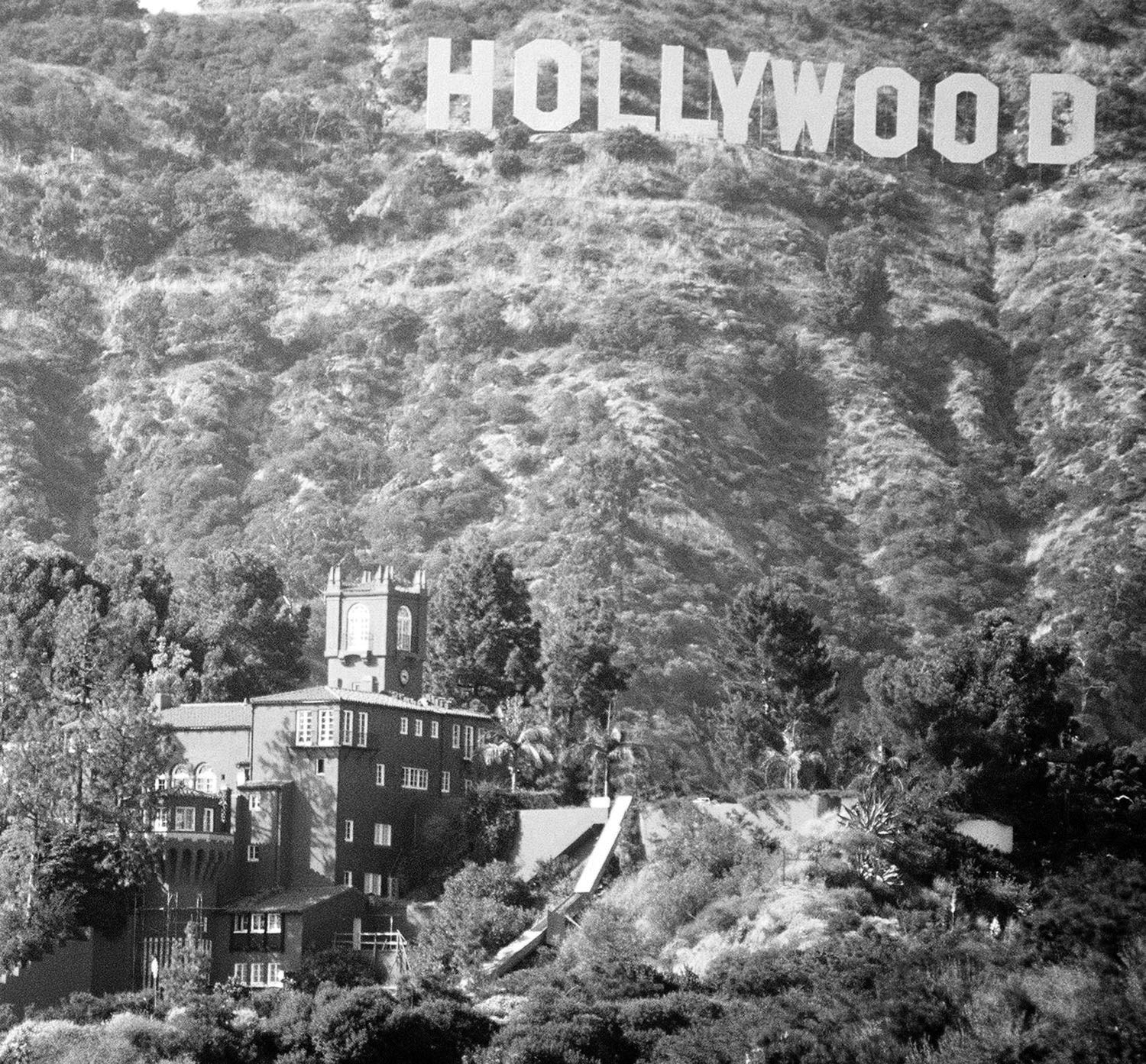 |
|
| (2018)*– The Castillo del Lago with the Hollywood Sign in the background as it appears today. |
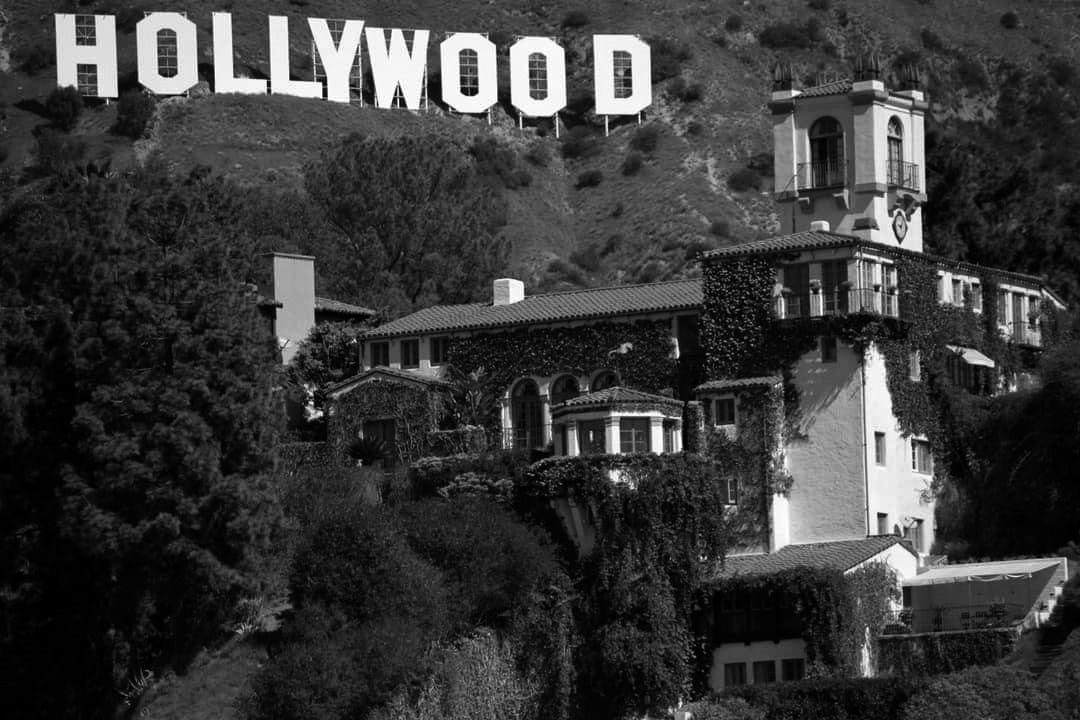 |
|
| (2019)^ - Closer view of Castillo del Lago with the Hollywood Sign perched on the hills behind it. Photo by Brady Hunsberger |
* * * * * |
First Presbyterian Church of Hollywood
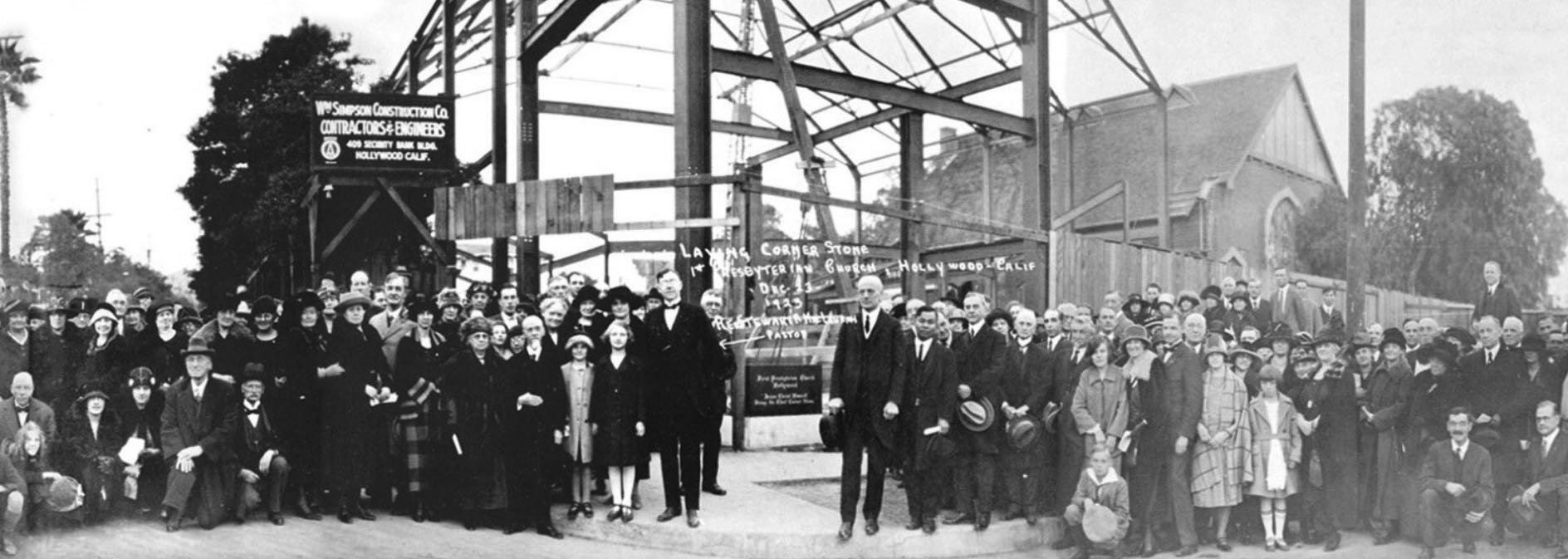 |
|
| (1923)* – Laying of Cornerstone Ceremony at the First Persbyterian Church in Hollywood, 1760 N. Gower Street. |
Historical Notes The church was founded in 1903. A large brick gothic sanctuary was built in 1923, and seats 1,800, with a balcony on both sides and in the back. ^ |
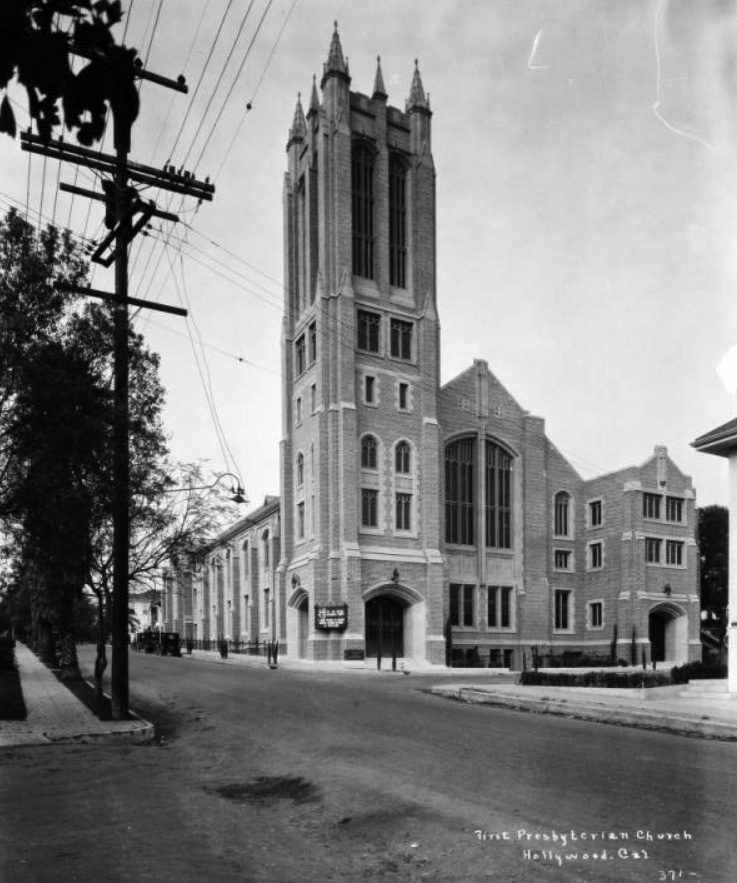 |
|
| (ca. 1926)^^- View looking up an unpaved Gower Street showing the First Presbyterian Church of Hollywood located on the northeast corner of Gower and Carlos Ave. |
Historical Notes The church campus covers a full square block on Gower Street, one block north of Hollywood Boulevard and three blocks from the legendary intersection of Hollywood and Vine.^ |
 |
|
| (2015)^*– View showing the First Presbyterian Church of Hollywood located at 1760 N Gower Street. |
Historical Notes Dedicated on November 16, 1924, the First Presbyterian Church of Hollywood immediately became one of the area’s most notable landmarks and one of its most popular churches with attendees coming not just from Hollywood but surrounding communities as well. In fact, by the 1960’s the church had grown to become the largest Presbyterian church in the world with a congregation exceeding 8,000 with nationally/internationally known pastors at its head. One of the best known, Dr. Lloyd Ogilvie, left the church in 1995 to become Chaplain of the United States Senate. Ogilvie was the second former pastor from Hollywood Presbyterian to be accorded the honor, the first being Dr. Richard C. Halverson. By 2013, however, the congregation had fallen to 1,036.^ |
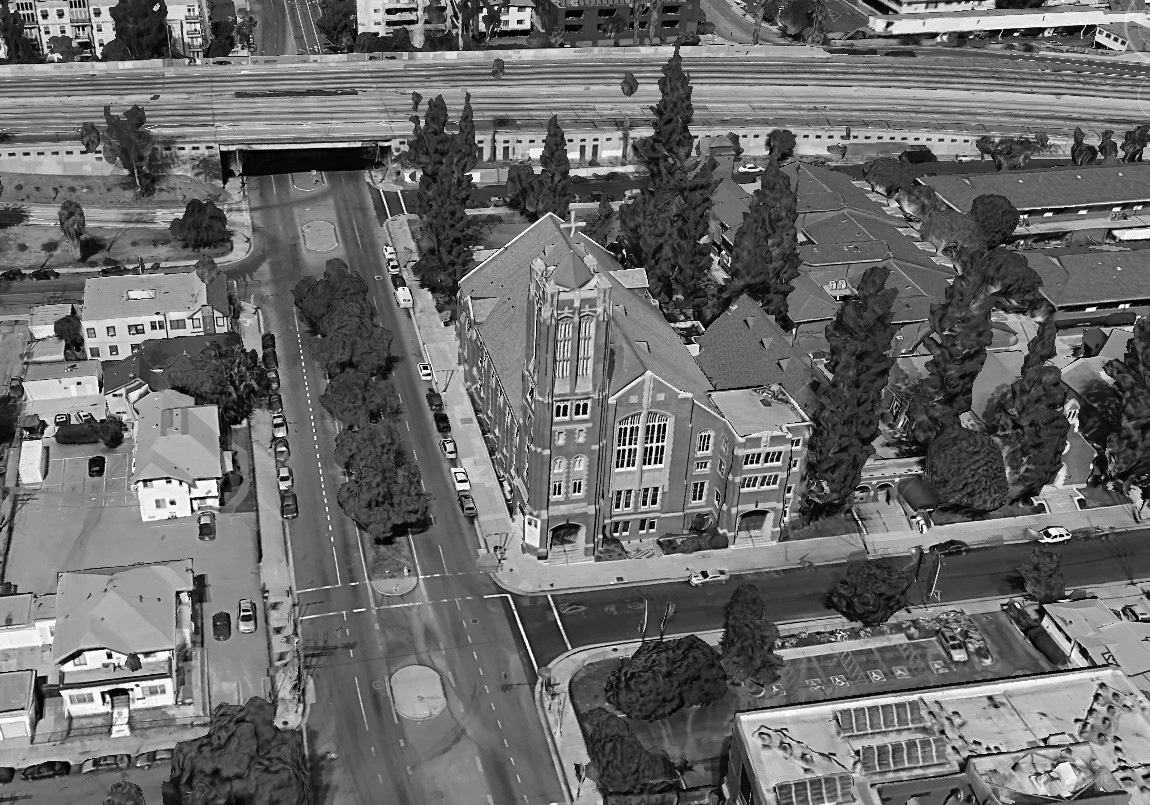 |
|
| (2015)* – Google Earth View showing the Hollywood Presbyterian Church located on the northeast corner of Gower Street and Carlos Avenue with the Hollywood Freeway in the background. |
Historical Notes The church drew congregants from an area much larger than the Hollywood community, taking advantage of its access to the Los Angeles freeway system (the church is located one block south of the Gower Street exit from the Hollywood Freeway).^ The First Presbyterian Church of Hollywood remains one of Hollywood’s most visible, beautiful and historic landmarks. |
Click HERE to see more in Early Views of Hollywood (1920 +) |
* * * * * |
Please Support Our CauseWater and Power Associates, Inc. is a non-profit, public service organization dedicated to preserving historical records and photos. We are of the belief that this information should be made available to everyone—for free, without restriction, without limitation and without advertisements. Your generosity allows us to continue to disseminate knowledge of the rich and diverse multicultural history of the greater Los Angeles area; to serve as a resource of historical information; and to assist in the preservation of the city's historic records.
|
For more Historical Los Angeles Views click one of the following:
For Other Historical Views click one of the following:
See Our Newest Sections:
To see how Water and Electricity shaped the history of Los Angeles click one of the following:
Water:
Power:
* * * * * |
References and Credits
* LA Public Library Image Archive
**DWP - LA Public Library Image Archive
*^Oviatt Library Digital Archives
^^ Daily Breeze: Los Angeles Motordome
*# LA Times: Hollywood Castles and Curious Cures; Olympic Auditorium History; The Ennis House; Bob Hope Patriotic Hall reopens in L.A.
#**Themerica.org: Tam O'Shanter Inn
#++Mattconstruction.com: The Ennis House
#^*Huntington Digital Library Archive
^*#California State Library Image Archive
^+^Bob Hope Patriotic Hall Renovation
+##RolandCommunications.com: Tam O'Shanter
++#Movie Palaces: Beverly Theater
^^*Early Downtown Los Angeles - Cory Stargel, Sarah Stargel
^^+Fightland: Fight Night at the Olympic
**#Noirish Los Angeles - forum.skyscraperpage.com; Elks Building - Horthos; Tam O'Shanter Inn; Garden Court Apartments; Angelus Temple; Coliseum Construction
**^Historical LA Theatres: The Philharmonic Auditorium; Downtown Theatres; Mason Theatre; Loew's State Theatre; Metropolitan/Paramount Theatre; Biltmore Theater
*^#Publicartinla.com - Bovard Hall
*##Curbed LA: California Broadway Trade Center
^^#CSULB - A Visit to Old LA: Hamburger Dept. Store
***Los Angeles Historic - Cultural Monuments Listing
*^*California Historical Landmarks Listing (Los Angeles)
*^^Nuestra Señora la Reina de los Ángeles: losangelespast.com
*^*^UCLA Libraries Special Collection: Pico House Courtyard
*^^*Pacific Eelecfric in San Pedro/Wilmington
^^**Flickr.com: Floyd Bariscale - Sunset Bowling Center
^^++Facebook.com - Pasadena Digital History
^^^*Cinema Treasures: Metropolitan/Paramount Theatre
^*^*Los Angeles Past: The Oldest Building in Los Angeles; Temple and Main Streets, Los Angeles - Then and Now
^*#*Los Angeles Memorial Coliseum and Sports Arena
^*^#Facebook.com - Bizarre Los Angeles
***#Big Orange: Los Angeles Stock Exchange Building; Warner Bros; Saint Vincent de Paul Church
**^#Vintage Los Angeles - Facebook.com: Bernheimer Japanese Mansion; Masonic Temple
^#**A Brief Egyptian Theatre History
^##*Los Angeles Fire Department Historical Archive
#**^Pinterest - Mid Century Hollywood
#*#*Fairfax High School Home Page
#*#^Flickr.com: Wilshire Boulevard History
#^*#Los Angeles Conservancy: Junipero Serra State Office Building; The Ennis House; Bob Hope Patriotic Hall; Talmadge Apartments; Wilshire United Methodist Church
#^*^Facebook.com: Photos of Los Angeles
#^#^Weird California: Los Angeles' Programmatic Architecture
*###The Story of Hollywood by Gregory Paul Williams
^^##Metropolitan Transportation Library and Archive: Hill St. Station; Subway Terminal Building
###*Sunset Bronson Studios: Hudson Pacific Properties
###+Reinventing Broadway Street: Los Angeles’ Architectural Reincarnation by Marques Vickers
##^*Facebook.com: Classic Hollywood-Los Angeles-SFV
#^^*Google Maps
#***Flickr.com: Old Los Angeles Postcards
^***^Facebook.com: Garden of Allah Novels
^* Wikipedia: Leonis Adobe; Occidental College; Beverly Hills; Beverly Hills Hotel; Huntington Hotel; Bank of Italy; Van de Kamp's Holland Dutch Bakeries; Rose Bowl Stadium; Los Angeles Memorial Coliseum; Farmers and Merchants Bank of Los Angeles; Los Angeles Biltmore Hotel; Jonathan Club; Los Angeles Plaza Historic District; St. Vincent Church; The Benevolent and Protective Order of Elks; Park Plaza Hotel; YMCA; San Pedro; Venice; Subway Terminal Building; St. Vincent Hospital; Los Angeles Herald-Examiner; Cahuenga Branch Library; Foy House; Frederick Hastings Rindge House; Los Angeles High School; MGM; Breed Street Shul; Natural History Museum of Los Angeles County; Jonathan Temple; Highland Park Masonic Temple; Egyptian Theatre; Phineas Banning; Eagle Rock; Hollywood Masonic Temple; Sawtelle Veterans Home; Downtown, Los Angeles; Los Angeles Philharmonic; Subway Terminal Building; Hollywood Athletic Club; Pío Pico; Los Angeles Plaza Historic District; Jonathan Temple; Charles Clarke Chapman; Los Angeles Stock Exchange; Park Plaza Hotel (Los Angeles); Broadway Theater District: Lowe's State Theater; Obadiah J. Barker; Leslie Brand; Ben Bernie; Ambassador Hotel; Tam O'Shanter Inn; Garden Court Apartments; George L. Crenshaw; St. Vincent's Medical Center; Fairfax High School; Old Warner Bros. Studio; Hollyhock House; Hollywood Bowl; Angelus Temple; Aimee Semple McPherson; Vista Theatre; Grand Olympic Auditorium
< Back
Menu
- Home
- Mission
- Museum
- Major Efforts
- Recent Newsletters
- Historical Op Ed Pieces
- Board Officers and Directors
- Mulholland/McCarthy Service Awards
- Positions on Owens Valley and the City of Los Angeles Issues
- Legislative Positions on
Water Issues
- Legislative Positions on
Energy Issues
- Membership
- Contact Us
- Search Index